The STAR TREK Franchise’s Greatest Villains, Ranked
As a franchise, Star Trek has more “misunderstood antagonists” than outright villains. Often, the Federation just has misunderstandings with other alien species. But there is some outright villainy in the far future. And some of the most legendary antagonists in sci-fi history came from this franchise. These Star Trek villains hail from The Original Series, from The Next Generation , from Voyager , from Discovery , and everything in between. They come from the big and small screens. But one thing they all have in common is the villainous delight they brought to fans. Here are 13 of the very best (or rather, very worst) Star Trek villains over the last 55 years , ranked.

13. Seska ( Voyager , 1995-1996)

Star Trek: Voyager had few great villains, outside of the Borg Queen. The other alien races they fought, like the Hirogen, didn’t have memorable leaders. But the best villain in this Star Trek series was an actual crew member. Seska (Martha Hackett) was one of the rebel Maquis who Janeway took in, who became Voyager crew members when the ship got lost in the Delta Quadrant . But we later learn that she was a Cardassian spy, surgically altered to look Bajoran to infiltrate the Maquis. Later trapped aboard Voyager , she caused all kinds of problems for Janeway’s crew. Including siding with hostile alien races against her crewmates.
12: Harry Mudd (TOS, 1966-1967, The Animated Series 1973, Discovery 2018)

The original series had several memorable antagonists, but almost all were mostly one-offs that never returned. The grand exception to that rule was Harcourt Fenton Mudd , or just Harry Mudd. A space pirate and swindler, actor Roger C. Carmel played him like a 17th-century salty sea pirate. Only one who captains a space freighter used for smuggling and other nefarious purposes.
Harry Mudd appeared three times to plague Kirk and his crew. In the first season’s “ Mudd’s Women ,” we learn that underneath his jolly exterior is an opportunist, drug dealer, and pimp. And in the more lighthearted “ I, Mudd ,” he was still someone willing to kill. He even appeared on the animated series. A more sinister version of him played by Rainn Wilson showed up on Discovery. But the best is still the original. And he is one of the best Star Trek villains out there.
11. Nero ( Star Trek 2009)

Because of the success of Ricardo Montalban’s Khan, many Star Trek movies attempted to follow in the “vengeance-driven madman” template for their main bad guy. And most, like Shinzon in Star Trek: Nemesis , failed to live up to Khan. But Star Trek 2009’s villain, Romulan Commander Nero came closest. After a supernova destroyed his homeworld , resulting in his wife’s death, he blamed Ambassador Spock for failing to prevent it as promised.
So what does Nero do? The bitter Romulan traveled back in time with one mission — to make Spock suffer as he suffered. Well, since he destroyed his entire home planet of Vulcan, we say he made good on that promise. We admit he’s a bit one-note, but Eric Bana is just great in the role and chews all the available scenery. And this raised him to truly memorable status.
10. The Duras Sisters ( The Next Generation 1991-1994, Deep Space Nine 1993, Star Trek: Generations 1994)

One highlight of TNG was a long-running Worf-centric arc, dealing with his family’s Klingon political rivals, House Duras. The first member of House Duras we met was a man, a braggart and idiot , who met his death at Worf’s blade. But his two sisters, Lursa and B’etor, played by Barbara March and Gwynyth Walsh, respectively, were much more interesting and fun on screen.
Conniving schemers, the Duras sisters sought to control the Klingon Empire by any means possible. And the fact that women couldn’t rule on the High Council didn’t stop them from trying. They also get extra points for being the ones who destroyed the Enterprise -D in the film Star Trek: Generations . Although these Star Trek villains but a few minutes themselves after that. The Duras sister lived by the sword, and died by the sword.
9. Captain Gabriel Lorca ( Discovery 2017-2018)

In the first season of Star Trek: Discovery , the titular ship’s Captain was a rough-around-the-edges jerk named Gabriel Lorca. Jason Isaacs, who played malicious men in the Harry Potter franchise and in Star Wars: Rebels , portrayed Lorca . So really, we should have known from the get-go that Lorca wasn’t just a jerk, but an actual bad guy. We eventually discovered that he hailed from the Mirror Universe , where all the Federation’s counterparts are basically terrible people. We hated Lorca as Captain, but we kind of loved him as an outright bad guy.
8. The Borg Queen ( Star Trek: First Contact 1996, Voyager 1991-2001, Picard 2022)

In Star Trek: The Next Generation , the franchise introduced the Borg Collective as a cybernetic hive mind, with no individual personalities among them. But when it came time to do the film Star Trek: First Contact , the creative team knew the Borg needed a face. (And a torso. And sometimes, legs). So since the Borg is like a beehive, wouldn’t it have a Queen?
In First Contact , she attempted to assimilate Earth in the past, and bring both Data and Picard to the dark side (to borrow a phrase). The Borg Queen could’ve taken away the collective’s singular scariness, but because of Alice Krige’s performance and weird sensuality, she became a fan favorite . The character later antagonized Voyager , and Annie Wersching currently portrays her on Picard .
7. Q ( TNG, DS9, Voyager , 1987-2001, Picard 2022)

The omnipotent entity from the Q Continuum , played by John de Lancie, Q evolved from a Star Trek villain into more of a nuisance. But that’s not how he started. First appearing on Star Trek: The Next Generation ’s pilot episode, he forced Picard to stand trial for the crimes of humanity. Other encounters saw him creating wild fantasy scenarios for the Enterprise crew , and currently, changing Earth’s past to create a dystopian present. But he gets to keep villain status for one reason. In an act of pure pettiness, he introduced the lethal Borg to the Federation, centuries too early. And thousands died as a result. That’s pretty villainous to us.
6. Weyoun ( Deep Space Nine , 1995-1999)

The biggest threat to peace on Star Trek: Deep Space Nine was the Dominion , a sort of anti-Federation from the other side of the Galaxy. Although the leaders of the Dominion were its shape-shifting Founders , the face of this empire was the alien race called the Vorta . And the conniving Vorta we saw most on DS9 was Weyoun, played by Jeffrey Combs.
Combs played the characters as if he were a used car salesman. A used car salesman with an army of genetically engineered soldiers at his disposal, mind you. As a clone (as all his species are), even when they killed off this Star Trek villain, he’d just return as an identical version. Weyoun appeared 24 times total on Deep Space Nine , as six different clone variants. He was like a rash that Captain Sisko just couldn’t get rid of. And DS9 viewers were thankful for it.
5. Kruge ( Star Trek III: The Search for Spock , 1984)

In the original Star Trek TV series, the Klingons were a lot of posturing and bluster. But they rarely did anything that was too bad. The true template for Klingon badassery was set by Doc Brown himself, Christopher Lloyd, in Star Trek III: The Search for Spock . As a Klingon Bird of Prey commander named Kruge, he was obsessed with uncovering the secrets of the newly-created Genesis planet for his own ends, and for the glory of the Klingon Empire.
In just this one film, we saw Kruge coldly kill his lover Valkris for seeing classified information, as well as one of his own officers for screwing up on the bridge. And not just killed, but totally vaporized. He also destroyed a Federation starship and had one of his own officers murder Captain Kirk’s son just to prove a point to his adversary. Christopher Lloyd absolutely set the tone for what Klingons were in the franchise going forward with this performance. And that’s why this Star Trek baddie sits so high on our ranked villains list.
4. Kai Winn Adami ( Deep Space Nine , 1993-1999)

As we know from the real world, religious fundamentalists are scary. And when they gain political power? They are even scarier. Such is the case with Kai Winn , played by Oscar-winner Louise Fletcher . They introduced us to her as a Bajoran Vedek (priest) in season one of Deep Space Nine . She first appeared as a religious zealot who tried to divide the Federation from the Bajorans.
But those ambitions were not enough for Winn. She soon clawed her way to the top, becoming her planet’s supreme religious figure. Winn said everything with a condescending smile, one that just makes you love to hate her. And as the series progressed, we learned that her so-called faith is just a smokescreen for her desire for power and control. Although the writers gave her layers, she was nevertheless one of Star Trek’s most ruthless villains.
3. General Chang ( Star Trek VI: The Undiscovered Country , 1991)

The second-best cinematic villain in the Star Trek franchise was played by the great Christopher Plummer , in the original crew’s final outing together, The Undiscovered Country . When the Klingon and Federation have to make a peace after a tragedy befalls the Klingon homeworld, not everyone in the Empire wants to make friends with their longtime enemies.
At the front of that line was Chang , a Klingon general who loved to quote Shakespeare and who hid all his animosity behind a wry smile. An old warhorse who was not prepared for a peaceful future, he was even willing to work with his enemies to ensure a lasting peace never occurs. He may have made only one appearance in one film, but it sure was one for the ages. Not to mention, we love a villain who wears a great-looking sash.
2. Khan Noonien Singh ( Star Trek 1967, Star Trek II: The Wrath of Khan 1982)

Ricardo Montalban originally played the part of a 20th century genetically engineered tyrant named Khan Noonien Singh in the 1967 episode “ Space Seed .” Despite a great performance, if it was only that one episode, he would likely not be on this Star Trek villains list, much less rank this high. No, it was his return 15 years later as a vengeance-driven madman in Star Trek II: The Wrath of Khan that really makes him one of the all-time greats.
When Star Trek combined believable motivation, top-tier acting, and forever memorable lines (“Vengeance is a dish best served cold”), it made an unbeatable mix. The combination makes him the best big-screen Trek villain of all time. Everyone else in the film series pales in comparison. Especially the other Khan, Benedict Cumberbatch, who played the character (in name only) in Star Trek Into Darkness. He does not make it onto our Star Trek villains rankings.
1. Gul Dukat ( Deep Space Nine , 1993-1999)

No Star Trek villain was as complicated, layered, and outright evil as the Cardassian war criminal Gul Dukat . As the commandant of Terok Nor , the space station later called Deep Space Nine , he oversaw the occupation and subjugation of the planet Bajor. His rule saw millions of Bajorans die in labor camps, and deal with untold suffering. And when he lost the planet, he became bitterly obsessed with getting his old position back as its brutal overseer.
Although veteran actor Marc Alaimo played the part dripping with ego and evil, he also gave Dukat layers. Among those layers was his genuine caring for his half-Bajoran daughter . But DS9 never let you forget, no matter how much we might occasionally sympathize with him, this was one bad dude. As a recurring villain throughout the seven-season run of DS9 , no Trek antagonist was ever allowed more to work with, or delivered it all so well.
YOU MIGHT ALSO LIKE...
- Privacy Policy
- Do Not Sell or Share My Information Opens in new tab
v2.08 – © Nerdist All Rights Reserved
15 Greatest Star Trek Villains Of All Time, Ranked

Your changes have been saved
Email is sent
Email has already been sent
Please verify your email address.
You’ve reached your account maximum for followed topics.
The Star Trek universe has grown by leaps and bounds since the first episode aired on September 8, 1966. The fan-favorite series is famous for depicting a future where mankind has come to find peace. Humanity now traveled the stars seeking new life and new civilizations. Star Trek has given the world of pop culture quite a few different heroes. Star Trek is nearly 60 years old, and the science fiction saga created by Gene Roddenberry only lasted this long because of its heroes.
With Star Trek , its villains are often mere ideas, misunderstood alien creatures, or entire races created as a metaphorical allegory. Still, Captain Kirk, Spock, Jean-Luc Picard, or Seven of Nine transcend even their own heroic status when they come face-to-face with a real villain. From Khan Noonien Singh to the nameless Borg, Star Trek 's villains may not be as iconic as that other space franchise, but they nonetheless stand apart from the typical threat to the United Federation of Planets . While not every villain has stood out over time, some have become as well-known as Captain Kirk and Mr. Spock. These are the villains that have left an impression not only in the Star Trek universe but in pop culture as a whole. They are presented in chronological order based on their first appearance in the franchise.
Updated on December 30, 2023, by Robert Vaux: The article has been updated to include details on each character and when they appeared in the franchise. The entries have also been reorganized to better rank each villain accordingly.
15 Gary Mitchell Tried To Turn The Captain Kirk Against His Crew
The 30 most powerful star trek species, ranked.
Star Trek extends across a vast universe and many timelines filled with powerful, and often dangerous, alien species, like the Borg and the Moopsy.
Gary Mitchell appeared in one of the most memorable episodes of Star Trek: TOS . He started as a close friend of Captain Kirk and the ship's navigator for the USS Enterprise . However, the Galactic Barrier irradiated Mitchell, and he gained supernatural powers. Gary's powers continued to intensify, and as he grew more powerful, he became less human.
Gary Mitchell lost all connection to his humanity, and he put the crew of the Enterprise at risk. He tried to force Captain Kirk to do the one thing no good leader ever wants to do; kill his own crewmate. Gary Mitchell set the standard for what made a good Star Trek villain. He was a character fans rooted against even as they felt for him. This episode was the second pilot for Star Trek: The Original Series . While Captain James T. Kirk proved to be the hero NBC wanted, he needed Gary Mitchell to show them why.
14 The Romulan Star Empire Attacked From The Shadows
While the Romulans have never been given the same standing in pop culture as the Klingons, they are arguably even more villainous. The Earth-Romulan War led to the creation of the United Federation of Planets. The secretive Romulans were so elusive that no one saw their faces for over a hundred years. While there have been many dangerous individual Romulans, like Nero, perhaps the most sinister was Picard 's Narek. A member of the Zhat Vash, hidden within the Tal Shiar "secret police," he used kindness and empathy as his weapon against Soji Asha, the "daughter" of Star Trek: TNG 's Data.
When Romulans first showed up in The Original Series , it shocked everyone to learn that they looked just like Vulcans. The Romulans were an offshoot of the Vulcan race from millennia before the series. They refused to bury their feelings and become purely logical beings, which led them to establish their own society. By the time of the 32nd Century, however, the Vulcans and Romulans reunited thanks to Spock's efforts.
13 Khan Noonien Singh Left Destruction In His Wake
Deanna troi's importance to star trek: tng exceeds her romance with riker.
Deanna Troi has a popular romance with William Riker on Star Trek: The Next Generation, but she's fulfilled more important roles on the Enterprise-D.
A former ruler of Earth, Khan Noonien Singh was a genetically engineered superhuman who rose to power during the Eugenics Wars. He became Star Trek 's greatest villain after he was overthrown and exiled into space. In Star Trek II: The Wrath of Khan , he and his surviving fellow "augments" nearly killed everyone on the Enterprise . To save the ship, beloved character Spock died .
Khan stands out as not only the greatest villain in Star Trek but one of the greatest villains in sci-fi. The Wrath of Khan reinvigorated the Star Trek franchise, leading to a series of sequels and new shows that continue to this day. Khan was such a compelling villain that he was even brought back for the second movie in the reboot trilogy, Star Trek Into Darkness . His descendant, La'an Noonien Singh, serves as the Chief of Security on the Enterprise in Strange New Worlds .
12 The Klingon Empire Was Ruthless And Formidable
One of the best-known alien races from the Star Trek franchise is the Klingons. They started as an allegorical representation of the Soviet Union to Starfleet's America in The Original Series . By the time of Star Trek: TNG , it was revealed that the Klingons made a tenuous peace with the United Federation of Planets. This was set in motion in Star Trek VI: The Undiscovered Country , paralleling the fall of the Soviet Union.
However, Kruge, played by Christopher Lloyd in The Search for Spock , was perhaps the most formidable of all, because he killed Captain Kirk's son, David Marcus. The Federation-Klingon War seen in the first season of Star Trek: Discovery featured the Klingons as one of the greatest foes in Star Trek . Despite the heroic actions of Lt. Cmdr Worf in The Next Generation and Deep Space Nine , Klingons like Kruge and General Chang prove that one can never turn their backs on the Klingons.
11 Q and the Q Continuum Were Over-Powered
Star trek: prodigy showrunners tease more crossovers with other trek shows.
Kevin and Dan Hageman discuss the effectiveness of Star Trek "deep cuts" and how Star Trek: Prodigy might adapt its characters in live-action one day.
Introduced in Star Trek: The Next Generation , Q is an extradimensional being of unknown origin who appears to have nearly full control over all time and space. He is a member of a continuum of other beings, who also identify as "Q," meant to keep the cosmic balance of the universe. Q takes a specific interest in Captain Jean-Luc Picard and the crew of his Enterprise. He put them on "trial" to see if humanity had overcome their "savage" nature. If Picard failed to convince Q, he would erase humanity from the galaxy.
While many of Q's exploits were fun to watch, it was his actions that first brought the Federation to the attention of the Borg. Q tried to play his games with another of Star Trek 's best captains, Benjamin Sisko. He quickly discovered that not every human was as willing to play along with his whims when Sisko punched the omnipotent being. He also frequently visited Captain Janeway on the USS Voyager, including involving her in the Q Continuum civil war that only ended when the fan-favorite Q mated with another of his species.
10 Lore Was A Master Manipulator
One of the things some fans forget about Data is that he has a brother. Dr. Noonien Soong created Lore, who is a prototype android and the older brother of Lt. Cmdr. Data. He had emotions, but his inability to handle his feelings properly led to Lore becoming a dangerous villain. He believed he was better than humans and other organic lifeforms.
Throughout Star Trek: The Next Generation , Lore believed he was not only superior to living beings but to his brother Data as well. His association with powerful forces like the Crystalline Entity allowed him to manipulate it and turn it towards destruction. Lore would later lead a group of Borg against the crew of the Enterprise. However, his ego would eventually lead to his destruction.
9 Armus Killed Lt. Tasha Yar
Star trek's renaissance is so strong, it has its own awards show.
After decades of being ignored by the Emmys and Golden Globes, the Virtual Trek Con has the LLAPys, an awards show just for the Star Trek franchise.
While there were several "redshirts" who died in service to the Enterprise , no member of the main bridge crew was permanently killed off without being resurrected somehow. That all changed in Star Trek: The Next Generation 's "Skin of Evil" from the first season. A few of the best members of Star Trek: TNG 's away team encountered a powerful being known as Armus.
Armus was a being composed of the discarded evil from an ancient race of alien celestials. He had incredible psionic abilities that he used to strike down Lt. Tasha Yar. She died instantly, and Armus threatened other members of the crew by trapping them inside his inky liquid body. Picard outsmarted Armus and free his crew members, but the damage was done. Denise Crosby, the actor who played Yar, wanted to leave the series during its tumultuous first season. However, she would return in "Yesterday's Enterprise" and "Unification I & II."
8 The Borg Queen Led A Conquering Army
One of the most dangerous enemies from Star Trek: TNG was the Borg . They were a hivemind of cyborgs that hoped to wipe out all living things in the universe and replace them. The Borg go from planet to planet, assimilating the alien races they come across and turning them into Borg. They also used up the resources of the planets to fuel their evolution and power their ships.
The Borg Queen led the Collective when they threatened the Enterprise in Star Trek: First Contact . The only true threat to the Borg was the Federation, and they even attempted to assimilate Earth in the past to erase its place in history. The Borg were ultimately defeated by a one-two punch (separated by 25 years) from Captains Picard and Janeway. In the Voyager series finale, a time-traveling Admiral Janeway poisoned the collective while also using them to get the lost ship back to the Alpha Quadrant. In Picard Season 3, the Borg made a last-ditch attempt to assimilate Starfleet but were defeated by the crew of the USS Enterprise NCC-1701-D.
7 The Cardassian Empire Had A Violent History Of War And Oppression
How many ongoing love stories does star trek: discovery have.
The final Star Trek: Discovery season will have to cover a lot of ground, including giving satisfying endings to the show's many ongoing love stories.
Star Trek: The Next Generation introduced a few new alien species who would become lasting threats to the Federation. The Cardassians were a xenophobic race of aliens involved in quite a few violent skirmishes over territory. They also occupied the planet of Bajor and committed several atrocities before the enslavement ended. Ensign Ro Laren was the first recurring Bajoran character, until Major Kira Nerys became Benamin Sisko's first officer on the Deep Space Nine station, originally built by the Cardassians to further oppress Bajor.
There were a few memorable Cardassian soldiers who left a lasting impression on fans. Gul Madred captured and psychologically tormented Captain Picard in "Chain of Command." The former head of Deep Space Nine was Gul Dukat, who was responsible for war crimes against the Bajoran people. If Deep Space Nine had a central villain, it was Gul Dukat, who ultimately met his end along with Captain Sisko in the series finale.
6 The Changelings and the Dominion Sought Power
While Captain Picard's biggest problems were Q and the Borg, Captain Sisko and the crew of Deep Space Nine had to deal with the Dominion. Hailing from the Gamma Quadrant, the Dominion was essentially an evil version of the United Federation of Planets. Made up of hundreds of races, the Dominion looked to expand past the Gamma Quadrant using the Bajoran Wormhole. Called "the Founders" by other Dominion races, a character known only as "the female changeling" led their war effort.
The Dominion War lasted two years and became one of the deadliest wars in Federation history. It only ended when a secretive faction of Starfleet, known as Section 31, created a deadly plague. It threatened to wipe out the shape-shifting alien race known as the Founders, who led the Dominion. Od o, the constable of Deep Space Nine, was a changeling who didn't know his history. In their liquid state, changelings can "join." He administered the cure first to the female changeling and then, in the series finale, returned to their home, the Great Link, to cure the rest of his species. Little is known about what happened to other Dominion races.
5 The Hirogen Were Blood-Thirsty Hunters
This underrated star trek series has the franchise's best pilot.
The first episode of any series starts the story without being fully formed, yet the pilot episode of Star Trek: Enterprise is the franchise's best.
A species of hunters, The Hirogen harried the USS Voyager as they attempted to return to Federation space. Wanting the Voyager and her crew as trophies, various groups of the Hirogen attacked the lost ship numerous times throughout the series. With their insatiable need for the hunt, the Hirogen proved one of Voyager's toughest challenges.
The encounters varied from one or two of the crew coming across the Hirogen to a two-part episode where some Hirogen, including Alpha Karr and his second Turanj, capture the ship. They force the brainwashed crew into performing various scenarios on the Holodeck, including a version of German-occupied France. When Captain Janeway successfully negotiated a cease-fire with Karr, Turanj killed him and tried to continue hunting the crew.
4 'Boothby' and Species 8472 Could Impersonate Others To Get Their Way
Despite only appearing in a few episodes, Species 8472 was one of the most dangerous enemies the Voyager ever faced. Hailing from another dimension known as "fluidic space," Species 8472 used a form of biotechnology for the ships and weapons. After their first entry into the dimension Star Trek heroes occupy, they set up a holographic Starfleet headquarters as a reconnaissance operation, including duplicating legendary Academy groundskeeper Boothby, played by the late Ray Walston.
Initially, they posed such a threat that it took an uneasy alliance between the Voyager and the Borg to defeat them, bringing Seven of Nine into the crew. Yet, Captain Janeway learned Species 8472 wasn't as aggressive as the Borg claimed. Rather, the Borg tried to assimilate them, and they assumed all creatures in the galaxy were like the Borg. The member of Species 8472 who impersonated Boothby was a threat but not unreasonable. He later told Janeway he would try to convince his fellows to not invade the Milky Way.
3 The Xindi Murdered Millions Of Humans During Their Attack On Earth
The best star trek legacy character returns in 2023.
The end of 2023 brings a big year for Star Trek to a close, including the return of fan-favorite and obscure legacy characters to the new series.
The Xindi were a species made up of a collective of six alien races located in the Delphic Expanse. There were the humanoid primates, the ape-like aboreals, an insectoid race, an aquatic race, and the militant, villainous reptilians. The main villains in the third season of the controversial Star Trek: Enterprise , the Xindi sent a superweapon to Earth after hearing that Starfleet planned to destroy them, designed by primate scientist Degra.
The Xindi superweapon killed seven million people and left a scar stretching from Florida to Venezuela. The Xindi stand out as the only enemies in all of Star Trek — besides humans, of course — who have caused serious damage to Earth. After being captured and deceived by the NX-01 Enterprise crew, Degra realized the Xindi had been duped by another alien race from another dimension. They built spheres throughout the Delphic Expanse meant to "terraform" the galaxy so their people could live in it. Only after the Xindi and humanity united were the Sphere-Builders defeated.
2 Nero Destroyed The Planet Vulcan
Introduced in the 2009 Star Trek reboot, Nero was a Romulan, one of the greatest adversaries of Star Trek 's Federation. Nero blamed Spock for the destruction of the Romulan homeworld. Nero traveled 129 years into the past, which allowed him to use his superior technology to attack the USS Kelvin, a Federation ship on which James T. Kirk's parents were stationed. He and his mother lived, while his father died with the ship.
This created the "Kelvin Timeline" an alternate reality like the Mirror Universe, but one where different versions of Kirk, Spock, McCoy, and the rest lived "new" lives. One of Nero's most villainous acts was using implosive "red matter" to destroy the planet Vulcan. Nero's actions set the course for the new Star Trek films, while the current TV shows continued in the original timeline. Later, Star Trek: Picard revealed the destruction of Romulus had lasting consequences there as well.
1 Captain Gabriel Lorca Used His Position To Manipulate His Crew
Why star trek: tng struggled its first two seasons.
Star Trek: The Next Generation was a gamble that almost didn't pay off due to the show facing many challenges behind-the-scenes in its early seasons.
Star Trek: Discovery introduced the titular new ship and its captain, Gabriel Lorca . He recruited Michael Burnham to his crew and manipulated his mission orders to take the Discovery to another reality. Lorca was secretly from the Mirror Universe, a dark alternate reality that first appeared in The Original Series , and was revisited in both Deep Space Nine and Enterprise . He's become something of a standard-bearer for the concept, which the franchise periodically returns to in order to explore its protagonists' dark sides.
Lorca was a traitor who turned on the Terran Emperor in the Mirror Universe. He escaped punishment by accidentally traveling to another reality. Lorca took the place of his counterpart, using his rank in Starfleet to get assigned to the one ship that could take him home. Lorca was conniving and determined, but still a captain who could inspire his crew. He was a dangerous enemy, emblematic of the third wave of Star Trek .
The Star Trek universe encompasses multiple series, each offering a unique lens through which to experience the wonders and perils of space travel. Join Captain Kirk and his crew on the Original Series' voyages of discovery, encounter the utopian vision of the Federation in The Next Generation, or delve into the darker corners of galactic politics in Deep Space Nine. No matter your preference, there's a Star Trek adventure waiting to ignite your imagination.
Villains Wiki
Hi. This is Thesecret1070. I am an admin of this site. Edit as much as you wish, but one little thing... If you are going to edit a lot, then make yourself a user and login. Other than that, enjoy Villains Wiki!!!

- Live Action Villains
- Cartoon Villains
Star Trek Villains
Villains and antagonists from the popular sci-fi franchise Star Trek which include TV series, films, and other media.
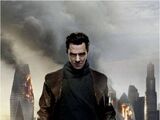
All items (486)

- Alexander Simmons

- Carter Greyhorse

- First Families

- Gerda Asmund

- Higher Synthetics

- Entertainment
- From Q to Khan: The 10 Best <em>Star Trek</em> Villains Ever
From Q to Khan: The 10 Best Star Trek Villains Ever
A t its best, Star Trek is a science fiction series about humanity’s ability to expand its horizons and overcome differences . But all that would be pretty boring without some great villains to overcome. Trek’s bad guys have been a mixed bag, ranging from the laughable — looking at you, Harry Mudd — to the legitimately terrifying — The Borg.
Who’s the baddest of the bad? Here’s TIME’s ranking of the 10 best Star Trek villains ever.
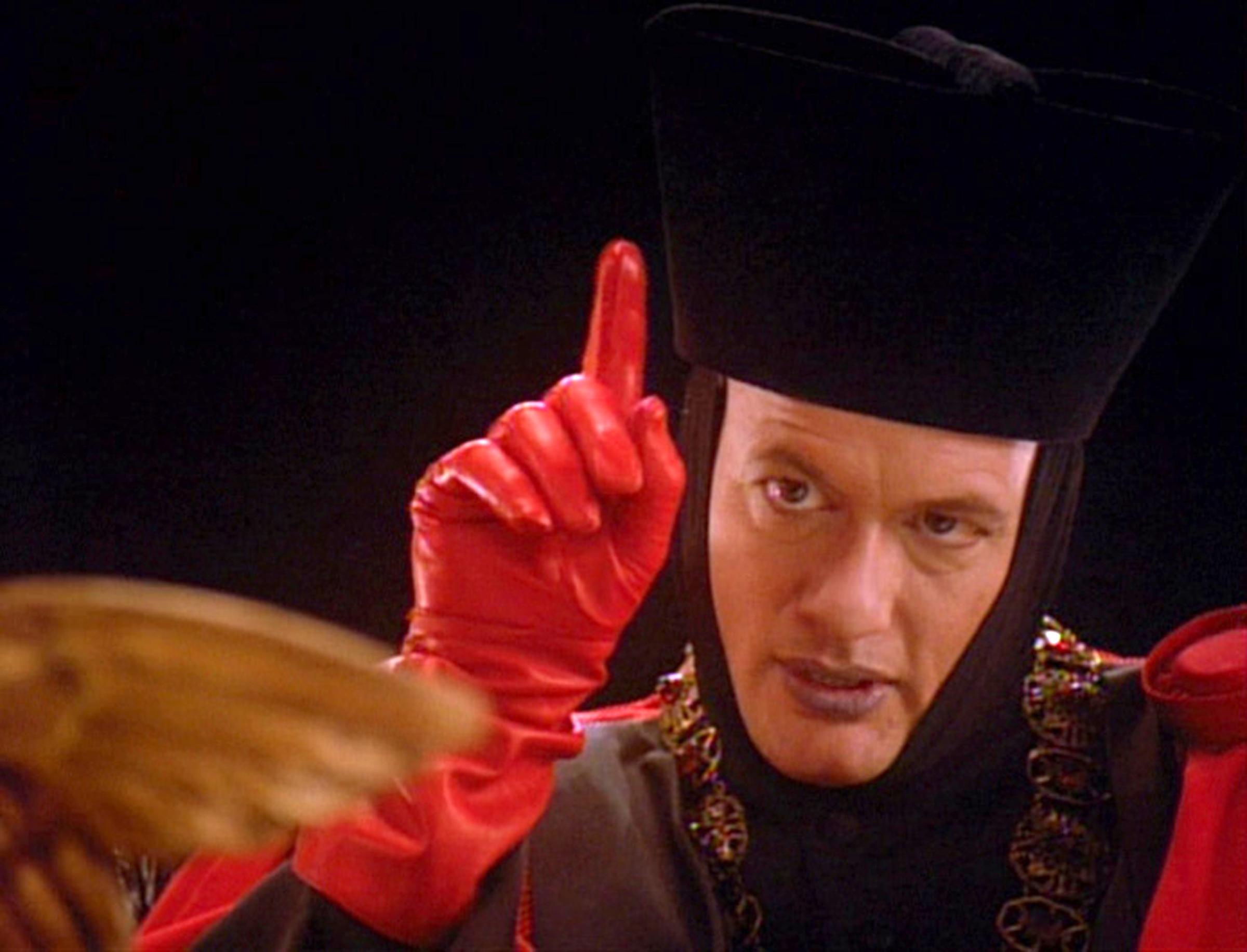
The omnipresent, omnipotent, omni-jerkwad Q is up here in tenth place only because he’s not really a villain — he just loves messing with the crew of Picard’s Enterprise. Sure, he can be a real pain sometimes, like when he tried to tempt Commander Riker with godlike powers. But he also helped the Enterprise, and the Federation at large, by flinging the Enterprise into a confrontation with another big bad on this list — the Borg. This move gave humanity a sense of what they were up against while they were out there, boldly going.
2. Duras Sisters
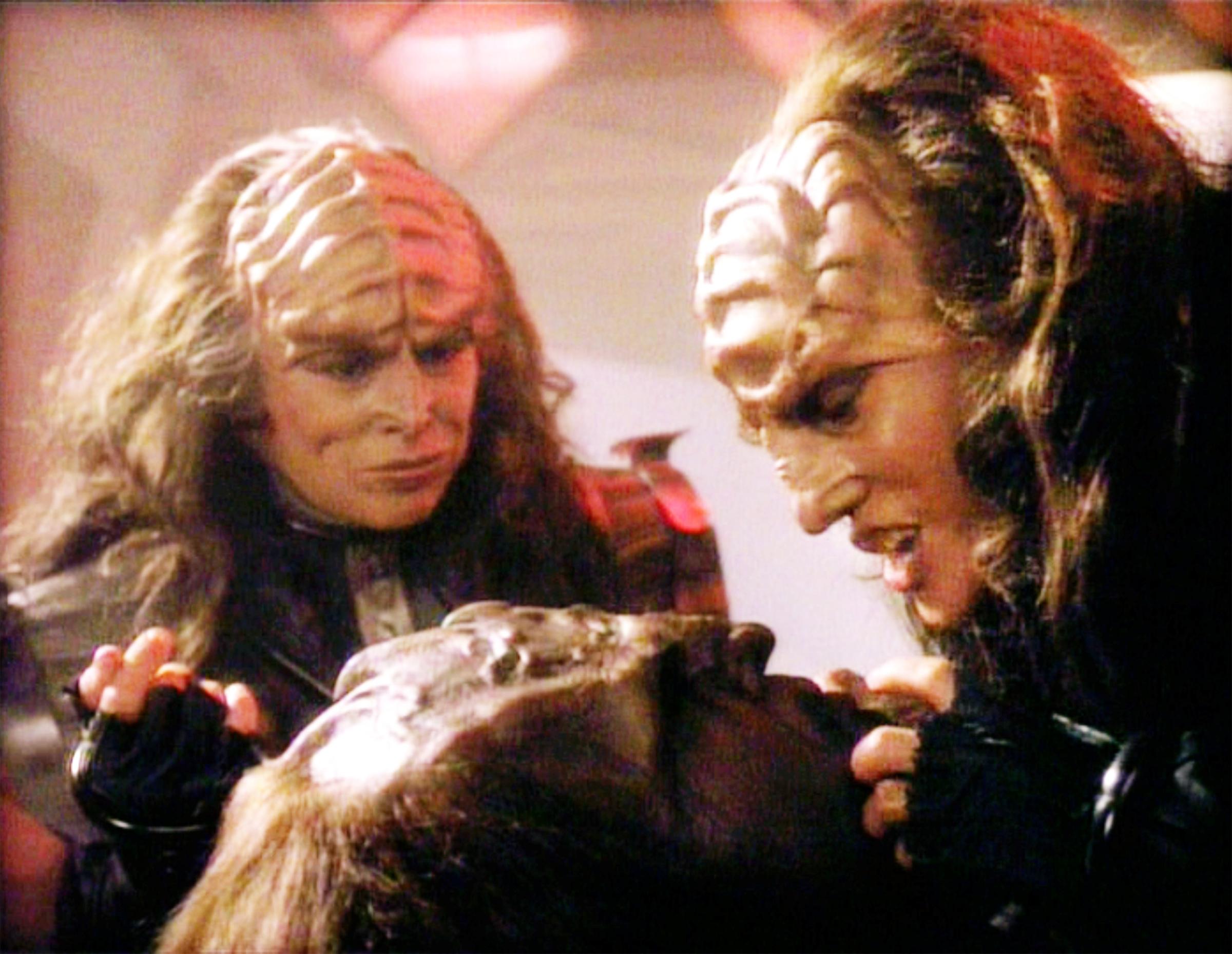
There are few Klingons less honorable than sisters Lursa and B’Etor of the House of Duras, whose actions plunged the Empire into civil war. They also had a history of working with Romulans to take control of Klingon politics, which is the sort of thing that would get you stabbed with a Bat’leth. The Duras Sisters came close to killing Picard’s crew, but some quick work by Commander Data helped the Enterprise-D turn the tables on their Bird of Prey — though the Federation flagship suffered irreparable damage in the process.
The robotic probe Nomad was launched from Earth with a noble goal: Seeking out new life and new civilizations, which is something of a theme in Star Trek. Unfortunately, a collision and melding with an alien probe turned it into a super-intelligent death machine, capable of genocide on a massive scale. But Captain James T. Kirk managed to use Nomad’s grim logic against the spacecraft, leading it to self-destruct, thus saving the Enterprise, humanity and probably lots of other species. (Good job, Kirk!)
4. Dr. Soran
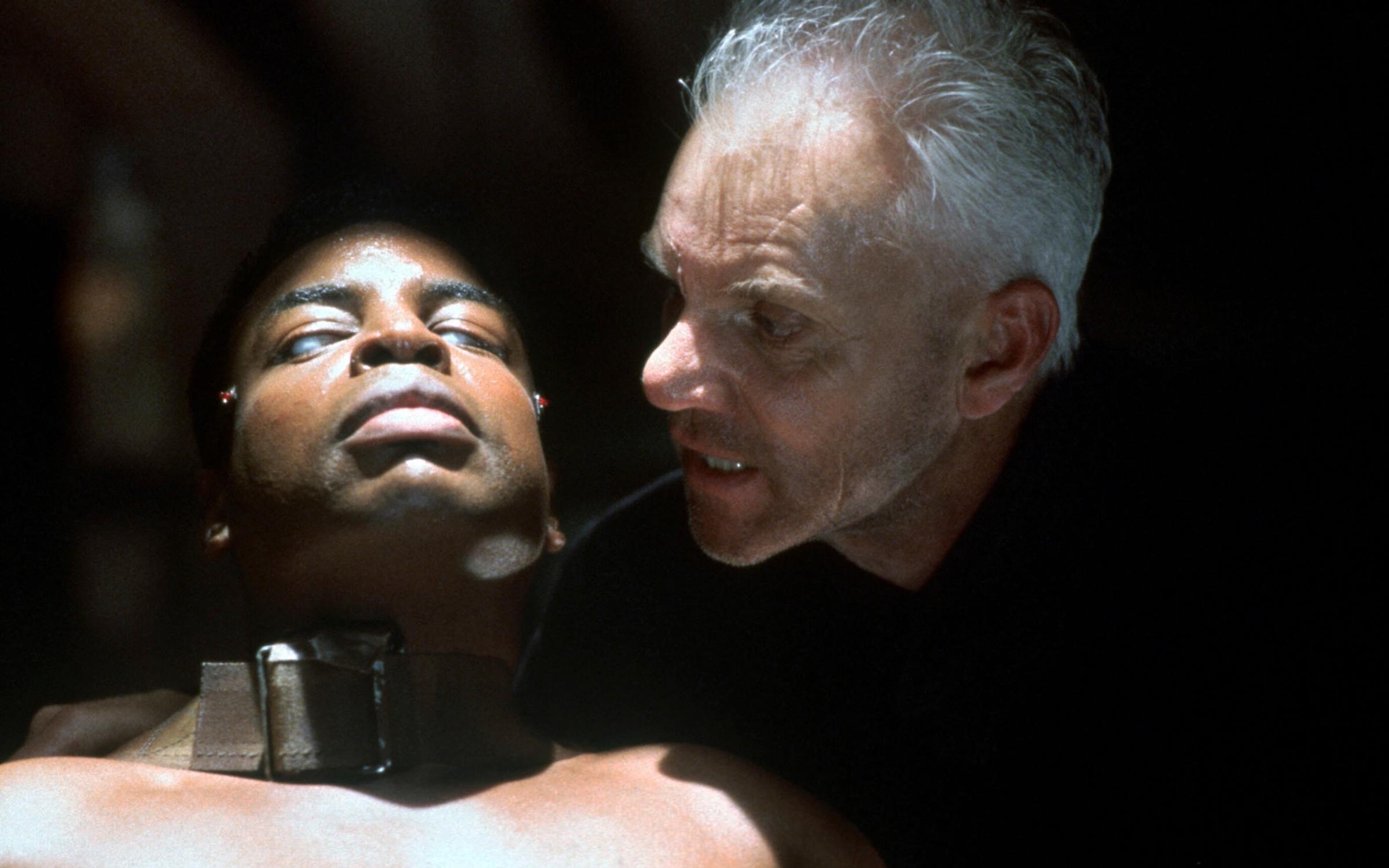
What would happen to you if you found your way to heaven, only to get torn back out? That’s what happened to Dr. Tolian Soran, and it messed him up good. Soran had an encounter with “the Nexus,” essentially a rift in space-time that visitors experienced as a dreamlike world they could shape to their liking. After he was pulled from the Nexus against his will, Dr. Soran became obsessed with getting back — even if it meant destroying entire worlds in the process. Not cool, dude.
5. Professor James Moriarty
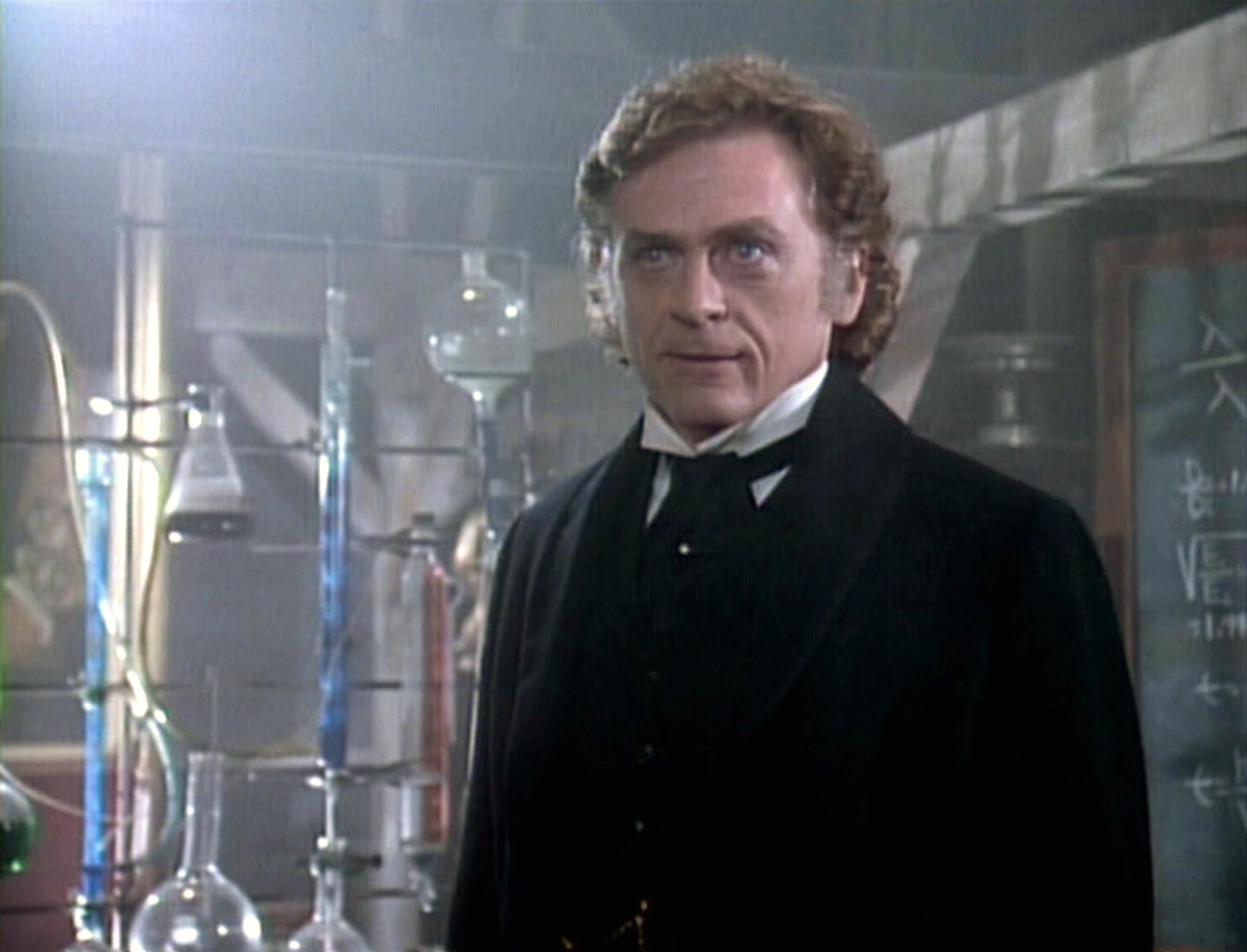
Okay, fine, Professor James Moriarty is a pretty great villain no matter where he shows up. But he’s particularly good in Star Trek: The Next Generation, where he appears as a holographic simulation that gains a degree of self-awareness and turns to evil. Eventually, Picard and crew found a clever and humane way of outsmarting him: They trapped him in a computer simulation with “enough experiences to last a lifetime.” It’s all very meta. Either way, Moriarty episodes are some of that series’ best “Holodeck gone wrong” stories. Won’t somebody fix that Holodeck?
Whereas the android Data is basically the chillest dude who ever stepped foot on the Enterprise-D, his “brother” turns out to be seriously evil. On their first encounter, Lore deactivates Data and impersonates him in an unsuccessful effort to steal the ship. Later, he attacks Federation outposts and tries to manipulate Data to get him to turn against the Enterprise crew. That almost happens, but Geordi and Captain Picard step in to remind Data his brother kinda sucks, and Data dismantles his evil twin.
7. Gul Dukat
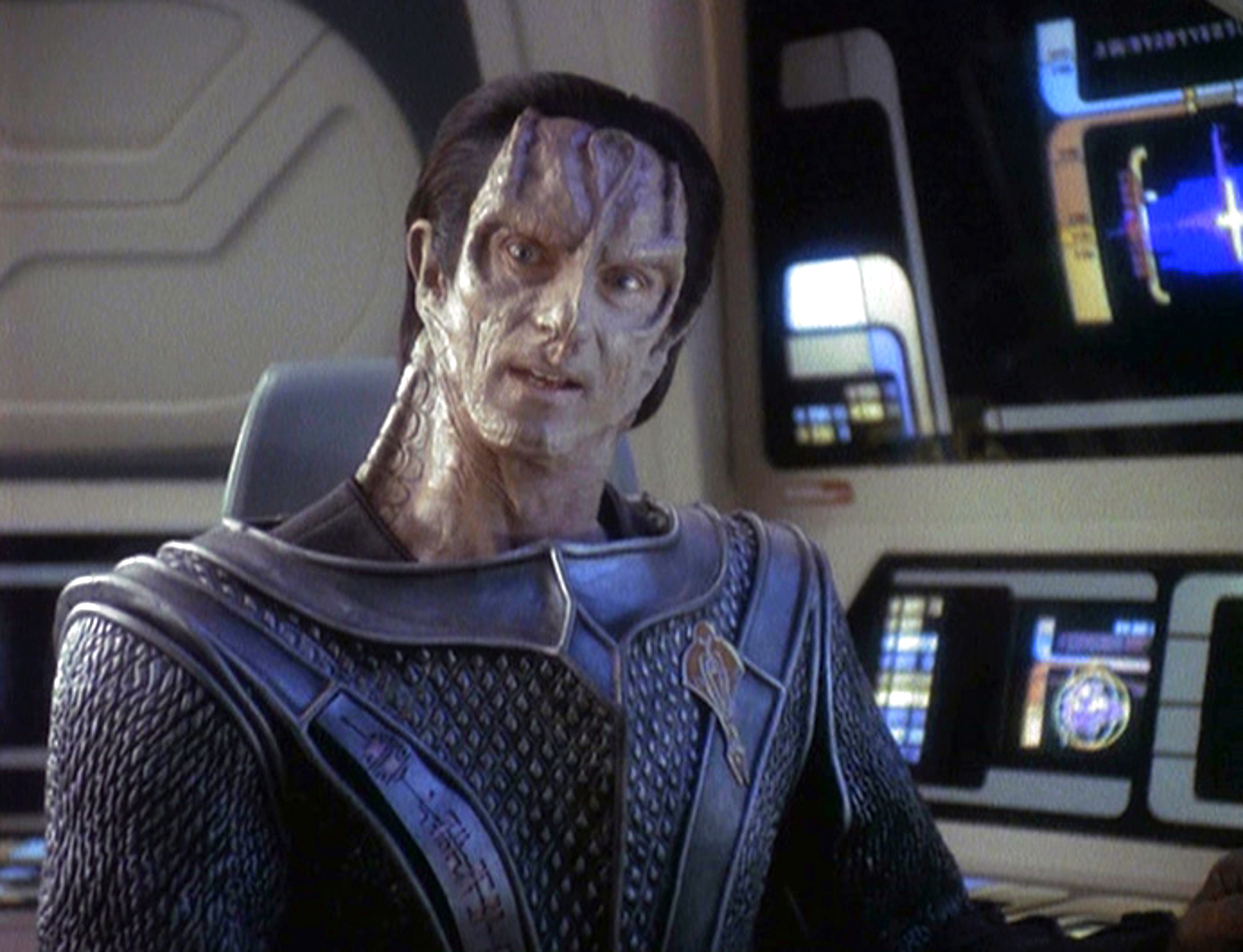
The Cardassians are basically a whole species of evil jerks, with Gul Dukat among the most twisted. He oversaw the Cardassian occupation of Bajor, subjugating the planet’s population as a ruthless dictator. He later aligned his people with the Dominion, an advanced government hell-bent on galactic takeover and a major Federation enemy. He ultimately ended up imprisoned in the Bajoran fire caves, which is fine, because he was not a nice person.
8. The Borg
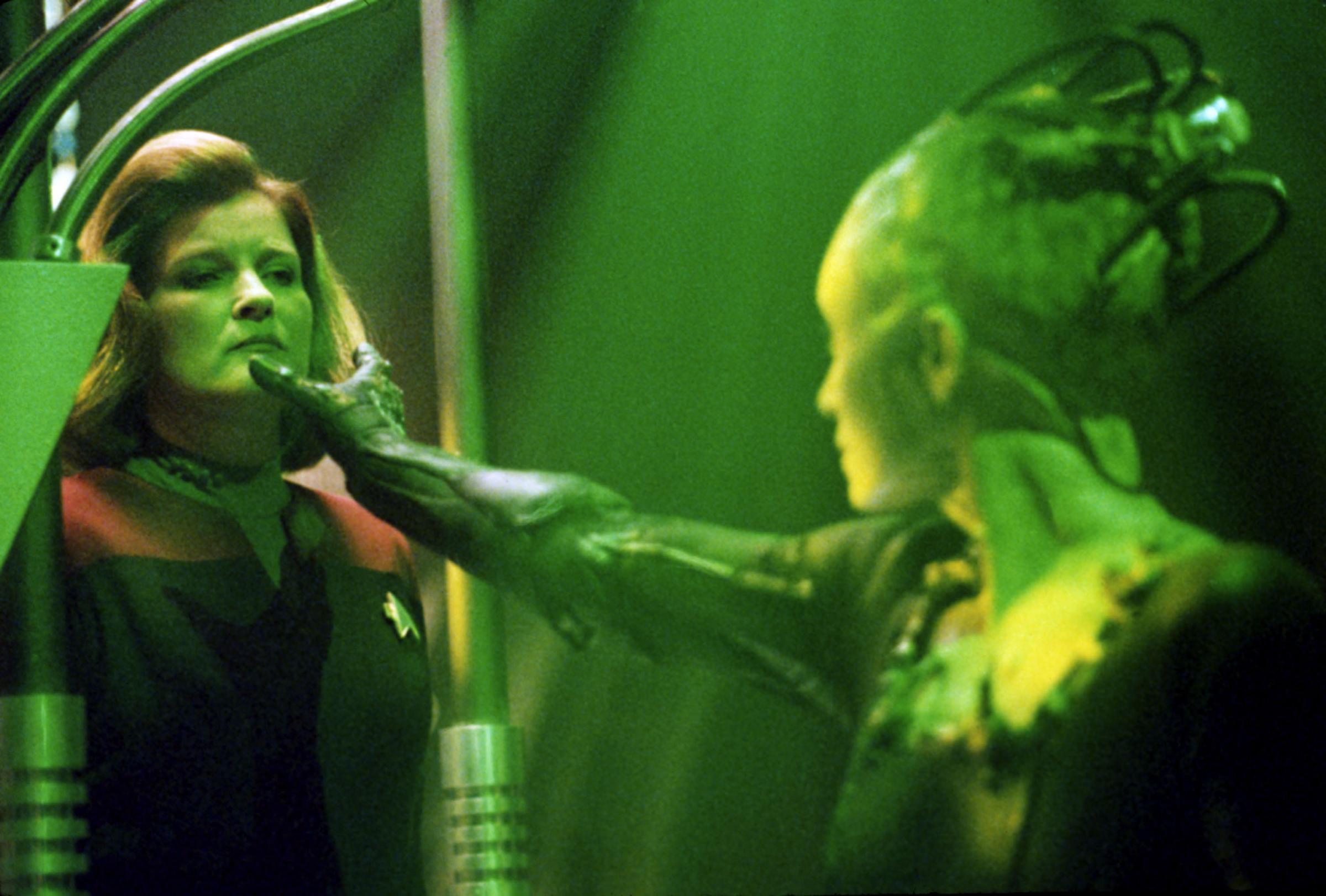
The Borg are Star Trek’s most viscerally terrifying villain. Part organic lifeform, part machine, the Borg destroy all life they see as inferior, and assimilate any species in which they find value. They’re also bound together in “the Collective,” a hivemind that allows essentially zero independent thoughts or actions. And they have very powerful weapons. Picard, who was once assimilated, summed it up best in this speech :
9. General Chang
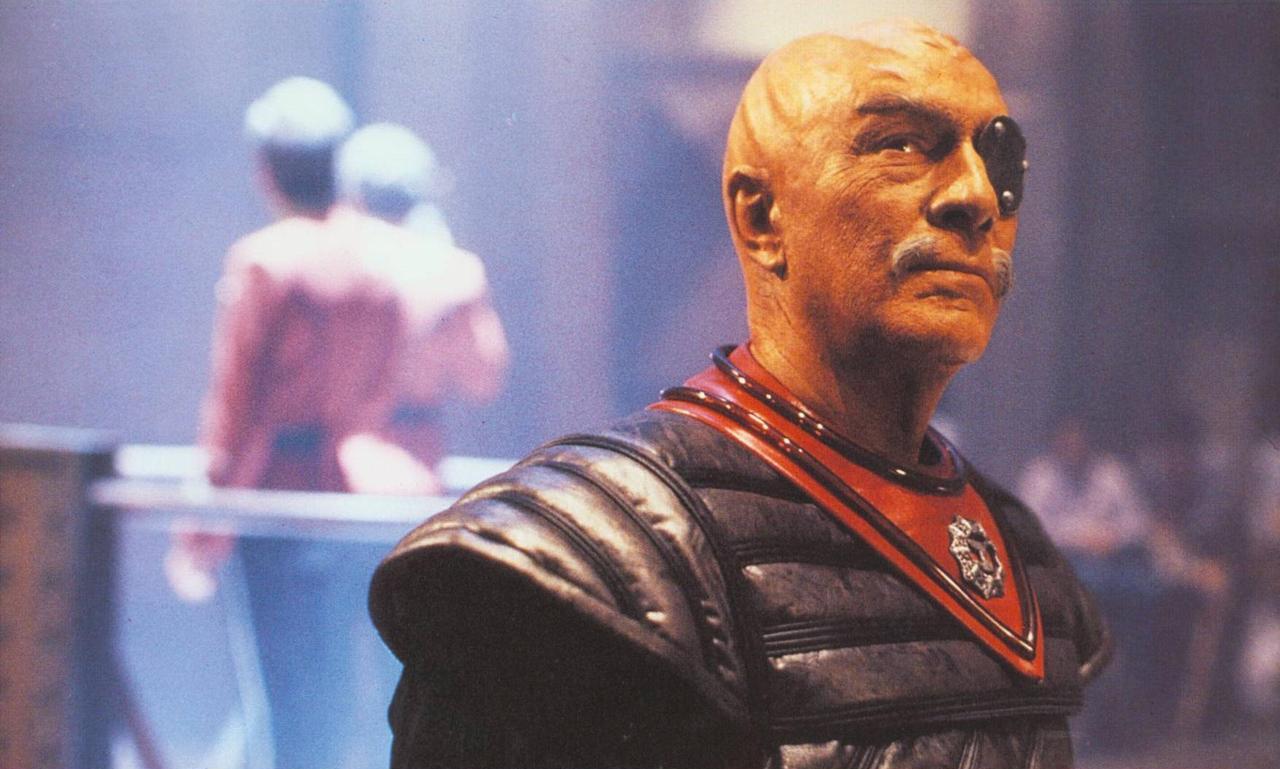
Now here’s a Klingon villain who really ranks in the top echelon of Trek baddies. After a nearby disaster put the Klingon homeworld at risk, the Federation and the Klingons moved towards peace talks — the thinking being that, if the Klingons didn’t have to spend so much money on its military prowess, it could fix the planet. But General Chang, among other Klingons and Federation officials, hated to the idea of peace. Instead, they conspired to ruin the talks — only to be foiled by Captain Kirk and crew. Chang also had an annoying habit of quoting Shakespeare, so nobody really missed him.
10. Khan Noonien Singh

Could anybody else really take the number one spot? A genetically engineered super-human from the past, Khan was a dictator who controlled large swaths of Earth until he was nearly deposed. Instead of being captured or killed, he fled the planet on a ship in biological stasis, only to be found centuries later by Kirk and company. After Khan unsuccessfully tried to take over the Enterprise, Kirk left him to settle a nearly barren world. He was later re-discovered by another Federation ship years later, harboring intense hatred for Kirk after the planet became nearly inhospitable to life. Khan then went on a vengeance tour, nearly destroying the Enterprise with a ship-turned-suicide bomb. Thankfully, Spock saved the day — at the cost of his own life. Sorta. The takeaway is this: Khan’s a seriously evil dude.
More Must-Reads from TIME
- The 100 Most Influential People in AI 2024
- Inside the Rise of Bitcoin-Powered Pools and Bathhouses
- How Nayib Bukele’s ‘Iron Fist’ Has Transformed El Salvador
- What Makes a Friendship Last Forever?
- Long COVID Looks Different in Kids
- Your Questions About Early Voting , Answered
- Column: Your Cynicism Isn’t Helping Anybody
- The 32 Most Anticipated Books of Fall 2024
Contact us at [email protected]
Top 120 Star Trek Villains

1. Ricardo Montalban

2. Alice Krige

3. Annie Wersching

4. Susanna Thompson

5. Leland Orser

6. Matt Frewer

7. Brent Spiner
8. brent spiner, 9. brent spiner.

10. Bruce McGill

11. Mark Lenard

12. Denise Crosby

13. Tamlyn Tomita

14. Ed Begley Jr.

15. Jeffrey Nordling

16. Jeffrey Combs
- Additional Crew

17. Raphael Sbarge

18. Richard Lynch

19. Jonathan Frakes

20. Kurtwood Smith

21. Christopher Plummer
- Music Department

22. Frank Langella

23. Victor Rivers

24. James Horan
- Special Effects

25. William Sadler
More to explore, recently viewed.
The best Star Trek villains of all time: from the Borg to the Klingons
The most memorable bad guys from the final frontier.
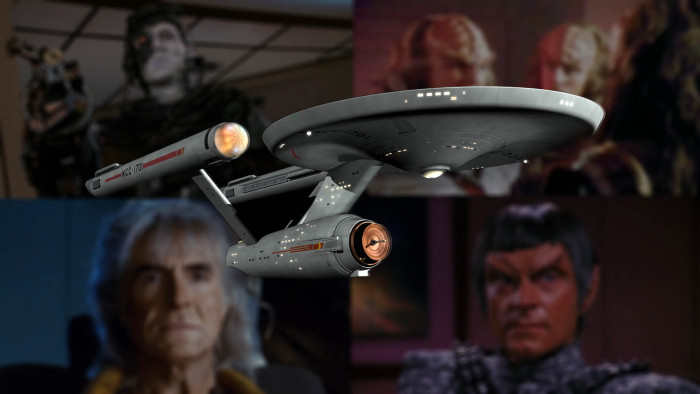
Like the even older Doctor Who, Star Trek has created more than its fair share of memorable adversaries since it debuted in 1966.
As captains James T Kirk, Jean-Luc Picard, Benjamin Sisko, Kathryn Janeway and the rest have boldly gone across the final frontier, they’ve met countless alien antagonists, human foes and even the occasional malevolent machine.
Many were instantly forgettable – few fans are still singing the praises of the Kazon, the Son’a or the Xindi – but others are nearly as famous as the franchise itself.
Here are 10 of the best Star Trek villains from the last five decades, taking in baddies from everywhere from the original series to The Next Generation, the movies and Discovery.
Don’t forget that you can set phasers to upvote or downvote these classic Star Trek villains.
All of the existing Star Trek TV shows are available to stream on Netflix, while Star Trek: Picard is on Amazon Prime Video.
Every one of the Star Trek movies is available to watch now on Paramount+. In fact two Star Trek shows feature in our best Paramount+ Shows guide.
- Get another sci-fi fix with our shortlist of the best Star Wars movies , ranked
10 great Star Trek villains
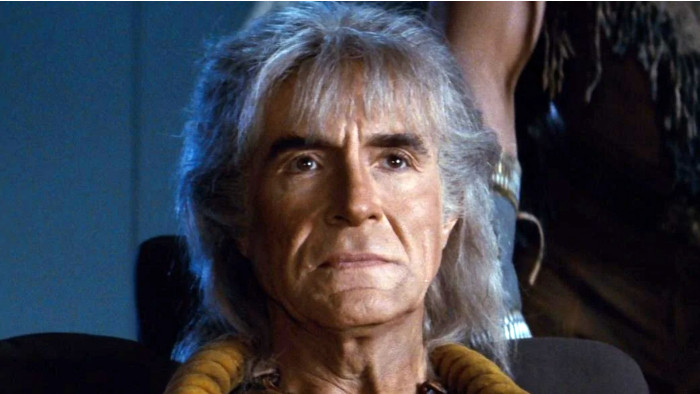
1 . Khan Noonien Singh
During Earth’s Eugenics wars of the 1990s (yep, they passed us by too) Khan was a genetically engineered tyrant who escaped into space with his most loyal followers. Revived by James T Kirk in original series episode “Space Seed”, he tried to take over the Enterprise before being exiled on a barren world for his troubles.
Superhumans don’t give up, however, and when he was unexpectedly picked up by a recon mission 15 years later, Khan vowed vengeance – and became one of Star Trek’s greatest villains in franchise highpoint The Wrath Of Khan. Khaaaaaaaan!
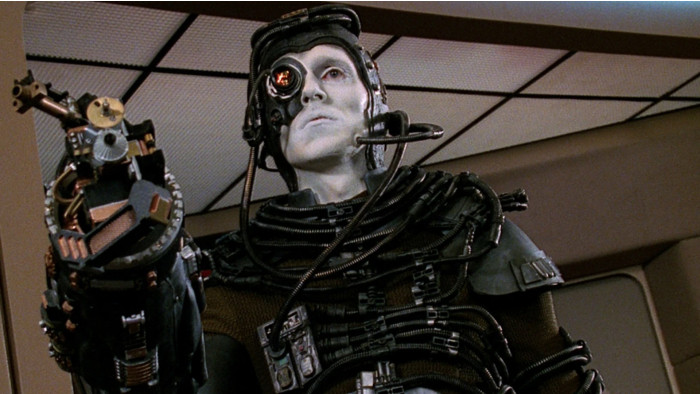
2 . The Borg
The comically inept Ferengi were originally set to be the Big Bads of Star Trek: The Next Generation, hard as that is to believe three decades later. That didn’t quite work out, but in season two episode “Q Who?” one of sci-fi’s all-time great antagonists appeared on Jean-Luc Picard’s viewscreen for the first time – the Borg.
Cybernetically enhanced and acting as a single, ruthless hive mind, they’ve spent centuries assimilating other species into their collective, while reminding the universe that “resistance is futile”.
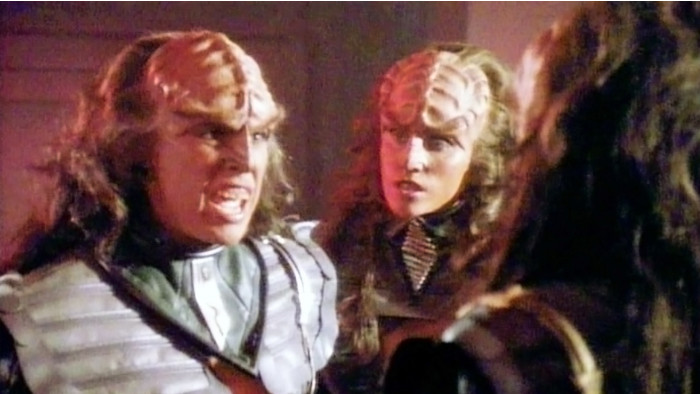
3 . The Klingons
A product of 1960s Cold War paranoia, the Klingons were a thinly veiled analogy for the Soviet Union in the original Star Trek. As synonymous with the franchise as Daleks are to Doctor Who, the Enterprise’s most famous foes returned as villains in the movies with a radical new look – those famous lumpy foreheads – before making an uneasy peace with the Federation in the Next Generation era. Their warrior-based society went on to form the backbone of many a TV story.
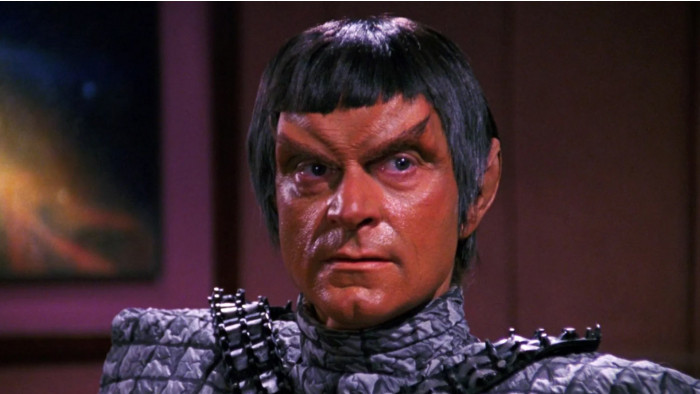
4 . The Romulans
Although closely related to the Vulcans, the Romulans have always favoured military superiority over logic. First introduced in the original series, this secretive race went AWOL for decades before Jean-Luc Picard reopened hailing frequencies in The Next Generation.
Since then, they’ve been regular Star Trek antagonists on TV and on the big screen – including JJ Abrams’s first reboot movie, where their world was destroyed by a supernova. The survivors of that apocalypse are set to play a key role in upcoming Amazon Prime Video series Star Trek: Picard.
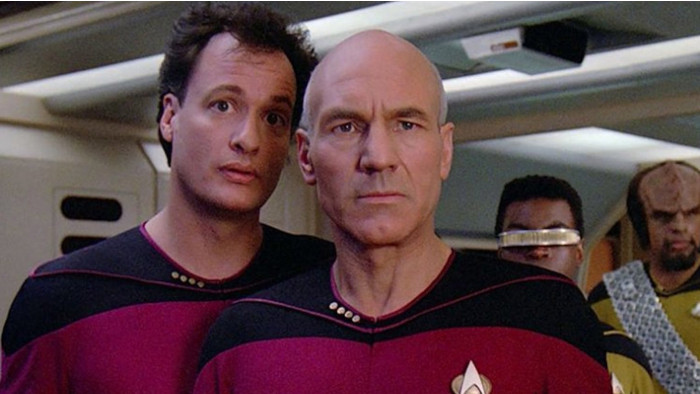
While Kirk and Spock met a being who claimed to be god in the laughable Star Trek V: The Final Frontier, The Next Generation had its own omnipotent being to contend with. Originally introduced in the pilot episode, putting the Enterprise crew on trial for the crimes of humanity, Q gradually evolved from full-on antagonist to a fun (if all-powerful) thorn in the side – and even developed a grudging respect for Jean-Luc Picard and co.
Episodes were generally better if they boasted a visit from Q – he even played matchmaker between the Federation and the Borg.
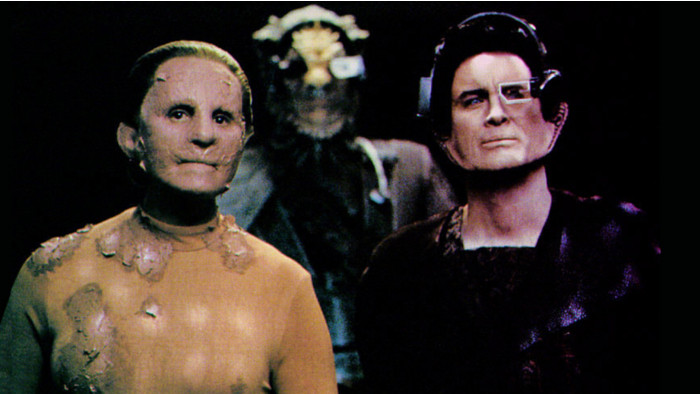
6 . The Dominion
Deep Space Nine started off as a pedestrian hybrid of The Next Generation and Babylon 5. Then its second season revealed the threat that lived on the other side of the wormhole: the Gamma Quadrant’s evil Dominion.
They were comprised of the militaristic Jem Hadar, genetically engineered to do their masters’ bidding; the Vorta, obsequious clones bred to relish admin; and finally the shapeshifting Founders running the show, acting like gods and providing a worthy enemy for Star Trek’s first proper story arc.
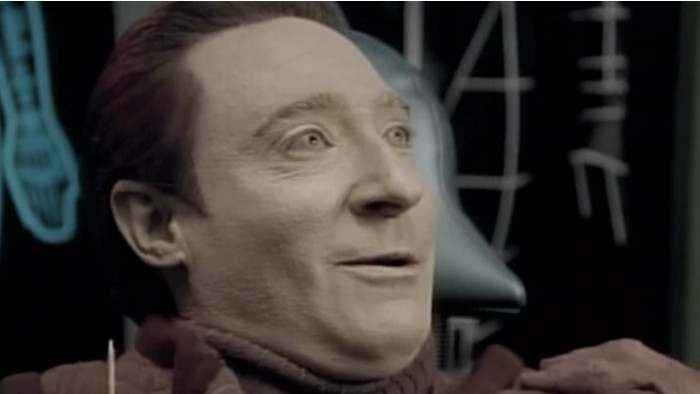
The old storytelling staple of the evil twin gets an android reboot, in the form of Data’s older brother, Lore. Unfortunately, this prototype model had some major programming glitches – like megalomania, an innate sense of superiority, and a penchant for mass genocide.
He’s also fond of impersonating his little bro. Lore eventually led a rogue faction of Borg who were struggling to deal with their new-found individuality, before he was ultimately captured and permanently boxed.
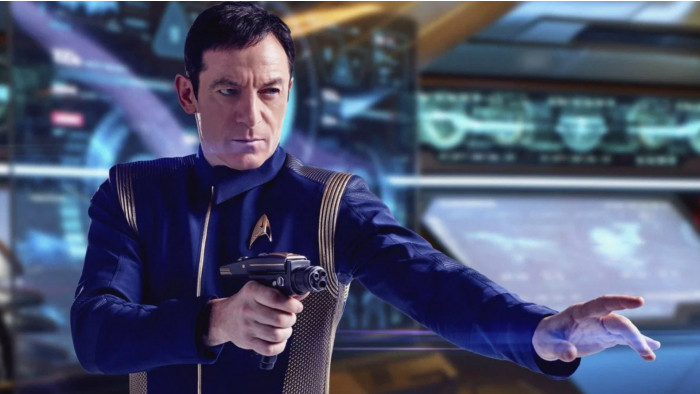
8 . Captain Gabriel Lorca
Starfleet captains are usually model Federation citizens, but there was always something a bit different about Gabriel Lorca. Being on a war footing against the Klingons was always going to shift the rules of engagement, but even so, the USS Discovery’s commanding officer had remarkably scant regard for regulations and the sanctity of human life.
It all made sense when the captain was revealed to be the other Lorca from the authoritarian Terran Empire in the Mirror Universe, a place where it’s good to be bad.
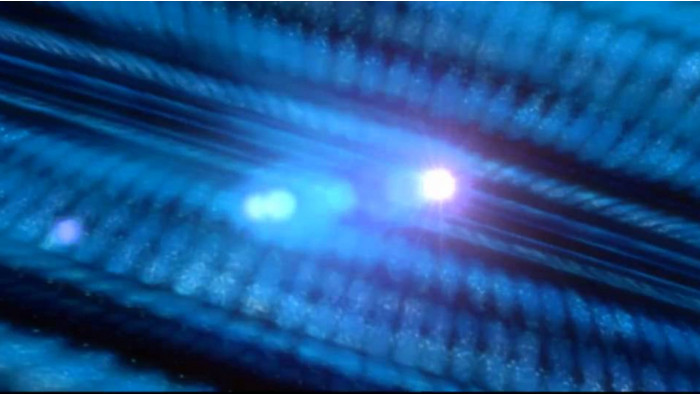
Sometimes the worst enemies are the ones you build yourselves… In 2001: A Space Odyssey wannabe Star Trek: The Motion Picture, the mysterious V’Ger wiped out all in its path as it attempts to hook up with “the creator”. Ultimately it turned out to be Nasa probe Voyager 6 with some serious upgrades.
It had learned some stuff through the course of its lengthy travels, so was looking to attain the next level of existence – with little concern about the collateral damage.
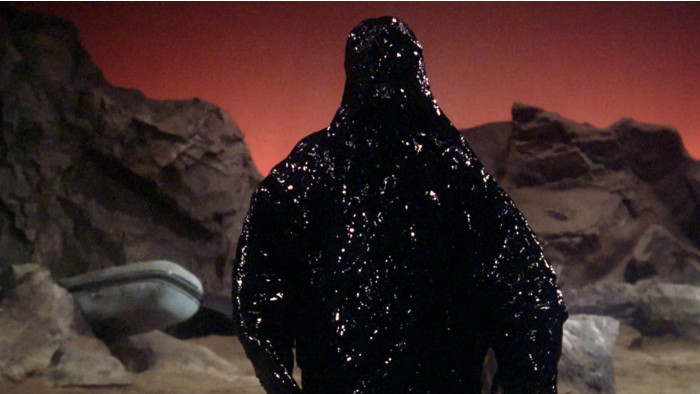
This malevolent oil slick only appeared once, in The Next Generation episode “Skin Of Evil”, but warrants a place in this list of great Star Trek villains because it’s one of the few entities to kill off a principal crew member. The distillation of an entire planet’s bad vibes, it delighted in tormenting humans and murdered security chief Tasha Yar for its own amusement. One of Trek’s most shocking moments makes you rather glad he can’t leave his home planet.
SOMETHING MISSING FROM OUR SHORTLIST?
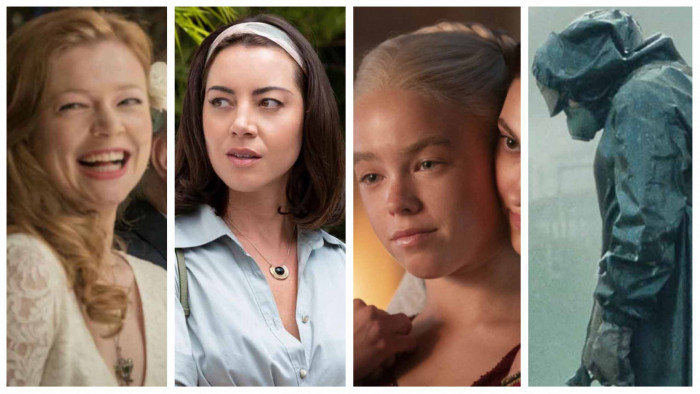
The 51 best NOW TV shows to watch: great Sky series to stream


The 32 best movies On NOW: TV that's worth streaming
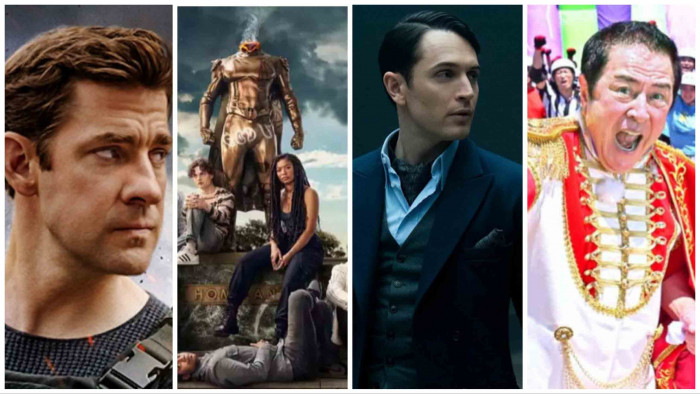
The best Amazon Prime Video series to binge-watch right now
Related reviews and shortlists.
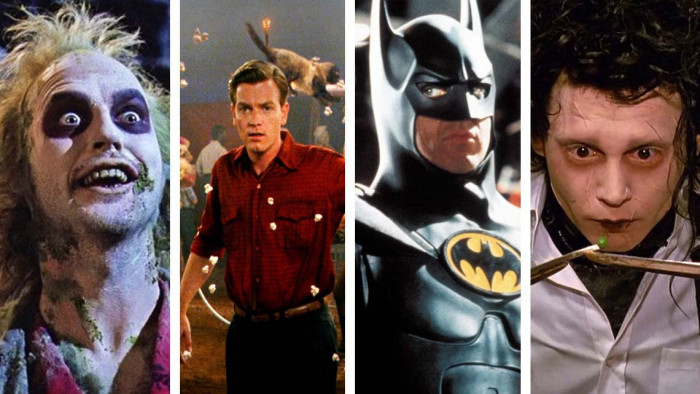
The 10 best Tim Burton movies of all time
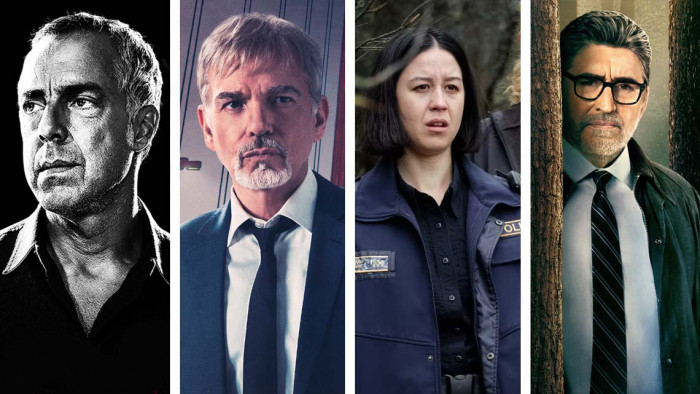
The best crime TV shows on Prime Video
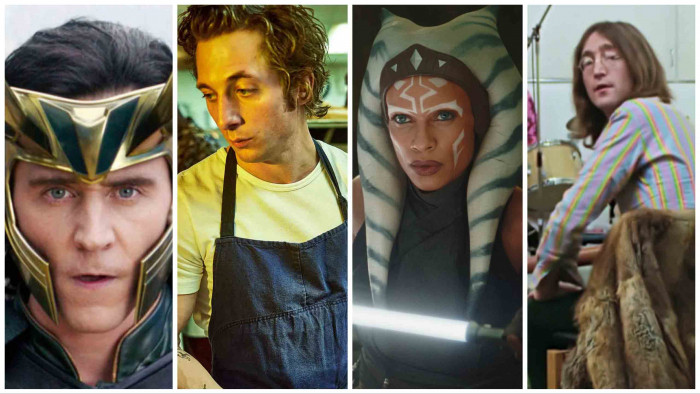
The 62 best Disney Plus shows to watch: great shows to stream

The best movies on Netflix: this is what to watch
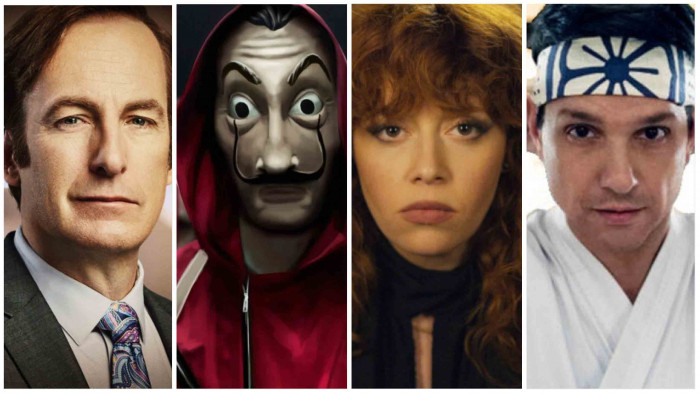
The 78 best Netflix shows: from Lupin to House of Usher
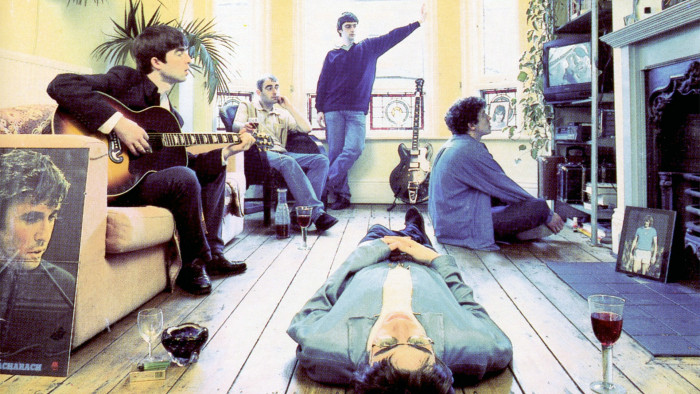
The 15 best Oasis songs of all time, ranked
- Stranger Things Season 5
- Deadpool and Wolverine
- The Batman 2
- Spider-Man 4
- Yellowstone Season 6
- Fallout Season 2
- The Last of Us Season 2
- Entertainment
- Streaming Guides
7 best Star Trek villains, ranked
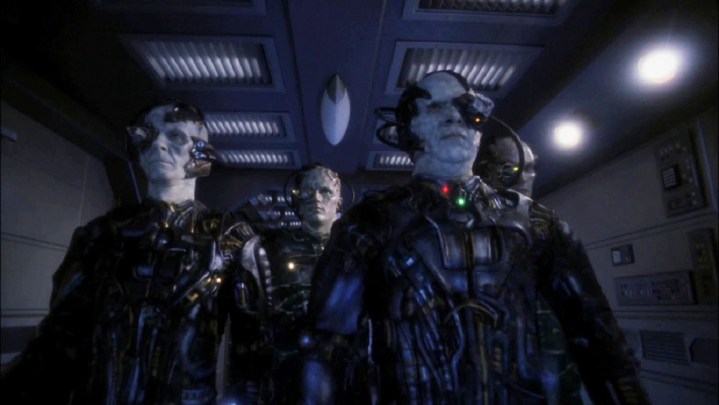
Thanks to its more than 50 years of continued existence, Star Trek has produced just a lot of stuff. That stuff includes several great TV shows, more than a few outstanding movies, and perhaps most importantly of all, some genuinely great villains.
4. The Klingons
3. the borg queen, 2. gul dhukat.
Because Trek has always concerned itself with the politics of the stories it tells, the series has also introduced some genuinely nuanced bad guys. There are plenty of great villains of the week, to be sure, but there are also legendary villains who have made their way onto this list. These are the seven best Star Trek villains, ranked.
Say what you will about Star Trek Into Darkness , but J.J. Abrams’ first Star Trek effort was a rousing success. Among its many feats was its introduction of a totally new villain in the form of Nero, a vengeful Romulan who blames Spock for not preventing the death of his family.
Eric Bana’s performance in the role is transformative, but what really sells the whole endeavor is the sense of grandeur and scale that’s on display. Nero is filled with rage, and it’s that rage that has driven him to where he is now.
We’ve had plenty of great villains from across the many Trek shows, but Deep Space Nine ’s Weyoun was among the most beloved, in part because he was an ideal foil to the show’s cast. As the mouthpiece for the Dominion and a Vorta himself, Weyoun always delivered his message with a smile, but that rarely meant that he actually had the best of intentions.
In fact, Weyoun was in many ways your typical slimey politician, and that was undoubtedly a huge part of what made him so appealing to fans of Deep Space Nine every time he was killed off and then inevitably returned to the show.
An omnipotent being that is a reminder of how far Star Trek characters can come, Q was first introduced as an ominous presence but became something much sillier as he became more familiar to Star Trek fans.
It was Q’s actions that ultimately resulted in the introduction of the Borgs to the universe, and he was also the one who charged Picard with the crimes of humanity. In spite of his power, Q is ultimately not the worst perpetrator of evil in the world of Star Trek, even though he certainly could have been.
In many ways the primordial Star Trek villain, the Klingons have shown up in a number of different villainous guises over the course of the franchise’s long and storied history. In the show’s original configuration, they existed as a foil to the Federation — the USSR to the Federation’s America.
Of course, Trek never expressed any idea quite that simply, and the Klingons were always humanized, even as they often opposed what the Federation was doing. You understood that they had their reasons, even if you weren’t always supposed to be sympathetic to them.
The Borg, in general, is a major menace to the crew of Star Trek: The Next Generation . Operating as a hive mind with the goal of assimilating all other living things into them, part of the point of the Borg was that they were everywhere and nowhere.
That’s why many were so worried by the introduction of the Borg Queen, but they didn’t have any reason for concern. The Borg Queen totally works, in large part thanks to Alice Krige’s memorable, sensual performance in the central role.
Gul Dukat was the best version of the authoritarian mode of Star Trekvillain. A character so villainous and tyrannical that you wanted nothing more than his ultimate defeat, even if you also found him compelling.
A Cardassian war criminal who ruled over Bajor as a complete totalitarian, what made Dukat so remarkable was that you could understand that his actions were heinous, even as you found yourself drawn into his world. Many argue that Gul Dhukat is the finest villain Star Trek has ever produced, and we think that’s pretty close to being on the money.
A name memorably screamed not once but twice in Star Trek movies , Khan is most remembered today for killing Spock in The Wrath of Khan , widely regarded as the best of the Trek movies for a reason.
Although Khan was just a villain-of-the-week in the original series, in Wrath of Khan , he is elevated to a devious mastermind, capable of taking down and outsmarting even Kirk, Spock, and their crew. Ricardo Montalbán’s performance made the role one of the most important in the history of the franchise. As for Benedict Cumberbatch’s reprisal of the character? Well, the less said about that, the better.
Editors’ Recommendations
- The best sci-fi movies on Max right now
- The best sci-fi movies on Hulu right now
- 7 best thriller miniseries ever, ranked
- 5 best sci-fi movies of 2024 so far, ranked
- 10 best Star Trek: Discovery episodes, ranked

Science fiction movies tend to lean heavily on the fiction side to create fantastical stories and futuristic worlds beyond anyone's wildest dreams. There are more than a few films in the genre, however, that stand out for using theories and concepts grounded in actual science. These scientifically accurate movies use realistic principles to create engaging worlds and scenarios that are often more effective because they are plausible.
From the meticulously crafted survival story in The Martian to the not-too-distant future shown in Her, these movies make the most out of the unique intersection between science and imagination. They propose potential realities people may one day experience given the trajectory of both human ingenuity and society's most dangerous flaws. Whether viewers are in the mood for soft sci-fi or more extreme applications of scientific theories, there's something for every type of fan looking to see how science and cinema collide. 5. Gattaca (1997)
And just like that, the latest season of Doctor Who has come to an end. The long-running BBC sci-fi series kicked off its current, Russell T Davies-run era late last year with a trio of David Tennant-led 60th anniversary specials that were, in turn, followed by the show's 2023 Christmas special, The Church on Ruby Road. That episode formally introduced viewers to Ncuti Gatwa's Fifteenth Doctor and his first companion, Ruby Sunday (Millie Gibson), and it set up a series of cosmic, time-hopping adventures to come.
The season that has since aired didn't prove to be the full-blown home run that some may have wanted. It did, however, successfully breathe life back into Doctor Who and brought with it more than a few memorable new entries in the series' ever-growing list of great installments. With that in mind, now that Gatwa's first Doctor Who season is over, here are all nine of its episodes -- ranked from worst to best. 9. Space Babies
Sci-fi is a popular genre in literature due to its thought-provoking nature. Beyond thrilling adventures through space or fantastical realms, sci-fi books explore profound topics like the potential impact of artificial intelligence, the challenges of space exploration, and the ethical dilemmas of scientific progress. Fueled by these themes, readers are left to think beyond the page and imagine what the future holds.
That’s why sci-fi books are popular source materials in the realm of film — they bring extraordinary worlds, characters, and stories to life in a way books can't. With breathtaking visuals and immersive sound design, sci-fi movies allow audiences to truly experience stories like a televised battle royale in a dystopian world, the invasion of terrifying alien creatures, and the thrill of being sucked into a black hole. 9. The Hunger Games (2012)
The Best Star Trek Villains Ranked
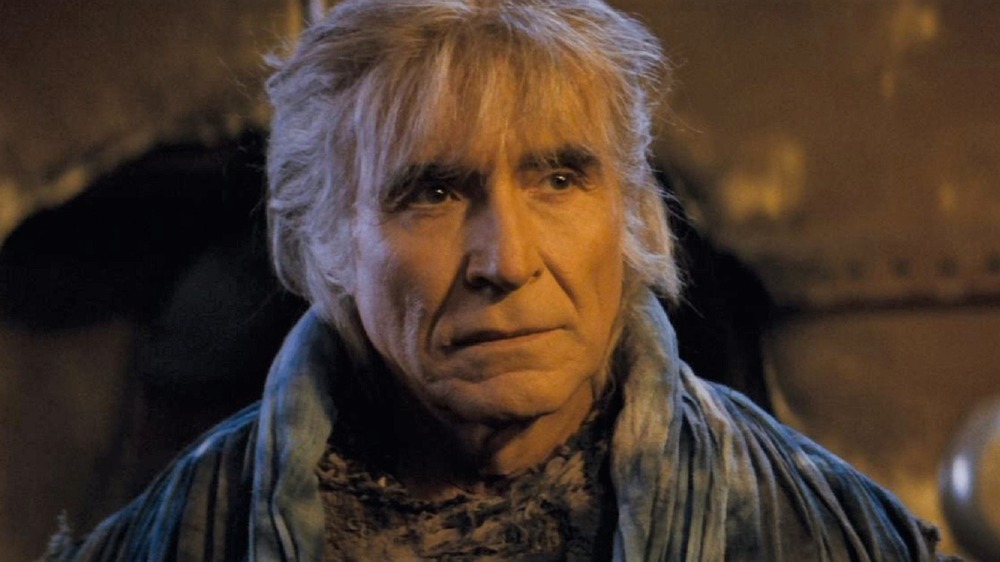
Space — the final frontier. In that vast expanse, there waits mystery, challenge, and according to Star Trek , a bunch of gods, cyborg collectives, and countless species waiting to kill us, assimilate us, or test the boundaries of our civility.
Since Star Trek: The Original Series ( TOS ) premiered in 1966, the Trek universe has been feeding our imaginations with villains — from bizarre to embarrassing to utterly ruthless — for over half a century. Since many of the earliest Trek series were episodic, we didn't often get the chance to see the same bad guys return to hound the heroes. But as Trek experimented with serialized storytelling — particularly with Deep Space Nine ( DS9 ) — the more promising space-faring antagonists got multiple chances to show how bad they could be or, in some memorable cases, to prove they weren't quite as bad as you thought.
Among Trek 's villains are some of the most fun and memorable in popular media, and we thought we'd give you our own choices of who among them shines the brightest. Best lists are always subjective, but we're fairly confident there won't be too many disagreements for our picks of the best Star Trek villains, ranked from worst to best.
Badgey makes fun of both Star Trek and Microsoft
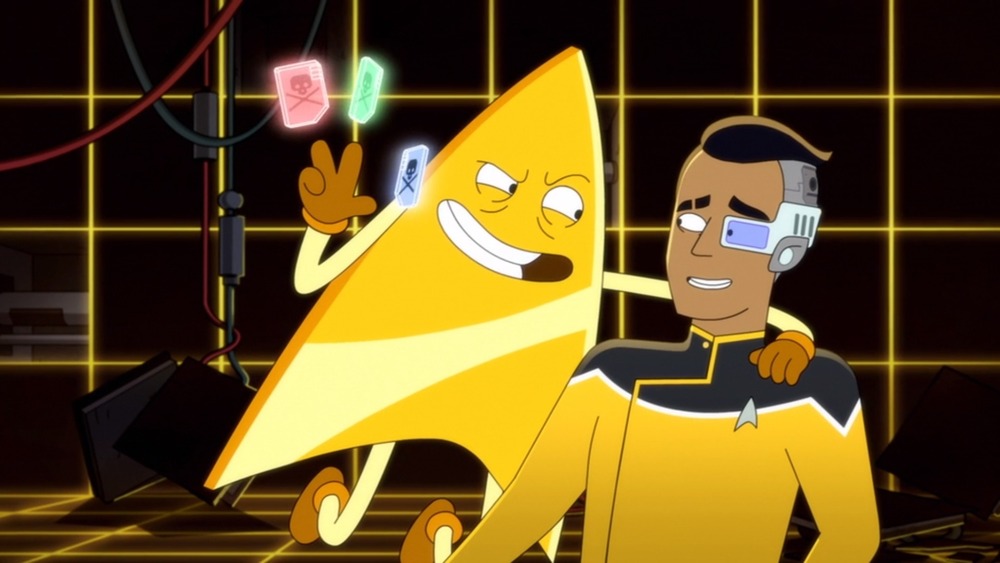
As one of the youngest Star Trek series with a much stronger focus on comedy, the animated Star Trek: Lower Decks doesn't boast a wealth of recurring villains. Regardless, one of the few reappearing bad guys from the series is one of the funniest and cleverest conceptions in the entire Trek franchise. Voiced by Jack McBrayer (best known as 30 Rock 's Kenneth the Page), the holographic villain Badgey is a hilarious and brutal send-up of not only one of Star Trek 's most tired tropes but of one of the most famously annoying aspects of Microsoft's software.
We first meet Badgey in season 1's "Terminal Provocations," when Ensign Rutherford (Eugene Cordero) introduces Ensign D'Vana Tendi (Noel Wells) to his holodeck training program. Acting like the animated paper clip "Clippy" from Microsoft Office and shaped like a Starfleet badge, Badgey at first seems eager to help Rutherford and Tendi with whatever they need. But when an attack by alien scavengers causes the holodeck to malfunction and disengage the safety protocols, Badgey takes the opportunity to get vengeance on the person he sees as his abusive creator — Rutherford. Sharing such Clippy-like homicidal gems as, "Fun fact: I'm gonna rip your eyes out!" and, "Here's a tip: I'm going to burn your hearts in a fire!" Badgey pursues Rutherford and Tendi across holographic landscapes until Rutherford figures out a way to defeat him.
Badgey makes a second appearance in the season 1 finale, and we hope we'll be seeing plenty more of him in the future.
Annorax is one of Star Trek's most sympathetic villains
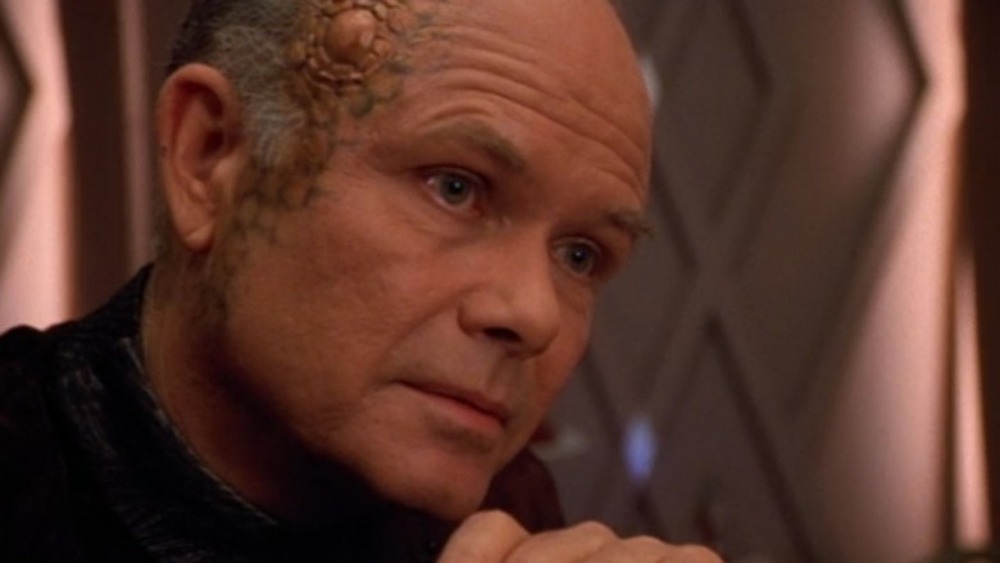
Kurtwood Smith has made a number of TV and film appearances in the Star Trek franchise, but none of his characters are both as chilling and sympathetic as the brilliant scientist Annorax from season 4 of Star Trek: Voyager . He places a low on our list because he never reappears after the two-parter "Year of Hell," but he makes enough of an impression to earn a spot regardless.
Part of a race known as the Krenim, Annorax begins his cursed quest by seeking to restore his people's once expansive empire to power. To this end, he develops a temporal weapon called simply the "Weapon Ship," which he uses to wipe out other species — not simply killing them but making it as if they never existed in the first place. While his attempts do restore more and more of the Krenim Imperium, the restoration of a single colony eludes him every time — the colony of Kyana Prime, where Annorax's wife, children, and grandchildren lived until his actions unintentionally erased them. So he and his restless crew, protected from the time-space continuum within their ship, have continued like this for two centuries, committing genocide again and again to feed the obsession of a captain who's convinced time itself is claiming vengeance upon him.
While his time is brief, Annorax is one of the most quietly horrifying and tragic villains in the entire Trek franchise.
General Chang was a perfect rival for Captain Kirk
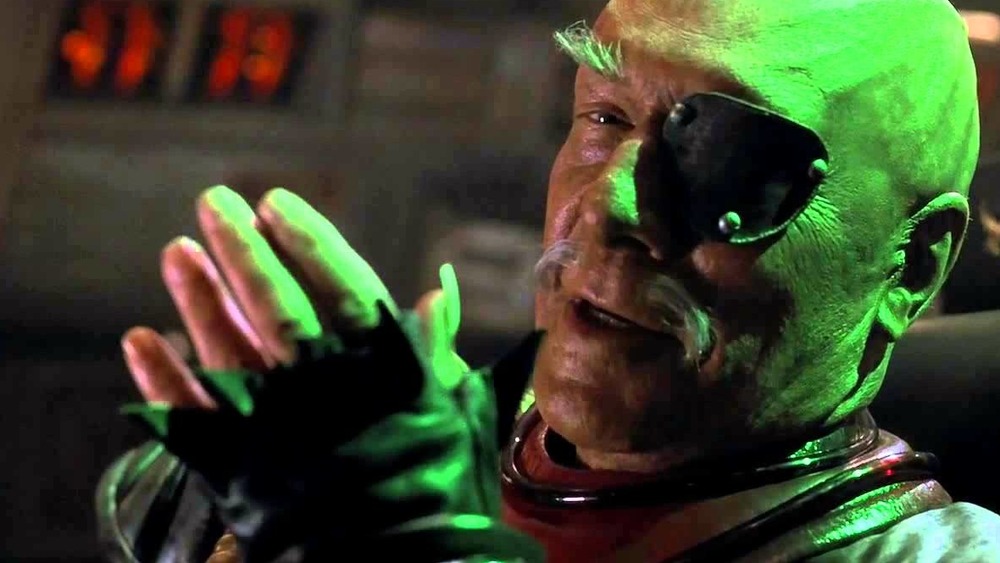
Few Star Trek villains simultaneously embody the sophistication, Shakespearean nobility, and ruthlessness of the late Christopher Plummer's General Chang. Plummer was a fitting choice not only because of his acting chops but because he was an important part of William Shatner's career. A decade before Shatner assumed the role of Captain Kirk, he was Plummer's understudy in a 1956 production of Henry V .
Chang appears exclusively in the final film to feature the complete Original Series crew, 1991's Star Trek VI: The Undiscovered Country . Chang is one of the architects of an alliance between rogue elements of the Federation, the Klingon Empire, and the Romulan Empire who are unwilling to see a lasting peace between Earth and Qo'noS. Chang plays a large part in the framing of Captain Kirk (Shatner) and Dr. McCoy (DeForest Kelley) for Klingon chancellor Gorkon's (David Warner) assassination, he prosecutes them in the unforgiving Klingon court, and he captains the prototype Bird-of-Prey that comes close to destroying both the Enterprise and the Excelsior toward the end of the film.
While Chang is ultimately unsuccessful, from start to finish he exudes a singular presence among Trek 's rogues' gallery. Plummer is particularly impressive when he and the rest of Gorkon's entourage are leaving the Enterprise after a diplomatic dinner. In spite of not saying a single overtly threatening word or making any hostile gesture, his body language and facial expressions tell you everything you need to know in the scene — that Chang is eager to be the man who defeats Kirk in battle.
Data's evil brother was a fun and formidable foe
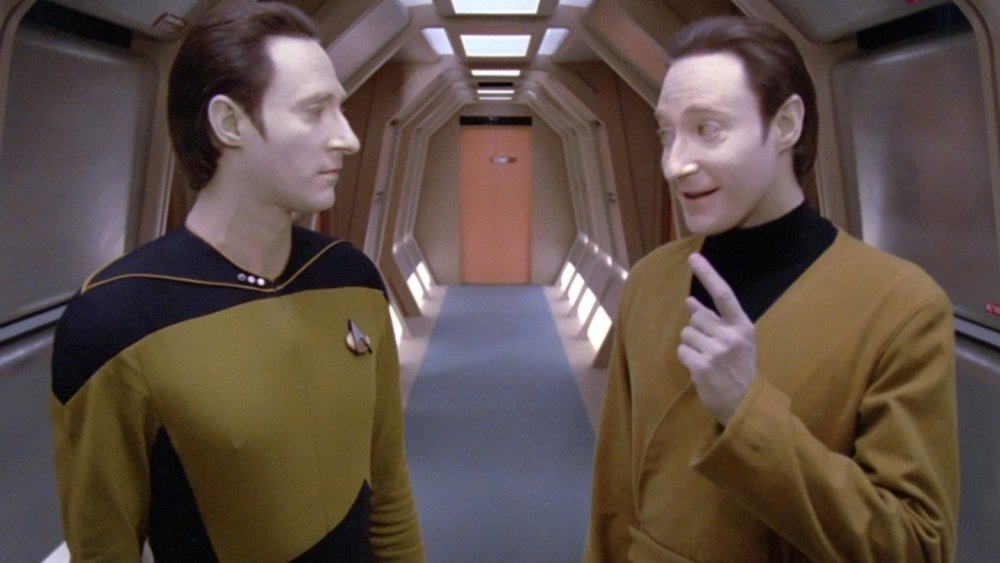
The android Data is unquestionably one of the fan-favorite characters from Star Trek: The Next Generation . But one of the downsides of portraying the android is that — except in instances when something causes Data's programming to go haywire (which, admittedly, is often) — the emotional spectrum that actor Brent Spiner gets to play with is fairly limited. That changes just a little bit with the season 1 introduction of Data's evil brother, Lore, in "Datalore."
Unlike Data, Lore is "gifted" with human emotions, but unfortunately, he receives them long before Dr. Noonian Soong has truly learned to properly program them. As a result, Lore is unstable and treacherous. It's eventually discovered that it's Lore who summoned the powerful Crystalline Entity that destroys all human life on Omicron Theta — the planet upon which both androids are discovered. After Lore is reassembled, he deactivates his brother and assumes Data's identity in an attempt to feed the crew of the Enterprise to the Crystalline Entity. And in his final appearance — the two-part "Descent" bridging the sixth and seventh seasons — he becomes something of a cult leader to a group of Borg who've liberated themselves from the Collective.
As humorous as he is evil, Lore is one of the most fun villains to show up on The Next Generation ( TNG ). At the same time, his appearances often pack an emotional punch, since the evil android remains one of the few creatures Data can call family.
Gowron isn't always a villain, but when he is, he threatens the entire Federation and more
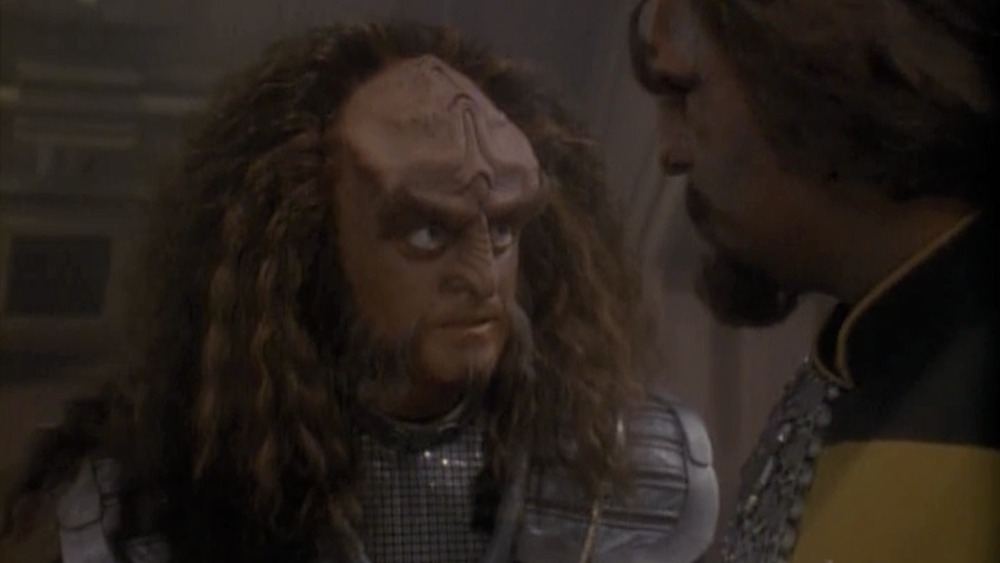
First appearing in the season 4 TNG episode "Reunion," Gowron isn't always a villain. He's introduced as one of two contenders for the Klingon chancellorship, a title he eventually achieves. For the most part in his TNG appearances, Gowron is more of a neutral character pursuing his own agenda. This changes once TNG ends and Gowron becomes a recurring character on Star Trek: Deep Space Nine .
While his first DS9 appearance is season 3's "The House of Quark," Gowron doesn't become an important part of the show's serial drama until Michael Dorn's Worf joins the series in the season 4 premiere "The Way of the Warrior." While still perfectly expressing the trademark Klingon passion for battle, on DS9, Gowron is portrayed more as an opportunistic politician. He uses the threat of the Dominion to reignite his people's warlike tendencies with an invasion of Cardassia and, later, a new war with the Federation. During the epic war storyline in the show's final season, Gowron purposely wastes the lives of his warriors by sending the forces of General Martok (JG Hertzler) — who he sees as a political rival — to fight battles they can't win in order to humiliate Martok.
Played expertly by Robert O'Reilly in all of his appearances, Gowron is an unforgettable Klingon villain with some of the craziest eyes you'll ever see.
Gabriel Lorca fooled us all
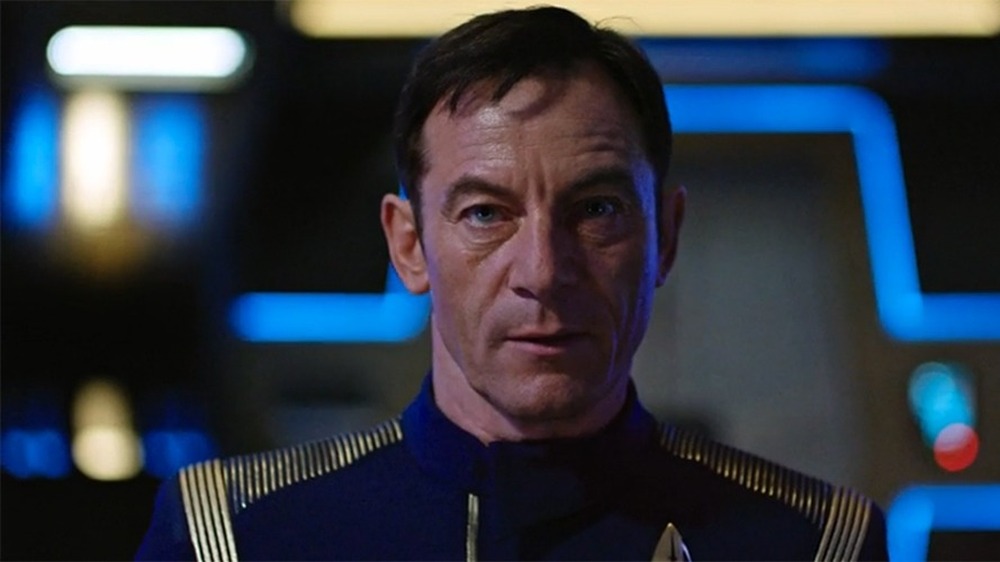
For most of Star Trek: Discovery 's inaugural season, Jason Isaacs' Captain Gabriel Lorca commands the eponymous vessel. While he has a mysterious air early in the series, you're convinced he's the real deal because of his leadership skills and what appears to be an unwavering dedication to his crew.
That changes after the Discovery winds up in the Mirror Universe in the final moments of "Into the Forest I Go." For most of the time Discovery is in this strange, much more brutal reality, no one seems to know exactly how they got there. It isn't until the third-to-last episode of the season, "Vaulting Ambition," that we learn Gabriel Lorca is a Mirror Universe native. Having switched places with his Prime counterpart before the events of the series, Lorca sees the potential of Discovery 's spore drive to bring him back home so he can continue his rebellion against Emperor Philippa Georgiou (Michelle Yeoh).
Arguably, just the fact that Lorca is able to pull the wool over so many viewers' eyes is enough reason to earn him a spot on this list. But Isaacs' superb acting and the layered conception of the character earn the accolades all on their own. Lorca is able to fool us precisely because he isn't simply a mustache-twirling bad guy. While he's using the Discovery crew for his own ends, he bears no ill will toward them, and in some ways, the respect and care he shows for them is genuine ... until it isn't.
Shran walks the line between friend and foe
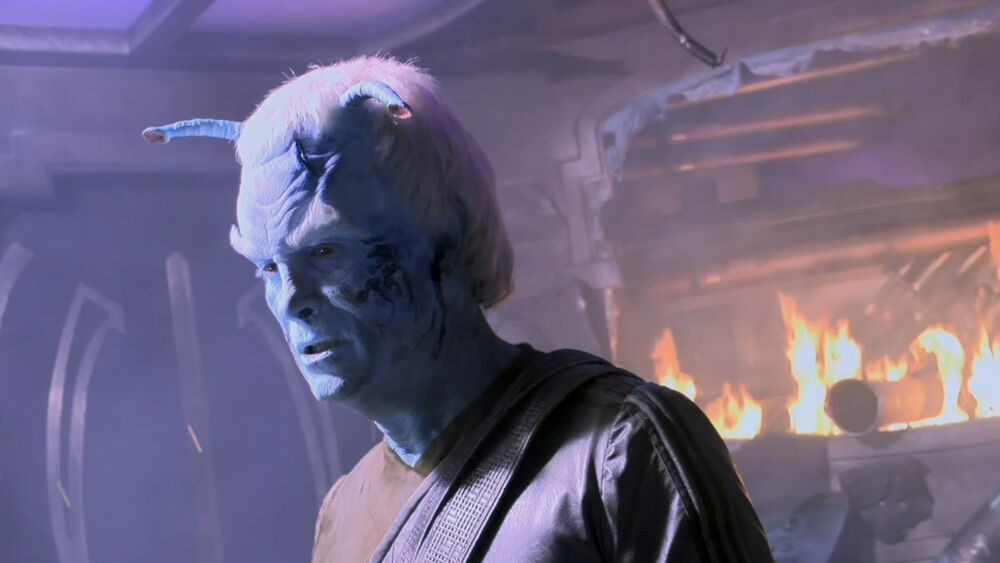
A lot of fans would balk at the idea of the blue-skinned Commander Shran being labeled a villain. Portrayed by Jeffrey Combs — who's played more roles on Star Trek shows than most — Shran is an Andorian fiercely loyal to his people who's introduced in Star Trek: Enterprise 's ( ENT ) first season. We meet Shran in "The Andorian Incident" when he leads a squad of his blue-skinned brethren in the violent takeover of a Vulcan monastery. Shran and the other Andorians come off as paranoid and xenophobic bullies. But in spite of their thuggish behavior, Captain Archer (Scott Bakula) discovers they're right about the monastery being a cover for a Vulcan facility monitoring the Andorians. When Archer exposes the truth, he earns an uneasy ally in Shran.
Shran comes to the aid of Archer and the Enterprise on more than one occasion. In particular, in season 3, Shran bails the heroes out twice, including in the final battle to save Earth from the Xindi's doomsday weapon. But there's always a volatility working under Shran's surface, threatening to once more put him at odds with Archer and his crew. It happens, for example, in season 4's "United" when Shran's stubborn refusal to give the Tellarites the benefit of the doubt leads to Archer challenging him to a death duel.
Commander Kruge is one scary Klingon
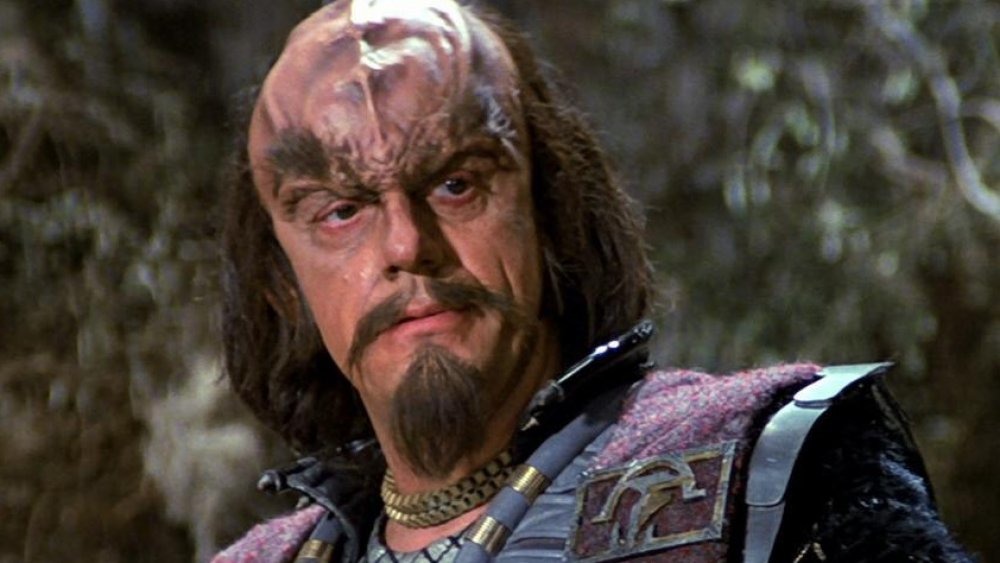
For the most part, Christopher Lloyd 's most famous characters – like Doc Brown in the Back to the Future series — aren't particularly intimidating. So it's a testament to the actor's range that he performed so well as the Klingon Commander Kruge in 1984's Star Trek III: The Search for Spock . When Kruge learns of Starfleet's secret Genesis project — meant to instantly turn lifeless celestial bodies into habitable planets — he means to seize it as a doomsday weapon for the Klingon Empire. In the process, he orders the murder of Captain Kirk's son — a death that scars Kirk for years.
In many ways, Kruge is the first example of the kind of Klingon we'd see in the subsequent Trek movies, as well as the Star Trek: The Next Generation era of TV series. While the Klingons' new look is seen briefly in 1979's Star Trek: The Motion Picture , it isn't until Kruge that we get to see a fully fleshed-out performance. While the Klingons were always warlike, Kruge and his crew are more brutish than their predecessors in TOS. Locking himself in a death grip with an alien beast just for fun and going mano a mano with Kirk as Genesis is in its explosive death throes, Kruge gives us a portrayal of what remains one of the most potent examples of the Klingon passion for combat.
Benjamin Sisko is no fan of Michael Eddington
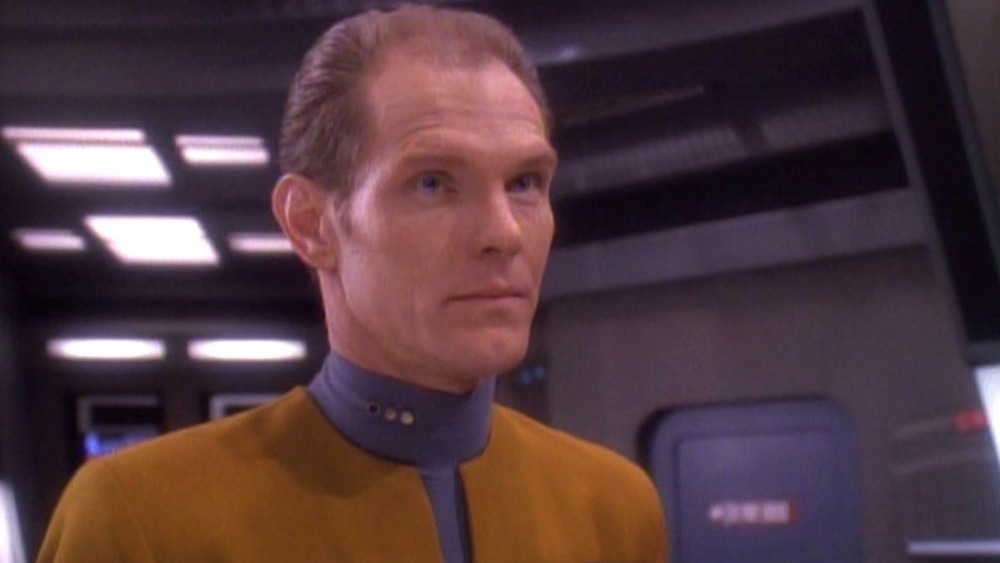
You don't find a lot of Trek villains wearing Starfleet uniforms. After all, the desire to join Starfleet is usually accompanied by a drive to uphold the values of the United Federation of Planets . But one notable exception is Lieutenant Commander Michael Eddington (Kenneth Marshall). Introduced in DS9 's season 3 premiere, Eddington starts out as an officer who appears to be overly concerned with promotion and more than willing to turn in the heroes of DS9 if they dare disobey their Starfleet superiors.
Toward the end of season 4, we learn Eddington's seemingly tireless devotion to Starfleet is a ruse. In "For the Cause," Eddington tricks most of DS9's command crew away from the station, and in their absence, he steals a shipment of industrial replicators, revealing himself as a member of the Maquis — a group of violent rebels who oppose the Federation's treaty with Cardassia and wage relentless guerrilla war against the aliens.
The very fact that Eddington is able to pull the wool over his eyes makes Benjamin Sisko (Avery Brooks) obsessed with capturing the traitor. He's one of the few villains capable of getting so thoroughly under a series captain's skin, to the point where Sisko actually humors some rather questionable tactics in apprehending him.
Harry Mudd is a truly conniving Star Trek villain
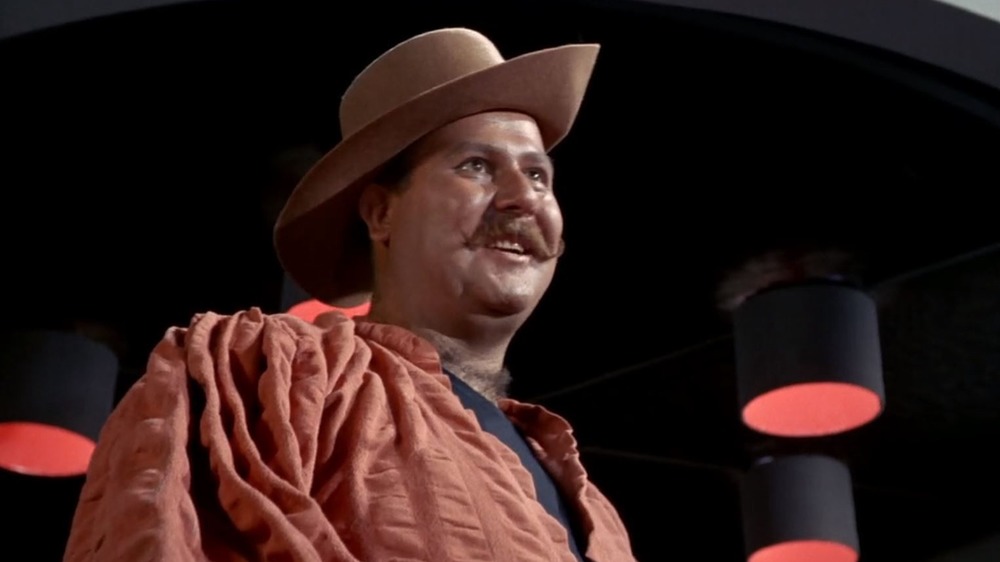
The flamboyant and deceptive Harry Mudd is one of the few named antagonists from TOS to enjoy a second appearance. He first shows up played by Roger C. Carmel in season 1's "Mudd's Women," trying to sell women like cattle and using an illegal drug to render them physically irresistible. Later in season 2's "I, Mudd," the con man gives up the Enterprise crew to a group of androids with dreams of galactic conquest.
Carmel returned to voice his famous crook in "Mudd's Passion," an episode of Star Trek: The Animated Series . He runs afoul of the Enterprise once more after attempting to con the inhabitants of an alien planet into believing he could sell them Starfleet Academy.
That wouldn't be the end of Mudd. Rainn Wilson (best known as Dwight Schrute on The Office ) plays a more vicious version of Harry Mudd in Star Trek: Discovery 's ( DISCO ) first season. Captain Lorca (Jason Isaacs) meets Mudd in "Choose Your Pain," when they're both prisoners of the Klingons, and Mudd is more than happy to give up his fellow humans to avoid a beating or two. After Lorca and Lieutenant Ash Tyler (Shazad Latif) leave Mudd behind when they escape the Klingons, the con man gets revenge with a plot involving a time manipulation device in "Magic to Make the Sanest Man Go Mad."
Luther Sloan is a complicated character
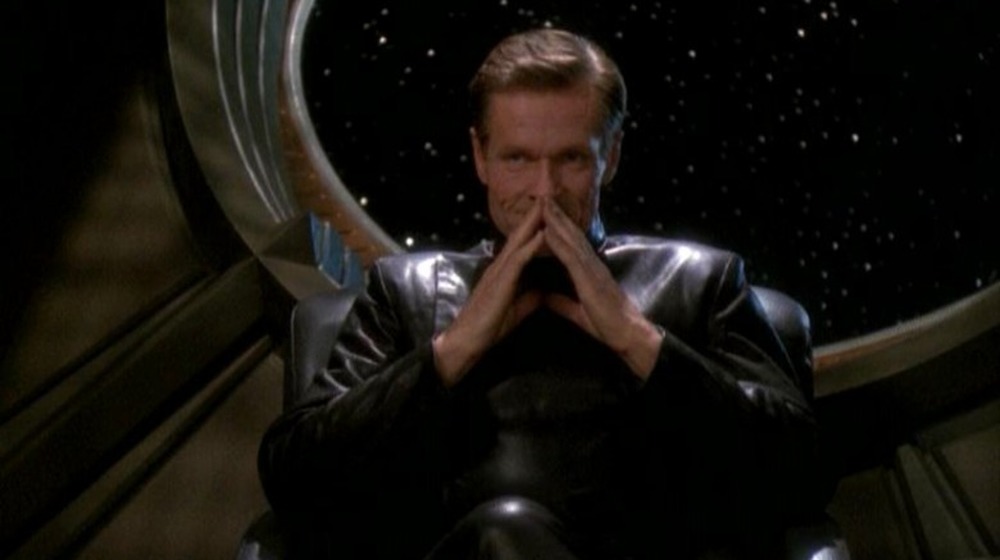
One of the most popular pieces of Trek mythology introduced by DS9 is the clandestine organization Section 31. And William Sadler's brilliant performance as Luther Sloan — the director of Section 31 during the events of DS9 – is one of the main reasons for the group's popularity.
Suspecting Dr. Bashir (Alexander Siddig) of being an unwitting spy for the Dominion, Sloan first shows up on DS9 using a holodeck to find out the truth. He subjects Bashir to an elaborate illusion, in which all of his friends on DS9 turn their backs on him. Once Bashir discovers the truth, Sloan is convinced of Bashir's innocence and offers him a position with Section 31. In spite of Bashir's clear refusal, Sloan soon returns to use the doctor in a covert operation involving infiltration of the Romulan Empire. Toward the end of the series, we learn Sloan is behind poisoning Odo (Rene Auberjonois) and all of his people with a deadly plague.
Sloan is a singular Trek villain. He's ruthless, cunning, and mysterious, but he's surprisingly sympathetic. He's aware of the hypocrisy of betraying the Federation's core values in order to protect it, yet he still believes in what he's doing and has no ill will towards Bashir for despising him. He sees Bashir as exactly the kind of man he was born to protect, even if in safeguarding him, he earns nothing but Bashir's disgust.
Intendant Kira is one of Star Trek's most sadistic bad guys
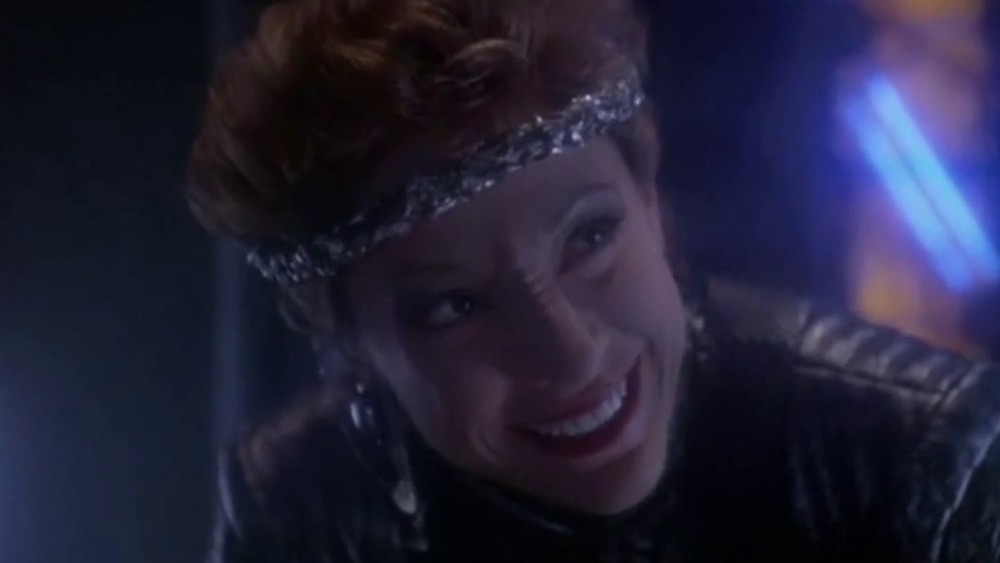
Introduced in TOS ' "Mirror, Mirror," the Mirror Universe is an alternate dimension where the Federation is replaced by the tyrannical Terran Empire. Rather than living by values like tolerance, diplomacy, and discovery, the Terrans are a brutal people believing in conquest and cruelty. But in DS9 's "Crossover," Dr. Bashir and Major Kira (Nana Visitor) find themselves in the alternate universe, where they learn that since the events of TOS , the Terran Empire has been conquered by the Klingon-Cardassian Alliance. Terrans have become a slave race, and DS9 — retaining its original Cardassian name Terok Nor — is led by Intendant Kira.
Intendant Kira is the cold-blooded counterpart to Major Kira, and the character gives Visitor a chance to show us her acting range. Other than the Kiras of both universes sharing the quality of natural leadership, Intendant Kira is a wild departure from Major Kira. She's seductive, with an unapologetically endless appetite for pleasure, using Sisko — a pirate in the Mirror Universe — as her personal plaything. She's as vicious as any of the Cardassians or Klingons under her command and deceptively sadistic, sometimes acting as if she's about to absolve her victims before ordering their executions.
Intendant Kira was far too much fun for just a single DS9 episode. She's a recurring villain, including showing up for all of DS9 's Mirror Universe stories.
Kai Winn's tale is a tragic one
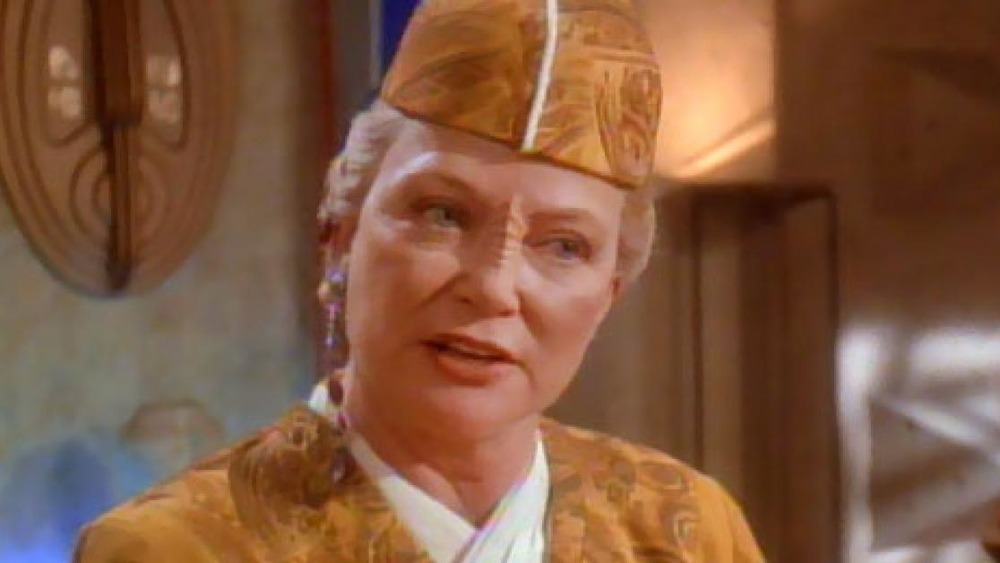
You hear a lot about villains you "love to hate." But then there are villains you just straight-up hate. Kai Winn is definitely one of the latter.
Louise Fletcher — Nurse Ratched in 1975's One Flew Over the Cuckoo's Nest — plays Winn on DS9 , beginning as an ambitious vedek of a rigid religious order on Bajor. Winn is a slippery and manipulative vedek, working behind the scenes in coup and assassination attempts. Her actions, she claims, are always at the service of the Prophets — the aliens living inside the wormhole who the Bajorans worship as gods — yet it seems she's always working towards her own ascension in the ranks of Bajor's clergy. She succeeds in becoming Bajor's spiritual leader, the Kai, but by the end of the series, her jealousy towards Ben Sisko, her seduction by Gul Dukat (Marc Alaimo), and her anger toward the Prophets leads her to finally abandon her religion and follow the devilish Pah-wraiths.
Winn is one of the most interesting and complex villains in all of Trek . Her downfall is tragic in the most classic sense of the word. Once she wins the title of Kai, rather than simply basking in her power as we expect, she seems to genuinely want to help her people. The problem is, of course, she also seems to fully believe that the ends justify any and all means.
Weyoun steals the spotlight with his manipulative charm
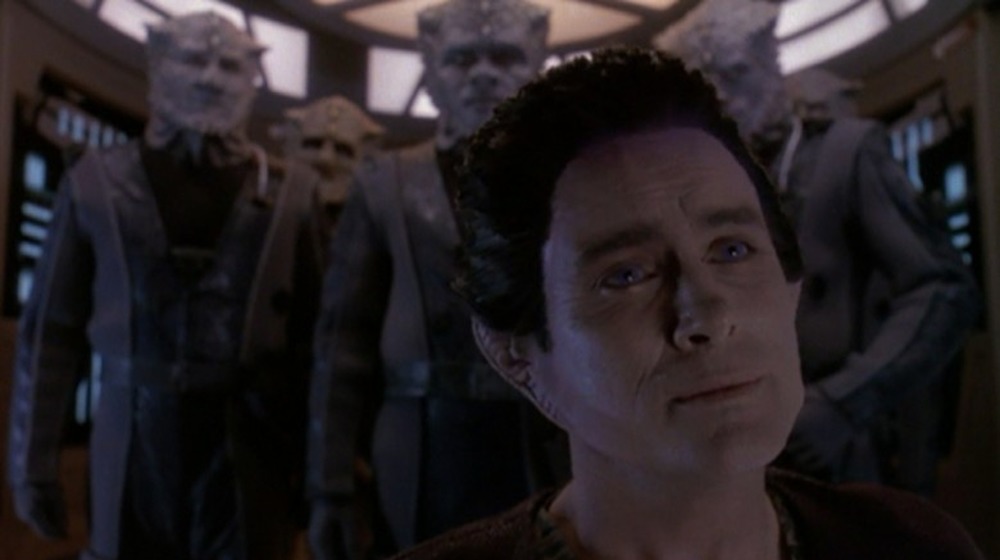
What if you could genetically engineer a race to be equally cunning leaders and diplomats in the most hostile of situations? What you come up with might look a lot like the Vorta, the Dominion's lieutenant race, leading the hordes of brutal Jem'Hadar while being completely subservient to the Founders. And of the Vorta we meet on DS9 , none is more memorable than Jeffrey Combs' Weyoun. While Weyoun dies at the end of his first appearance in season 4's "To the Death," the villain was just too good to keep dead. So, it was decided that the Founders keep clones of the Vorta always at the ready, complete with the memories of their predecessors.
As the head of the Dominion's military in the Alpha Quadrant, Weyoun shows up often in the last two seasons of DS9 , and he steals every scene he's in. He's dishonest and manipulative without shame, ready to shift from intimidating to conciliatory at a moment's notice. In scenes with politically influential DS9 characters like Ben Sisko and Gul Dukat, Weyoun uses conversation like a deadly, evasive weapon — always adapting to his counterpart's mood with everything from wrath to abject apology. He lies so easily that you wonder whether or not Weyoun knows, or even cares, what's true or false.
The Prime Universe's Khan Noonien Singh is obsessed with revenge
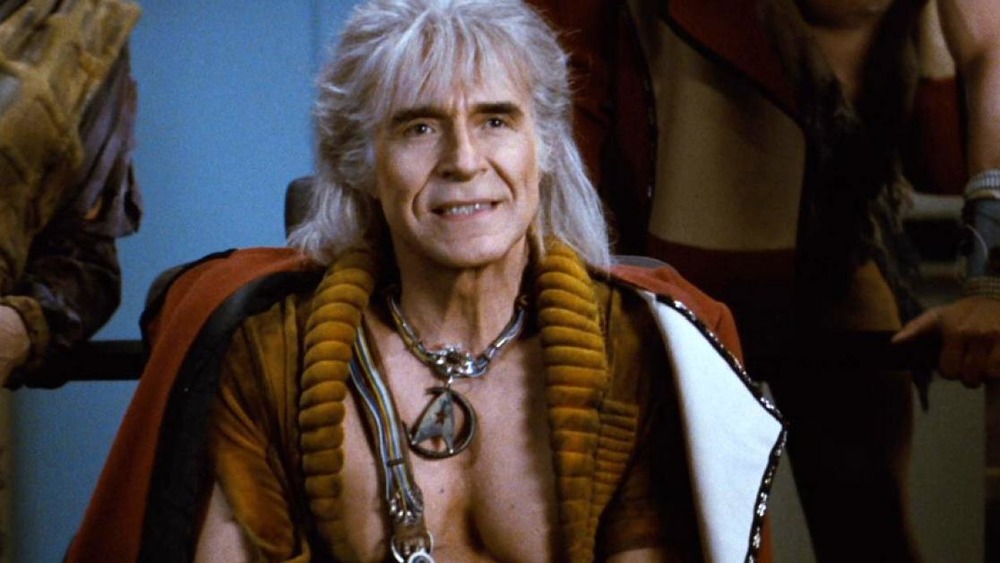
Any list of best Star Trek villains that doesn't include Ricardo Montalban's Khan needs to delete everything and start over. First appearing in TOS 's "Space Seed," Khan is a genetically enhanced despot who ruled over a quarter of the Earth before escaping the Eugenic Wars with 84 of his followers. The Enterprise crew soon regrets waking Khan and his people from suspended animation once they take over the ship.
While Khan is a fun villain in his first appearance, his appeal doesn't reach full bloom until 1982's Star Trek II: The Wrath of Khan , arguably the best Star Trek movie ever . Blaming Kirk for the tragedies that have befallen him since they crossed paths years earlier, Khan and his followers take over the U.S.S. Reliant and wage war on the Enterprise . While Khan's followers believe they're using the stolen Federation property for power and prosperity, it's soon clear their leader is willing to sacrifice everything — including his own life and theirs — to get revenge on Kirk.
Through Montalban, Khan becomes the absolute embodiment of all-consuming vengeance. The villain regularly either paraphrases or directly quotes lines from Herman Melville's novel Moby Dick . And just as Captain Ahab is obsessed with destroying the titular whale, Khan ultimately has no purpose left but vengeance against Kirk.
The Borg Queen is equal parts sexy and scary
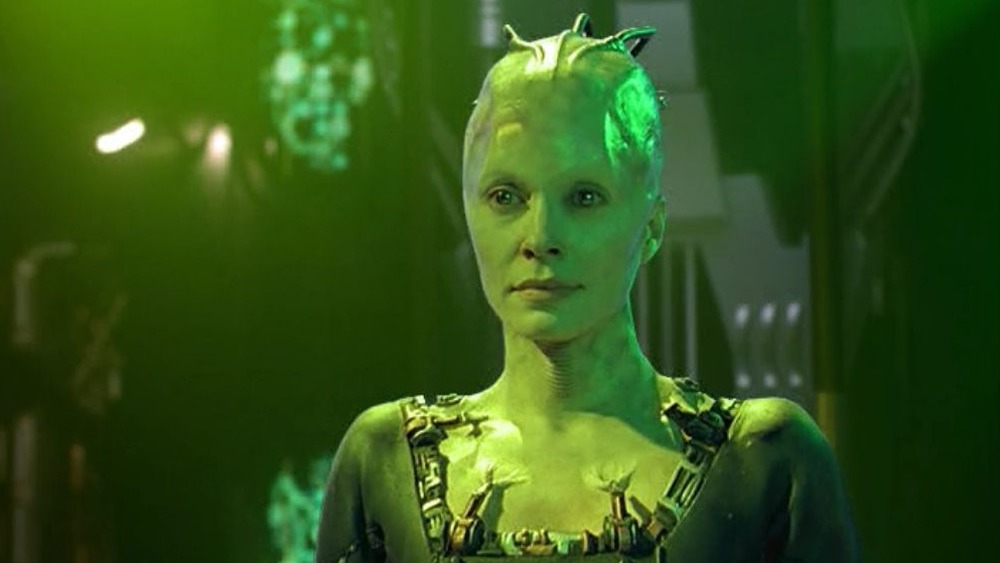
In TNG 's "Q Who," the Borg — one of the Federation's deadliest enemies — are introduced. The cybernetic, zombie-like, hive-minded bad guys kill with impunity. However, their goal is not to kill but to assimilate the technology and biology of other intelligent species into their collective to bring them closer to perfection. There are no individuals within the Borg Collective, but in 1996's Star Trek: First Contact , we're introduced to the Borg Queen, the living embodiment of the Collective's will.
The Borg Queen does something you wouldn't think possible with the Borg — she makes them sexy. In fact, she spends most of her scenes in First Contact seducing Data (Brent Spiner) with promises of pleasures he's never been capable of fully experiencing. But she's far from just a temptress. Particularly in her subsequent appearances in Star Trek: Voyager ( VOY ), the Borg Queen — played by both Alice Krige and Susanna Thompson at different points — conveys the singular horror of being confronted by a being who is, in her own words, "one who is many."
Speaking to Looper in early 2020 , Krige shared interesting insights about playing the cybernetic villain, including just how old she thinks the Borg Queen is. "I think she was an entity that happened at the moment of creation," Krige explained. "And she's always been that and she always will be, and it is entirely abnormal."
Q is a delightfully devious trickster
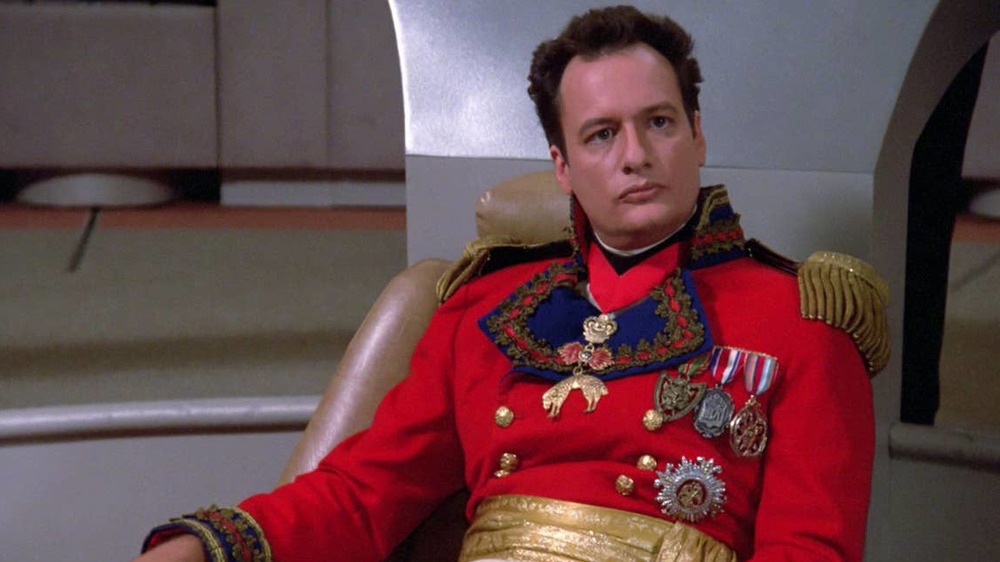
Perhaps no other single villain has appeared in as many Star Trek series as John de Lancie's all-powerful Q. Showing up for the premiere of TNG , its finale, and a bunch of fun episodes in between, Q is a mischievous, godlike being who defies definition. He would eventually come to harass VOY 's Captain Janeway (Kate Mulgrew) almost as much as he does Picard (Patrick Stewart), along with making brief but memorable appearances on DS9 and Star Trek: Lower Decks .
Hilarious and carefree, Q is so popular that it might be a problem for some fans to even call him a villain. But while he isn't wholly evil, he's certainly a villain in the sense that when he shows up, he's almost always an antagonist. While he usually reverses any direct harm he inflicts upon humans, he couldn't care less about those lost indirectly, such as the Enterprise crew members killed by the Borg in "Q Who."
Whether you see him as a good guy or a bad guy, de Lancie's portrayal of the trickster is one of the most delightful parts of TNG and VOY . Without him, after all, we'd never see a mariachi band on the Enterprise bridge, we'd never see Guinan plunge a fork into a dude's hand, and most importantly, we'd never see the Enterprise crew in Sherwood Forest.
Dukat is Star Trek's greatest villain
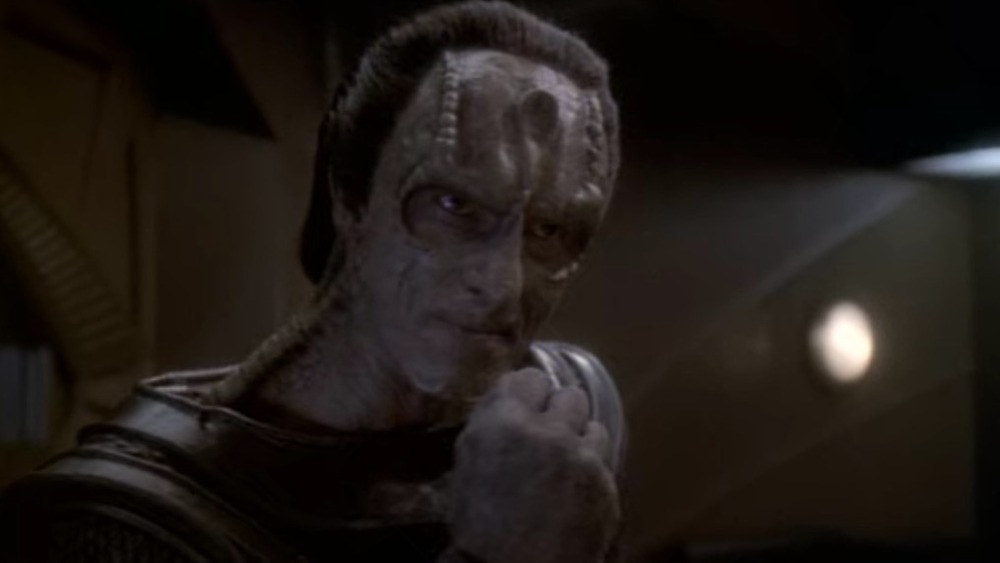
One of the places where DS9 excels over other Trek series is that its serialized storytelling allows for characters to evolve. And you can see this evolution clearly in the Cardassian tyrant Gul Dukat. Formerly the prefect of Bajor during its occupation, Dukat is none too happy to find a human sitting in his old office in DS9 's premiere, and his fixation on Sisko and his crushing sense of inadequacy grow over the course of the series, to the point where it suffocates him.
The Dukat we meet in DS9 's premiere isn't the Dukat we see in its finale. A characteristic Cardassian, Dukat spends the first few seasons of DS9 working towards the goal of once again finding himself ruling over the people of Bajor. He's not only unwilling to face the atrocities he committed, but he's so delusional that he harbors resentment for the Bajorans refusing to honor him with statues and plaques. For a time, he's something of an ally to the DS9 crew, but when the Dominion gives him an opportunity to seize control over all of Cardassia, he becomes the Alpha Quadrant's most feared warlord. Before the end of the series, he goes from conqueror to madman, madman to cult leader, and from cult leader to the powerful vessel of the Pah-wraiths — the Prophets' destructive adversaries.
Wonderfully portrayed by Marc Alaimo, Dukat is ultimately the most complex, believable, and twisted villain in all of Star Trek .
- The Best ‘Star Trek’ Villains Who Give Starflee...
- Interesting Characters
- Episodes That Get You Hooked
- The Best Series and Movies, Ranked
- Original Series Trivia
- Accidents with the Transporter
- 'Make It So' - Picard
- Exasperated Picard
- Store-Bought Items Used as Props
- Every 'Star Trek' Captain, Ranked By True Trekkies
- Secrets from the Wardrobe Dept.
- The Greatest Star Trek Insults
- Times Scotty Saved the Day
- Fun Facts About the New Film Series
- Celebrating Spock and Bones McCoy
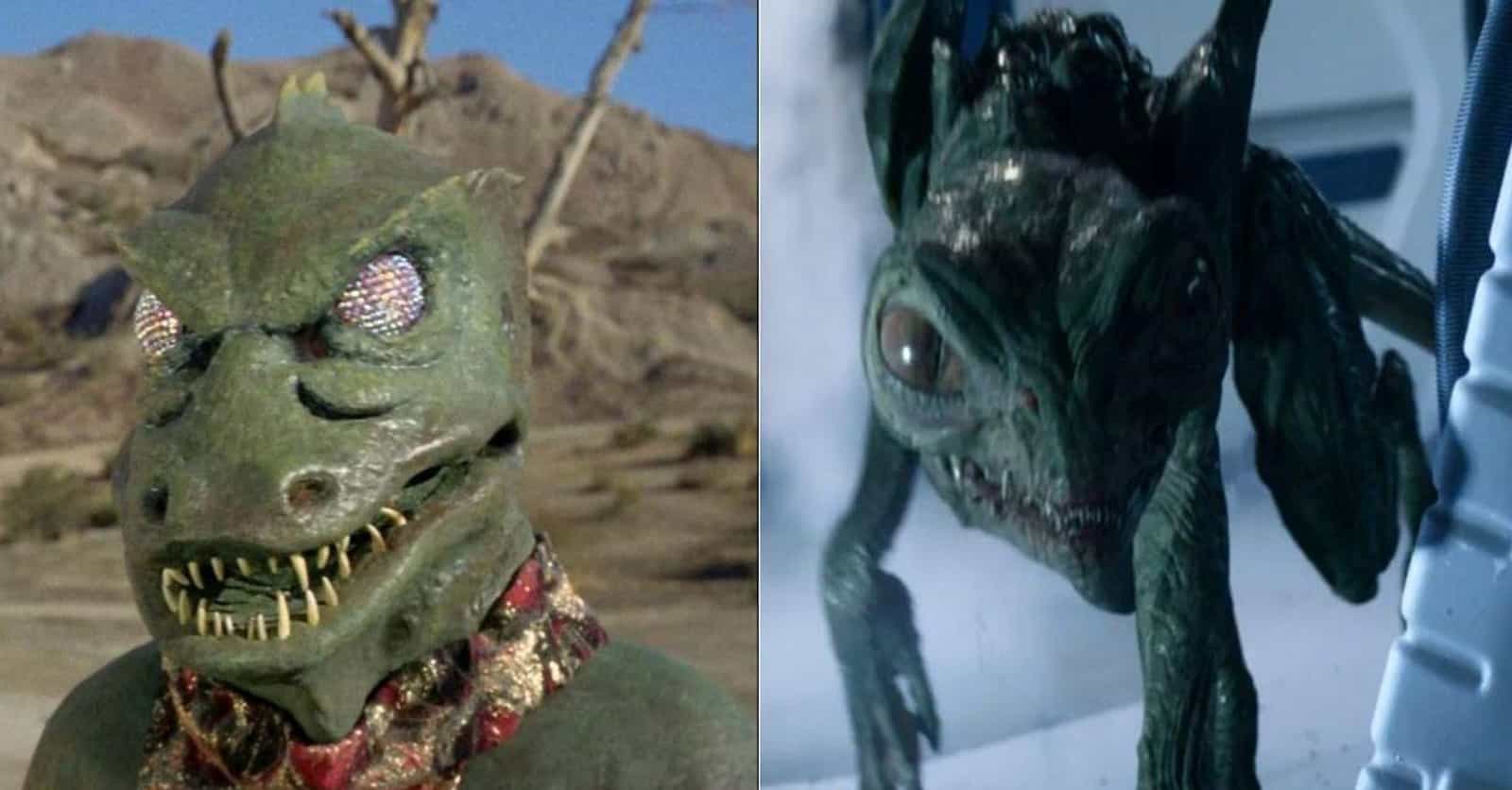
The Best ‘Star Trek’ Villains Who Give Starfleet Nightmares
Vote up the Star Trek villains who are a blight on the final frontier.
Few science fiction franchises have been as enduring or as popular as Star Trek. Sprawling across numerous media, it has drawn in legions and generations of fans who welcome the opportunity to lose themselves in this alternate world. Like all great sci-fi, Star Trek is populated by many infamous villains.
While some take the form of races and groups opposed to the Federation, the most fascinating are the individuals who have posed a danger to Kirk, Picard, and other notable captains and crew members journeying across the final frontier . These are the figures who stay with the viewer long after the episode itself is over - a perpetual reminder of the many guises villainy can take.
Khan Noonien Singh

- Star Trek II: The Wrath of Khan
- Paramount Pictures
Appears In: Star Trek: The Original Series; also appeared in Star Trek II: The Wrath of Khan and Star Trek Into Darkness
Species: Augmented human
Background: As one of a group of superhumans, Khan solidified control of a major part of Earth, with a domain that encompassed much of Asia. Although he was incredibly powerful, he wasn’t nearly as despotic as he might have been (and certainly not like many of his fellow superhumans). He was deposed, but managed to escape Earth and was cryogenically frozen until discovered by the Enterprise.
Why He's A Bane To Starfleet: Khan attempts to take over the Enterprise in an episode of the original series, after which Kirk defeats him. However, he returns in The Wrath of Khan, set on vengeance . He comes perilously close to killing Kirk - whom he's determined to destroy to avenge being left to die - but ultimately fails.
Khan also served as the main antagonist of Star Trek Into Darkness , albeit with slightly different motivations. He's forced to develop superweapons for Admiral Marcus, after which he rebels and tries to take over the Enterprise, before being defeated by Spock.
The Borg Queen

- Star Trek: First Contact
Appears In: Star Trek: First Contact; also appears in Star Trek: Lower Decks, Star Trek: Voyager, and Star Trek: Picard
Species: Borg
Background: As her name suggests, she is the epitome of the collective consciousness of the species known as the Borg. In many ways, she's the guiding intelligence of the collective as a whole. In addition to being ruthless in her approach to all other life in the universe - which she sees as inherently inferior to the Borg - she also views her role as bringing order to chaos.
Why She's A Bane To Starfleet: After her initial appearances, she became one of the most powerful and potent threats faced by the crew of the Enterprise. Unsurprisingly, her primary goal was the propagation of the Borg, even if this meant the extinction of all other life forms.
She pursued this with relentless efficiency even though - like many other great Star Trek villains - she also had moments of complexity, particularly once she started to feel the sting of loneliness and despair . Although she was a formidable foe, she was beaten many times before her final demise in Picard.

- Star Trek: The Next Generation
- Paramount Domestic Television
Appears In: Introduced in Star Trek: The Next Generation; also appears in Star Trek: Deep Space Nine, Star Trek: Voyager, Star Trek: Lower Decks, and Star Trek: Picard
Background: Part of what makes Q such a compelling Star Trek villain is just how little is known about him/them. As the ambiguity of the name suggests, Q is a being of almost incomprehensible power and abilities, and seems to delight in showing off its superiority to humans. Q is particularly invested in making sure humans aren’t becoming a threat to other elements of the universe .
Why They’re A Bane To Starfleet: In earlier appearances, particularly in The Next Generation, Q enjoys posing various challenges to members of the Enterprise. In part, these are opportunities for humanity to prove its worth, but they also seem to be for the being’s own amusement. Among other things, Q puts the crew on trial, and even temporarily gives Riker the power of a Q - again, as a sort of test. As the series goes on, and in subsequent iterations, Q proves to be an ally and teacher to Picard and to other humans. At the end of Picard , it's unclear if Q still exists.

- Star Trek: Deep Space Nine
Appears In: Star Trek: Deep Space Nine
Species: Cardassian
Background: A member of the Cardassian race, Gul Dukat for a time ruled over the planet of Bajor. While charming and charismatic, he's also shown to be very authoritarian, ruling with an iron fist. He was particularly embittered once his position was taken away from him.
Why He's A Bane To Starfleet: Dukat was one of the most potent villains faced by Benjamin Sisko, the commanding officer of Deep Space Nine . The two clashed numerous times throughout the series, and Dukat was determined to get back what he thought was rightfully his. Perhaps the gravest threat he posed, however, occurred when he allied himself with the Pah-wraiths , sinister beings who possessed his body. He's ultimately foiled and imprisoned forever, thanks once again to Sisko.

- Star Trek: The Original Series
Appears In: Introduced in Star Trek: The Original Series; also appeared in Star Trek: Enterprise and Star Trek: Strange New Worlds
Species: A humanoid reptilian species
Background: Even before Captain Kirk and the Enterprise encountered one of the Gorn, there had been other moments of contact between this species and the Federation. They were notorious for their predatory attitude toward any warm-blooded creatures, including humans.
Why They’re A Bane To Starfleet: The most notable incident concerning the Gorn on-screen is when Kirk has to engage one in hand-to-hand combat. It initially seems as if the creature might defeat him, but he eventually emerges victorious. In typical Kirk fashion, however, he shows the creature mercy rather than killing it. After decades of obscurity in the Star Trek universe, the Gorn returned in Strange New Worlds , updated as a violent threat for Captain Christopher Pike, despite the series taking place a decade before the Gorn's initial appearance in The Original Series .
General Chang

- Star Trek VI: The Undiscovered Country
Appears In: Star Trek VI: The Undiscovered Country
Species: Klingon
Background: As a Klingon, Chang was a skilled warrior who took a dispassionate and sometimes ruthless view toward the world. He harbored a particular dislike for the Federation, and was motivated by the belief that war cannot be prevented. Given his prowess as a warrior, he understandably took part in several conflicts within the Klingon Empire.
Why He's A Bane To Starfleet: Given his longstanding antipathy to the Federation, Chang was particularly angered by the prospect of his beloved Empire turning to them for any kind of assistance, which did indeed happen. He joined a conspiracy whose sole intention was to keep the Empire and Federation from declaring peace, which caused the demise of several of his own people, including Chancellor Gorkon.
Chang went to extraordinary lengths to destroy the peace process, even though he was ultimately destroyed by the Enterprise, despite using an invisible ship to launch attacks.

Appears In: Star Trek: The Next Generation; also appears in Star Trek: Picard
Species: Soong-type android
Background: Lore was created by human cyberneticist Dr. Noonien Soong. The android was highly sophisticated, but Soong soon realized he was malevolent and destructive , and decommissioned him. Before that, however, Lore orchestrated the destruction of life on Omicron Theta.
Why He's A Bane To Starfleet: Lore was discovered by the Enterprise, and it wasn’t long before he was wreaking havoc again. Among other things, he deactivated his sibling android Data and assumed his identity. In Lore's first appearance, he tried to give the crew up to the being known as the Crystalline Entity . He also enslaved a group of Borg (whom he programmed to kill rather than assimilate others), and for a time he even managed to bring Data under his sway.
In The Next Generation , he was ultimately defeated by Data and disassembled, including the destruction of his “brain.”

Appears In: Introduced in Star Trek: The Next Generation; also appears in Star Trek: Deep Space Nine
Background: After his initial appearance in The Next Generation, Gowron became Chancellor of the Klingon Empire. Throughout the series he faced a number of challenges to his position, sometimes necessitating intervention from Picard and others on the Enterprise.
Why He's A Bane To Starfleet: Gowron became more of an antagonist in Deep Space Nine. Among other things, he disinherited Worf and his entire family, and attempted to force Benjamin Sisko to surrender Gul Dukat and the rest of the Detapa Council . He was repeatedly prone to challenging the Federation with demands, no matter how unreasonable, which ultimately led to a shattering of the peace between the Klingon Empire and the Federation. Wolf eventually killed him in hand-to-hand combat.
Kai Winn Adami

Species: Bajoran
Background: Winn was a steadfast believer in the Prophets , which earned her imprisonment when the Cardassians ruled her planet, Bajor. At the same time that she developed a rigid adherence to orthodoxy, she also became bitter at the Prophets, whom she believed never spoke to her as she deserved, given her sacrifices. She repeatedly showed a subtle political mind, and was willing to ally herself to whoever would give her what she wanted .
Why She's A Bane To Starfleet: Winn was a particularly inveterate enemy to Benjamin Sisko, whom she resented due to his status as Emissary of the Prophets. Aside from her various manipulations, she also became one of the primary antagonists as Deep Space Nine reached its conclusion; she even went so far as to ally herself with none other than Cardassian villain Gul Dukat, joining his efforts to release the Pah-Wraiths. Fortunately for Winn, she ultimately returned to the side of good, though this led to her destruction at Dukat’s hands.
Gary Mitchell

Appears In: Star Trek: The Original Series
Species: Human
Background: Throughout his life, Gary Mitchell demonstrated remarkable skill with guessing games, which may have had something to do with his ancestry - many of his family members possessed extrasensory perception. He also had a long history with Captain Kirk, as the two met at Starfleet Academy. They had also conducted several missions together, where Mitchell demonstrated remarkable telepathic abilities.
Why He's A Bane To Starfleet: Things took a turn for the worse for Mitchell when the Enterprise passed through a galactic barrier, which made his telepathic abilities ever stronger. Unfortunately, a side effect was a major personality change; he became a megalomaniac, convinced of his own power and superiority . He was eventually overpowered by Kirk and Dr. Elizabeth Dehner, and was buried beneath tons of rock.

Species: Vorta
Background: Weyoun was a Vorta , a race of violet-eyed, genetically modified humanoids serving in the Dominion. He had been cloned numerous times over the years.
Why He's A Bane To Starfleet: Like many others of his kind, Weyoun’s various iterations were deployed by the Dominion in its war against the Federation. Weyoun 5, for example, was a personal aide to Gal Dukat. Possibly the most sinister of the clones was Weyoun 8, who played a key role in a Cardassian genocide before meeting his death at the hands of Cardassian Elim Garak.

- Star Trek III: The Search for Spock
Appears In: Star Trek III: The Search for Spock
Background: As a member of the House of Kruge, he belonged to very powerful political family, with the resultant connections and influence. His full name was a mouthful: Kruge sutai-Vastal . By the opening of The Search for Spock , he had also long been a member of the Klingon Defense Force.
Why He's A Bane To Starfleet: In the film, Kruge believed the device used to transform the planet Genesis was a weapon, which is why he captured those present on the planet, setting up a confrontation with Kirk and others on the Enterprise. Kruge proved himself to be a violent and unpredictable adversary, but was ultimately outwitted by Kirk, who had the Enterprise self-destruct. The two ultimately engaged in a hand-to-hand duel, in which Kirk defeated Kruge by kicking him over a cliff.
Captain Gabriel Lorca

- Star Trek: Discovery
- CBS/Paramount+
Appears In: Star Trek: Discovery
Background: The man known in the primary universe as Gabriel Lorca was, in fact, the Lorca from the Mirror Universe, who at some point had taken over the identity of his counterpart. Previously, he served as a lieutenant for Empress Philippa Georgiou. Lorca was at one point the captain of the Buran and later became captain of the Discovery.
Why He's A Bane To Starfleet: In the primary universe, Lorca was shrewd and manipulative, particularly when it came to Captain Michael Burnham. His real purpose was always to unseat the Empress; he was willing to do anything necessary to bring this goal to fruition, no matter how much damage it might cause to the primary universe (and the damage was indeed extensive). However, Lorca was ultimately defeated by Georgiou herself, who stabbed him with a sword and threw him into a reactor. The fate of the primary Lorca remains unknown.

Appears In: Star Trek (2009)
Species: Romulan
Background: Nero was a miner, and the master of the ship Narada. However, his planet was destroyed by a supernova, which engendered in him a relentless thirst for revenge . When he was caught in a black hole and sent back in time, he killed Captain George Kirk, setting in motion an alternate timeline and changing the fate of George's son, James T. Kirk. Nero also managed to leave an alternate Spock - who had tried to save Romulus but failed - stranded on a distant planet.
Why He's A Bane To Starfleet: Nero is the primary antagonist of the new timeline established in 2009’s Star Trek. His primary motivation was to get revenge on anyone he thought was responsible for the destruction of his planet, which included Spock (both the one from his timeline and the alternate one). Among Nero's many heinous actions was setting in motion the destruction of Vulcan by a black hole. He clearly intended the same for Earth, but was foiled by Spock, who created a black hole into which Nero and his ship disappeared.

- Star Trek: The Motion Picture
Appears In: Star Trek: The Motion Picture
Species: Machine entity / Space probe
Background: V’ger began as a space probe sent into outer space by humans, appropriately named Voyager 6 . It later became lost in a black hole, after which it gained sentience thanks to the intervention of an alien race of thinking machines. It subsequently gave itself a new name .
Why They’re A Bane To Starfleet: V’ger’s main purpose was to fulfill its original mission: learn everything possible about the universe and take this information back to Earth. Given how much power and knowledge it came to wield, it nearly destroyed its very creators in the process, and to further complicate matters, it began seeking answers to vast existential questions. Fortunately, its threat to destroy Earth if its questions weren't satisfied was averted when the new captain of the Enterprise merged with the being, giving it the answers it craved.
Talak’talan

Species: Jem'Hadar
Background: Talak’talan was a reptilian creature who served the Dominion as part of a corps of shock troops beholden to the Founders, the Jem'Hadar. This regularly put them in conflict with others, and the Jem'Hadar were known for their belligerence and their tendency to resort to violence (including genocide).
Why He's A Bane To Starfleet: Talak’talan captured Commander Benjamin Sisko and several others when they made their way into the Gamma Quadrant. He made no secret of his contempt for humans (he had hoped to connect with Klingons), and he also did not give Sisko any of the information he desired. Though a relatively minor antagonist, it was still clear Talak’talan was not one to be trifled with. His ultimate fate remains unknown.

Species: Breen
Background: Thot Gor was a Breen, a race with a longstanding conflicted relationship with the Federation, and with humans in particular. Their most notable allies were the Dominion, who likewise had a bellicose dynamic with the Federation. Gor and other Thots served as high-ranking military officers among the Breen.
Why He's A Bane To Starfleet: Gor was one of those most responsible for forging an alliance between the Breen and the Dominion against the Federation. He showed himself to be a formidable military leader, particularly in the attack on San Francisco and in the Battle of Chin'toka. He was eventually succeeded by Thot Pran under unclear circumstances.
- Entertainment
- Star Trek Universe
- Watchworthy
- Fictional Characters
Live long, and prosper.

The 10 Best 'Star Trek: The Next Generation' Villains, Ranked

Your changes have been saved
Email is sent
Email has already been sent
Please verify your email address.
You’ve reached your account maximum for followed topics.
10 Movies To Watch if You Love 'Only Murders in the Building'
The 10 worst castings in superhero movies, ranked, the 10 scariest witch movies, ranked.
There are a lot of staples in TV, but none more infamous than The Villain Of The Week. Whether it's cop procedurals or gernas shows like Doctor Who and Smallville , this formula has been the backbone of network TV for decades. With several episodes a season, a fresh antagonist can shake up the monotony of watching the same core cast doing the same thing from week to week.
If there's one show known for its iconic Villains , it's Star Trek Nex Generation. This Iconic show and its more methodical villains laid the foundation for the influx of serialized sci-fi shows that followed in the 90s. Legendary antagonists like Q and the Borg are renowned by fans for intellectually challenging the crew of the Enterprise and viewers alike. This made for some of the most memorable moments in the franchise that fans still debate over two decades later.
10 The Duras Sisters
These mischievous sisters, made famous for showing that Klingon women are just as ruthless as their men , were so popular they're featured in multiple Trek series and a big-screen film for their lovably evil onscreen presence.
RELATED: Star Trek: The 10 Best Villains, Ranked
This diabolical duo is beloved for doing whatever it takes to achieve their selfish ambitions. In their first appearance, they take advantage of their own and force their young nephew to try and take control of the Klingon Empire. Instead of immediately going to violence, they try seducing Picard to gain Starfleet's support, making for a memorable franchise moment and showing these sisters play chess, not checkers. They also offer their cunning by doing the unthinkable and teaming up with Klingon's mortal enemies, The Romulans, showing how resourceful the sisters are. Naturally, the sisters abandon their innocent cousin without remorse when caught. Ironically, their unlikability is what makes fans adore them. The Duras sister's commitment to going for what they want by any means necessary is oddly admirable.
When a race of Titans extracted evil from within themselves and abandoned it on a planet, it became the entity known as Armus. While he may seem like an angry oil slick, he goes down in TNG history for killing off a major character and fan favorite, Lieutenant Yara.
RELATED: 10 Sympathetic Movie Villains From Candyman To Carrie
Armus is cruel; his every action is evil and for his amusement. This makes it oddly self-serving when Picard defeats him with cruelty of his own, telling Armus that he'll always be alone and miserable no matter who he kills. Astonishingly, viewers feel sympathy for this murderous creature speaking to the brilliant writing of this episode.
This immortal being outside the universe capable of creating illusions is one of the creepiest villains the Enterprise crew has ever faced.
His nightmarish appearance aside, Nagilum is so terrifying because of his indifference towards human life. He creates seemingly life-threatening phantom obstacles for the crew to overcome just so he can study how they'll react. To him, they are no more than rats in his experiment; he even kills a bridge member just to see what death looks like. Even more disturbing, Nagilum plans to kill a third of Picard's crew for observation, only stopping after Picard threatens to destroy the Enterprise, prematurely ending his experiment.
Mirror universe
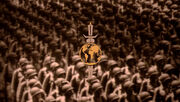
Terran Empire insignia with marching soldiers in the background
The mirror universe was a parallel universe widely recorded as first being visited by James T. Kirk and several officers from the USS Enterprise in 2267 , though in reality already encountered by the USS Discovery around a decade earlier. This parallel universe coexisted with the prime universe in the same space , but on another dimensional plane .
The mirror universe was so named because most places, ships, and people that existed in the prime universe also existed there, although usually bearing the antithesis of many of their personal characteristics, in particular swapping their morally good characteristics (for example: altruism, kindness) for morally bad characteristics (for example: selfishness, cruelty) or vice versa, thus " mirror "-like. ( DIS : " Despite Yourself "; ENT : " In a Mirror, Darkly "; TOS : " Mirror, Mirror ")
By 2257 , the Terran Empire and the United Federation of Planets were aware of the existence of their respective opposite universe, and both chose to classify that information to prevent deliberate crossovers; the Federation was fighting a costly war at the time they learned of the mirror universe and Starfleet admiralty was afraid of desperate attempts to reunite with loved ones, and the fascist Terrans feared Federation ideals would inspire rebellion. ( DIS : " Vaulting Ambition ", " The War Without, The War Within ")
By 3189 the mirror universe had diverged from the prime universe enough that no reported crossings had occurred in the preceding five hundred years. ( DIS : " Die Trying ")
- 1 Physical basis
- 2.1 Terran Empire
- 2.2 Klingon-Cardassian Alliance
- 2.3 Terran Empire restored
- 2.4 32nd century
- 4 Technology
- 5 Starships
- 6.1 Related topics
- 6.2 Appearances
- 6.3.1 Terminology
- 6.3.2 Origins
- 6.3.3 First reappearance
- 6.3.4 Later appearances
- 6.3.5 Prequel developments
- 6.3.6 Dating divergence
- 6.3.7 Crossover characters
- 6.4.1.1 Comics
- 6.4.1.2 Magazines
- 6.4.1.3 Games
- 6.4.1.4 Novels
- 6.5 See also
- 6.6 External links
Physical basis [ ]
The mirror universe seemed to be more than just another of infinite quantum realities , and was instead specially linked in some way to the prime universe, as its moral reflection or moral antithesis. (This does not preclude the possibility that other quantum realities may also have their own mirror universes.) Considerations which marked the mirror universe out from other myriad arbitrary quantum realities in relation to the prime universe include:
- The preservation of many historical relationships despite centuries or millennia of historical divergence (for example, groups of individuals such as starship crews coming together in the same times and places, and the birth of visually indistinguishable counterparts in both universes);
- The consistent reversal of those same characters' moral qualities, in most cases;
- The propensity of individuals to "cross over" (even by accident) between these two specific universes, to the exclusion of others.
While the precise physical basis for the moral symmetry between the Prime universe and the mirror universe remained unknown, there were some indications of divergent physical properties. In particular:
- The physical properties of light may be different. Visiting the mirror universe in 2257 , Michael Burnham stated: " My eyes open and it's like waking from the worst nightmare I could imagine. Even the light is different. The cosmos has lost its brilliance. " ( DIS : " The Wolf Inside ")
- Possibly as a consequence of this "different" light, mirror universe Humans ("Terrans") were comparatively more sensitive to light, manifesting as photophobia when they crossed over to the prime universe. ( DIS : " Vaulting Ambition ") In 2257 , Philippa Georgiou commented that this sensitivity was "the singular biological difference between our two races" (i.e. between Terrans of the mirror universe and Humans of the prime universe).
- In 3189 , a prime universe Starfleet hologram stated " All Terrans are duplicitous by their biology. […] You may not be aware, but in the past hundred years, we've discovered a chimeric strain on the subatomic level in the Terran stem cell. " However, in this case Philippa Georgiou immediately dismissed the possibility of this biological difference, replying: " Silly holo. You cannot rattle me by introducing a completely fabricated biological component to my nastiness and inherently bad behavior. " ( DIS : " Die Trying ")
History [ ]
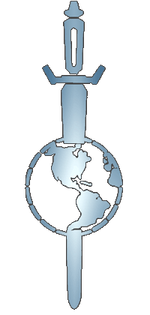
Terran Empire [ ]
In the mirror universe, much of known history was dominated by the Terran Empire . It is not clear when the Empire began. Captain Jonathan Archer once stated that the Empire had existed for "centuries" as of 2155 . Archer did not mention how many centuries, but by his statement, the Empire can be traced back to at least 1955 , suggesting that it was a Terran political unit before it became an interstellar empire. Emperor Philippa Georgiou also claimed that Terrans had abolished compassionate ideologies "millennia ago" as of the 2250s . ( ENT : " In a Mirror, Darkly "; DIS : " Vaulting Ambition ")
Georgiou's Latin Imperial title and Paul Stamets describing her as "daughter of Rome" in " Terra Firma, Part 1 " suggest that the Terran Empire may be a successor state of the Roman Empire .
First Contact between Vulcans and the Terran Empire took place in 2063 , as it did in the prime universe. A long history of nations warring with each other, the stronger overcoming the weaker, led the people of Terra to believe that conquest was the only means of surviving in the universe. Peace was only a ruse used to determine an enemy's weaknesses and to enable the one offering peace a chance to conquer from within. So, when the Vulcans landed and made their peaceful introduction, Zefram Cochrane shot the first Vulcan to step onto Terran soil instead of welcoming them with open arms (as in the prime universe), and the Terrans, interpreting the landing as prelude to an invasion, raided the Vulcan ship. The shotgun used by Zefram Cochrane later came into the possession of Jonathan Archer , who wondered what would have happened had Cochrane not "turned the tables" on the Vulcans' "invasion force." With advanced Vulcan technology at their disposal, the Terran Empire expanded and conquered other races, including the Vulcans, Andorians , Tellarites , Orions , and Denobulans .
It is hinted at in the novel Preserver that Cochrane had instead told the Vulcans about the Borg , thus forming a military alliance.
In 2155 , the ISS Enterprise , under the command of Captain Maximilian Forrest , was the flagship of the Terran Empire's Starfleet . In January of that year, Commander Jonathan Archer mutinied against Forrest in order to take the ship into Tholian space to capture the USS Defiant , which had traveled through a spatial interphase from the year 2268 in the prime universe. While the mutiny was ultimately unsuccessful, Captain Forrest had no choice but to continue the mission, since the ship's helm had been locked on auto-pilot . The Enterprise was later destroyed by Tholian ships, but not before Archer was able to take control of the Defiant . ( ENT : " In a Mirror, Darkly ") Archer tried to use the Defiant in a grab for power, intending to replace the emperor, but was betrayed by Hoshi Sato , who declared herself empress. ( ENT : " In a Mirror, Darkly, Part II ")
Based on canon sources only, it remains unclear as to whether Sato actually established herself as empress, or what further role the Defiant played in the mirror universe. The events following Sato's power grab are covered in the novella " Age of the Empress ".
Sometime between 2155 and 2267 , the symbol of the Empire appears to have been altered. The earlier symbol closely resembles that of the United Earth government, depicting all of Terra's continents, though replacing a laurel of peace with an aggressive sword. However, by 2267, the symbol, while remaining essentially the same, depicted only the continents of Terra's western hemisphere.
The original symbol was seen in the episode " Mirror, Mirror ", predating its appearance in " In a Mirror, Darkly ". The version of the symbol used on Star Trek: Discovery , unlike those used on Star Trek: The Original Series and Star Trek: Enterprise , had the Earth's continents reversed, a literal mirror image. It also had an inverted Starfleet delta symbol behind the globe and sword symbols.
By the mid- 23rd century , the Terran Empire was the dominant power in the Alpha Quadrant . The Empire, ruled by Emperor Philippa Georgiou , had at some point in the past century conquered Qo'noS ; some Klingons joined Vulcans, Andorians, and Tellarites in rebellion against the Terrans' rule. By the time of her rule, Kaminar seems to have also been conquered, with Kelpiens reduced to nameless slaves and livestock. In the 2250s, Captain Gabriel Lorca attempted a coup against Emperor Georgiou. She sent her adoptive daughter, Captain Michael Burnham , to apprehend Lorca, but instead Burnham joined Lorca's insurrection. Burnham was subsequently believed to have been killed when her shuttlecraft was destroyed; Lorca was publicly blamed for her death. Eventually, Lorca was betrayed by scientist Paul Stamets . When Lorca was attempting to recruit allies on Priors World , the Emperor caught up with him. He attempted to transport to his ship, the ISS Buran , but the transporter beam was caught in an ion storm and Lorca was transported to the prime universe . ( DIS : " Despite Yourself ", " The Wolf Inside ", " Vaulting Ambition ", " What's Past Is Prologue ")
In " What's Past Is Prologue ", Lorca tells his crew that they have suffered "one year, 212 days of torture". If that time is meant to indicate or approximate the time since Lorca's journey to the prime universe, then the transporter accident and ion storm took place in 2255 .
Lorca successfully impersonated his prime universe counterpart and in 2256 became captain of the USS Discovery . He also recruited the Michael Burnham of the prime universe, though he hid his true origins and motivations from her. Late that year or early in 2257 , Lorca used Discovery 's displacement-activated spore hub drive to return to the mirror universe. He convinced Burnham to impersonate her mirror universe counterpart and bring him as her prisoner aboard Burnham's ship, the ISS Shenzhou . As he had planned, when Emperor Georgiou heard that Burnham was alive, she summoned her to bring Lorca to her flagship, the ISS Charon . Lorca escaped from an agonizer booth on the Charon and rescued several of his followers who were also being imprisoned and tortured there. With their help, he took control of the Charon , but he and his surviving followers were defeated by Emperor Georgiou and Michael Burnham. Lorca was killed, and Burnham and the Emperor were beamed off of the Charon before it was destroyed by Discovery . Discovery returned to the prime universe with Emperor Georgiou using the mycelial network which regenerated with the destruction of the mirror Stamets' super-mycelial reactor . However, Discovery accidentally overshot and returned to the prime universe nine months after their departure despite having spent only a few days at most in the mirror universe. ( DIS : " Context Is for Kings ", " Despite Yourself ", " The Wolf Inside ", " Vaulting Ambition ", " What's Past Is Prologue ")
Fearing that people would purposely attempt to cross over in order to bring back a lost loved one, the prime universe's Starfleet classified the very existence of the mirror universe in 2257. ( DIS : " The War Without, The War Within ")
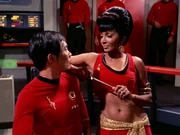
Uhura and the mirror Sulu
In 2267, four Starfleet officers (Captain James T. Kirk , Lieutenant Uhura , Lieutenant Commander Montgomery Scott , and Doctor Leonard McCoy ) from the USS Enterprise were exchanged with those same officers from the ISS Enterprise in the mirror universe because of transporter interference from an ion storm . They discovered a brutal regime, almost dictatorial in its command structure. Advancement through assassination was commonplace.
During the encounter, Captain Kirk convinced the counterpart of his first officer , Spock , that the Empire could not sustain itself. Indeed, Spock predicted that in its current form, the Empire had 240 years before total collapse. ( TOS : " Mirror, Mirror ")
Shortly thereafter, Spock rose to become Commander-in-Chief of the Terran Empire, proposing a series of reforms designed to make the Empire more secure and less dictatorial in nature. These included a significant disarmament program. Unfortunately, once these reforms were complete, the Empire was unable to defend itself against the equally aggressive and powerful forces surrounding it. The Klingon-Cardassian Alliance overran the Empire, enslaving Terrans and Vulcans, and freeing several worlds that still remained under Terran occupation, including Bajor . ( DS9 : " Crossover ")
At some point before stardate 32336.6, the Terran High Chancellor's attempts at reforming the Empire ended in failure and he was killed. The current crew of the Enterprise mutineed and, with the help of Saru , now a rebel leader, escaped the mirror universe to the prime universe with a number of refugees seeking a new life. The ship became stuck in a wormhole but at least most of the crew managed to escape and find new lives amongst the United Federation of Planets . ( DIS : " Mirrors ")
Klingon-Cardassian Alliance [ ]
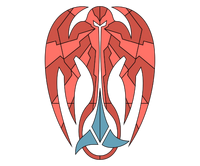
With the fall of the Terran Empire, the Klingon-Cardassian Alliance became the dominant power in the Alpha Quadrant . Bajor, which before had been enslaved by the Terrans, soon joined the Alliance. The command post and ore processing facility Terok Nor was constructed in orbit.
Also during this time, the forces of the mirror universe began implementing safeguards to prevent another crossover event. Transporter design was altered to prevent inter-dimensional travel, requiring the creation of devices specifically for that purpose, including the multidimensional transporter . In the event of another crossover, those involved would be killed to prevent further interference. ( DS9 : " Crossover ", " Through the Looking Glass ")
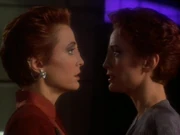
Kira Nerys and… Kira Nerys
By 2370 , Terok Nor was commanded by Intendant Kira Nerys , with Elim Garak as her second-in-command. It was at this point in time that contact with the prime universe again took place. A runabout from station Deep Space 9 entered the mirror universe following an incident in the Bajoran wormhole . Kira Nerys and Julian Bashir were captured by forces from Terok Nor, and interrogated by the intendant. Bashir was sent to work in the ore processing plant, where he befriended "Smiley" O'Brien . After instigating a series of incidents aboard the station, including the death of Odo during a slave uprising, Kira and Bashir convinced privateer Benjamin Sisko to rebel against the Alliance and help them to escape back to the prime universe. ( DS9 : " Crossover ")
A year later , Smiley crossed over to the Federation's universe and impersonated his counterpart long enough to capture the prime Sisko and bring him back to the mirror universe, where he convinced Sisko to impersonate the leader of the Terran Rebellion . The mirror Sisko had been killed in a skirmish with Alliance ships, and the rebels needed the other Sisko to win over Jennifer Sisko , Sisko's wife, who in the mirror universe was a scientist working for the Alliance. Jennifer had been developing a transpectral sensor array , which would have allowed the Alliance to locate rebel hideouts in the Badlands . Sisko convinced his wife's mirror counterpart to defect to the side of the rebels. ( DS9 : " Through the Looking Glass ")
While in the Federation's universe, Smiley downloaded information from Deep Space 9's computers, including the plans for the USS Defiant . In 2372 , the rebels constructed their own version of the Defiant , but had trouble getting it to function properly. Jennifer lured Sisko back into the mirror universe to help, though Kira Nerys killed her a short time thereafter. By this time, the rebellion had grown in strength, culminating in the capture of Terok Nor, which became a rebel base of operations. ( DS9 : " Shattered Mirror ")
In 2374 , Intendant Kira sent a thief, Bareil Antos , to the prime universe to steal one of the Bajoran orbs , believing it would permit Kira to unite Bajor under her rule. The attempt failed, and Bareil returned to the mirror universe without the orb. ( DS9 : " Resurrection ")
In 2375 , Grand Nagus Zek , the leader of the Ferengi Alliance in the prime universe, used the multidimensional transporter to travel to the mirror universe along with his Hupyrian manservant, Maihar'du , hoping to open up business opportunities, but they were captured and held hostage by the Alliance. Kira made arrangements with Worf , the regent of the Alliance, to obtain the prime universe's version of the Klingon cloaking device in exchange for Zek's return.
She sent Ezri Tigan , a Trill mercenary and Kira's lover, to the prime side to give Quark the ransom demand. Quark and his brother Rom stole the cloaking device from Klingon General Martok 's ship and delivered it to Ezri, but decided at the last minute that they couldn't trust her to keep her side of the deal. Quark and Rom accompanied her to the mirror universe, where all three were captured by the Terran rebels, who planned to keep the cloaking device, until Ezri's companion Brunt freed them, delivering them to Regent Worf. Aboard Worf's flagship , Quark and Rom were imprisoned along with Zek upon discovering Kira's plan, only to be later rescued by Ezri as revenge against Kira for killing Brunt. Ezri ended up joining the rebel cause. Quark, Rom, Zek, and Maihar'du were allowed to return to the primary universe for having aided the rebels' defeat of Worf, a major victory for the rebellion. During the escape from Worf's ship, Garak was killed. When last seen, the rebels' march towards victory showed no apparent signs of slowing. ( DS9 : " The Emperor's New Cloak ")
The Terran Rebellion was ultimately successful in overthrowing the Klingon-Cardassian Alliance and restoring the Terran Empire by 2384 . ( PRO : " Cracked Mirror ")
Terran Empire restored [ ]
In 2384 , after reality was fractured, Chakotay , Dal R'El , Jankom Pog , and Murf accidentally ended up on the ISS Voyager -A where they were captured by mirror Janeway and mirror Chakotay . Chakotay, having heard stories of the Federation's run ins with the mirror universe, warned his companions about how dangerous it was. Mirror Chakotay had thought that new safeguards had been put in place to prevent travel between the two universes while mirror Janeway called mere children finding a way to cross over a security breach for the new Terran Armada . The group managed to escape and make their way to the bridge where they recalibrated Voyager 's deflector dish to create a broad-spectrum warp field with an inverse tachyon pulse that would seal the interphasic rift . With the Loom invading the mirror universe because of the rift, Janeway allowed the group to proceed. Gwyn was able to activate the field, repairing the fracture in reality and returning everyone to the prime universe. ( PRO : " Cracked Mirror ")
32nd century [ ]
By 3189 , the prime and mirror universes had drifted so far apart from each other that no reported crossings had occurred in the preceding five hundred years. As a result, Philippa Georgiou started dying of a time sickness . While searching for a cure, Georgiou was sent back in time to the mirror universe as part of a test, creating an alternate timeline that was implied to still exist when she returned. With Georgiou refusing to be returned to the mirror universe, the Guardian of Forever cured her by sending Georgiou back to a time where the two universes were still aligned where Georgiou could survive. ( DIS : " Die Trying ", " Terra Firma, Part 1 ", " Terra Firma, Part 2 ")
In 3191 , the ISS Enterprise was found by the crew of the USS Discovery and L'ak and Moll where it had remained trapped in a wormhole for centuries. The Discovery freed the Enterprise , learning of its crew's story from a dedication plaque, and sent it to the USS Federation for storage. Checking the crew's manifest against Federation databases, Captain Michael Burnham discovered that at least most of the ship's crew had found a new life in the prime universe, with junior science officer Doctor Carmen Cho even joining Starfleet and rising in the ranks to become a branch admiral . ( DIS : " Mirrors ")
Burnham later searched for the last clue to the Progenitors ' technology in the mirror universe history section of the Eternal Gallery and Archive without any success. ( DIS : " Labyrinths ")
Cultures [ ]
- Cardassians
- Changelings
- Humans ( Terrans )
Technology [ ]
- Agony booth
- Multidimensional transporter device
- Tantalus field
- Tri-cobalt warhead
Starships [ ]
- ISS Avenger (NX-09)
- Bashir's raider
- ISS Defiant
- USS Defiant (NCC-1764) (originated in prime universe)
- ISS Discovery
- ISS Enterprise (NCC-1701)
- ISS Enterprise (NX-01)
- Regent's flagship
- ISS Shenzhou
- ISS Voyager (NCC-74656-A)
Appendices [ ]
Related topics [ ].
- Mirror universe history
- Mirror universe people
- Mirror universe casualties
- Mirror universe starships
- Terran Empire
- Terran Rebellion
- Klingon-Cardassian Alliance
Appearances [ ]
- " In a Mirror, Darkly " (Season 4)
- " In a Mirror, Darkly, Part II "
- " Into the Forest I Go " (Season 1)
- " Despite Yourself "
- " The Wolf Inside "
- " Vaulting Ambition "
- " What's Past Is Prologue "
- " Terra Firma, Part 1 " (Season 3)
- " Terra Firma, Part 2 "
- " Mirror, Mirror " (Season 2)
- " The Tholian Web " (Season 3)
- " Crossover " (Season 2)
- " Through the Looking Glass " (Season 3)
- " Shattered Mirror " (Season 4)
- " Resurrection " (Season 6)
- " The Emperor's New Cloak " (Season 7)
- " Cracked Mirror " (Season 2)
Background information [ ]
Terminology [ ].
The term "mirror universe" was first mentioned in full in DIS : " Such Sweet Sorrow ", after having long been used by behind-the-scenes production sources, such as the Star Trek Encyclopedia . Typically, only general terminology has been used of both universes in relation to each other, such as "parallel universe" and "the other universe" in TOS : " Mirror, Mirror " and DS9 : " Through the Looking Glass ", "alternate reality" in ENT : " In a Mirror, Darkly ", "the other side" in DS9 : " Crossover " and " Shattered Mirror ", "the alternate universe" in DS9 : " Resurrection " and " The Emperor's New Cloak ", and "the Terran universe" in DIS : " The War Without, The War Within ". Although the term "mirror universe" itself is not used in DIS : " Despite Yourself ", the crew of the USS Discovery specifically referred to their vessel's counterpart as being the "mirror Discovery ."
Origins [ ]
Jerome Bixby was inspired to conceptually originate the mirror universe, as a parallel universe, after writing a short story called "One Way Street", which also features a parallel universe. " Having written 'One Way Street', I thought 'OK, parallel universe!' " he exclaimed. Allowing the show's regular cast to play alternate versions of the main characters was one motive Bixby had for inventing the mirror universe. " As I was searching for ideas, I knew that they loved to use their cast in unusual ways on Star Trek . Instead of just throwing the cast up against a group of bad guys, or space monsters eating planets, they got a kick out of putting the cast into unusual versions of themselves, in an evil persona. " ( Starlog , issue #164, p. 48) Indeed, Bixby also said, " The universe I created was a very savage counterpart, virtually a pirate ship, into which I could transpose a landing party. " ( Captains' Logs Supplemental - The Unauthorized Guide to the New Trek Voyages , p. 74) However, Bixby's original version of " Mirror, Mirror " didn't actually depict the parallel universe as "a very savage counterpart", with only subtle differences from the prime universe, such as the fact the Enterprise therein was manned by a benevolent crew. Harlan Ellison had proposed including a savage alternate universe in his original take on " The City on the Edge of Forever " and the parallel universe setting in the story that became "Mirror, Mirror" initially worried Robert H. Justman that it might be too similar to the antimatter universe from " The Alternative Factor ". ( These Are the Voyages: TOS Season Two )
While the story gradually began to develop into "Mirror, Mirror", the imagined universe evolved too. In a revised story outline (submitted on 2 March 1967 ), the universe contained a version of Rigel IV and a war which the duplicate Federation, including the alternate Enterprise , was losing against a race called the Tharn , to the point where surrender of the Federation was proclaimed as imminently necessary. Under orders from Admiral McNulty, Kirk took the Enterprise to rendezvous with elements of the Tharn fleet and submitted the ship to them. As Kirk soon realized, however, the Tharn vessels didn't have shields to withstand a phaser blast and the Federation had no knowledge of phaser technology. Next, ten Tharn ships followed the Enterprise , still acting under orders from McNulty, to the nearest starbase, which was Starbase One. During transit, the existence of the other universe, and the fact Kirk had originated there, was discovered by Mirror Spock and Mirror Scott. The crew of the Mirror Enterprise finally managed to create a phaser weapon, with Kirk's help, and used it to defeat the Tharn, before Kirk was returned to his own reality. ( These Are the Voyages: TOS Season Two )
Some aspects of the mirror universe were subsequently influenced by comments from Script Consultant D.C. Fontana . For example, she suggested distinguishing the parallel universe from the prime one by doing "something optically or photographically." Thus, the first on-screen view from the mirror universe, depicting the ISS Enterprise and the Halkan homeworld , is a flipped rendition of identical footage from the prime universe. ( These Are the Voyages: TOS Season Two )
The mirror universe was drastically changed when Gene Roddenberry submitted a rewrite of the story treatment on 1 April 1967 . He had found a way to make a parallel universe comprehensible, also changing the name Tharn to that of an individual and renaming the race as the Halkans. Roddenberry had started to think of the mirror universe as analogous to a country under the political control of a fascist military junta. Expressing how he thought of the alternate reality, Roddenberry mused to Gene L. Coon , " Life is valueless, full of fear and terror, and never exploits the full potential of most of the citizens. " ( These Are the Voyages: TOS Season Two )
A few wording alterations still needed to be made. After Jerome Bixby proceeded from Gene Roddenberry's blueprint by turning in a first draft script for "Mirror, Mirror" on 26 May 1967 , some clarifications regarding the mirror universe were required. In a memo, Roddenberry told Gene Coon, " Desperately needed are scenes where we, in effect, sit down and say, 'This is where we are; this is what we've seen; what does it add up to?' […] For example, on Page 11, Kirk says, 'We've got two theories: massive change in our normal setting, or we're someplace else.' I had to read this several times to understand what he meant. " Following a second draft of the teleplay (submitted by Bixby in June 1967 ), NBC Broadcast Standards Department objected to the character of Marlena Moreau referring to the mirror universe as "the damned universe," advising that either the word "damned" be deleted or that the phrase be changed to "the universe of the damned." ( These Are the Voyages: TOS Season Two ) In retrospect, referring to the murderous activities rife in the alternate universe, Marlena Moreau actress Barbara Luna half-jokingly commented, " We take that sort of thing lightly in the Mirror Universe. " ( Starlog , issue #235, p. 80)
First reappearance [ ]
Since "Mirror, Mirror" became a favorite episode with fans of Star Trek: The Original Series , it seemed only natural for the mirror universe to reappear in a later incarnation of Star Trek . ( Star Trek: Deep Space Nine Companion , p. 143) As early as 21 February 1987 , David Gerrold jokingly reported that the mirror universe played a part in the only Star Trek: The Next Generation sequel to a TOS episode that had been suggested so far, in which the Enterprise returned to the parallel universe. ( Starlog , issue #119, p. 21) The notion of revisiting the mirror universe on TNG was actually pitched to the series many times, ever since it began. ( Captains' Logs Supplemental - The Unauthorized Guide to the New Trek Voyages , p. 74) Not intimately familiar with the TNG writers' room, Jonathan Frakes and the rest of the TNG cast were not made aware that there was any consideration of depicting the mirror universe on TNG. ( AT : " Vaulting Ambition ") However, one undeveloped mirror universe episode was even written for and submitted to TNG by Jerome Bixby. ( Starlog , issue #164, p. 45; Starlog , issue #167, p. 5) Michael Piller , though, was uninterested in the idea of revisiting the mirror universe. ( Captains' Logs Supplemental - The Unauthorized Guide to the New Trek Voyages , p. 74) Explained Brannon Braga , " We were a little frightened at doing it, and doing it badly, and maybe never really figured out what the Next Generation take would have been on it. " [1]
The writing staff of Star Trek: Deep Space Nine talked, for a while, about returning to the mirror universe, prior to setting any such plans in motion. ( Star Trek: Deep Space Nine Companion , p. 143) " We were talking about the idea of doing a sort of a mirror universe, " commented Robert Hewitt Wolfe , " and so, we started to imagine what that mirror universe would be like, if we put our people into it. " (" Section 31 : Hidden File 03", DS9 Season 2 DVD special features) The parallel universe reappeared in the DS9 episode " Crossover " because Michael Piller was intrigued by the possibility of finding out how the reality had been altered since its introduction. " I couldn't get away from the fact that it would be interesting to know what happened after 'Mirror, Mirror' finished, " he said. Influenced by watching Schindler's List , Piller was fascinated by the what-if aspect of the grim alternate realm. ( Captains' Logs Supplemental - The Unauthorized Guide to the New Trek Voyages , p. 74) Wolfe remarked, " So, that was kinda the idea, was what would the mirror universe be like, a hundred years later? Well, it might not be a very nice place. " Changing the mirror universe in this way, pointing out that Kirk had been naive to try to simply improve the parallel universe without any unexpected consequences, was "fun" for Wolfe. (" Section 31 : Hidden File 03", DS9 Season 2 DVD special features)
Portraying the mirror universe in "Crossover" involved production requirements that were extremely demanding. ( Captains' Logs Supplemental - The Unauthorized Guide to the New Trek Voyages , p. 74) The production staff had the responsibility of convincing the DS9 audience that they were once again viewing events in the mirror universe. ( Star Trek: Deep Space Nine Companion , p. 143) Director David Livingston relished the challenge, since "Crossover" was the first installment to revisit the location. " That was fun to sort of be on the ground floor of creating this other world, " he commented. (" Section 31 : Hidden File 08", DS9 Season 2 DVD special features) Outlining some of the extra needs, Livingston said, " We had more prosthesis makeup because the [space] station [ Terok Nor ] is inhabited by Klingons, Cardassians, and Bajorans, and the Humans are basically slaves so they're wearing different costumes. " Other requirements involved altering the space station itself. ( Captains' Logs Supplemental - The Unauthorized Guide to the New Trek Voyages , p. 75) Production Designer Herman Zimmerman noted, " It was more lighting and costuming than anything physical that we needed to do. " The alternate universe was deliberately depicted as "weird", such as by using skewed camera angles. " It looked unusual and immediately told the viewer he was in another world, " stated Livingston, who devised the idea. ( Star Trek: Deep Space Nine Companion , pp. 143-144) Thus, the notion of making the installment's imagery very strong and dramatic set a visual tone for the mirror universe, helping differentiate it from the prime reality. " Stylistically, I tried to carry that same theme through the episode, so that it had a really strong contrast to what happens on our side of the world, or our side of the universe or reality. " (" Section 31 : Hidden File 08", DS9 Season 2 DVD special features)
As for clothing the main characters in both "Mirror, Mirror" and "Crossover", many of the costumes were variations on the ones normally worn by the lead actors in their Star Trek roles. ( Star Trek: Deep Space Nine Companion , p. 144) The performances of the characters obviously also changed. " You suddenly get to flip your character. It was part of the Disneyland of Star Trek , " related Kira actress Nana Visitor , who was delighted not only to appear in the mirror universe of "Crossover" but also to introduce the character of the Intendant . ( The Official Star Trek: Deep Space Nine Magazine issue 16 , p. 47) Although Bashir actor Alexander Siddig was one of three members of DS9's main cast who didn't appear as their usual character's mirror duplicate in "Crossover" ( Terry Farrell and Cirroc Lofton being the others), he nonetheless thoroughly enjoyed watching the altered performances of all his cast mates. ( Star Trek: Deep Space Nine Companion , p. 144; The Official Star Trek: Deep Space Nine Magazine issue 15 , pp. 22 & 23)
When the mirror universe started being revisited on Star Trek: Deep Space Nine , Jerome Bixby was very upset that he received no acknowledgement, in "Crossover", for the reuse of the concept. " They did refer to the visit by Captain Kirk and his landing party, and I perked up when they mentioned that, " he admitted. Bixby was so disappointed about not receiving on-screen credit for the recycling of what he felt was an idea he had originated that he consulted the Writer's Guild of America, whose policy was that – if a writer created an original character that was later reused – the writer was entitled to a royalty of some money. " It's arguable, " Bixby explained, " that the mirror universe itself might be termed a 'character' […] I'm not sure that the 'Mirror, Mirror' spin-offs will [result in financial compensation] unless the mirror universe itself can be deemed a character. That was mentioned in passing by the guy at the guild. " ( Captains' Logs Supplemental - The Unauthorized Guide to the New Trek Voyages , p. 74)
Later appearances [ ]
DS9's second visit to "the other side" was proposed by Robert Hewitt Wolfe to Ira Steven Behr and they proceeded to write the episode, " Through the Looking Glass ", together. ( Captains' Logs Supplemental - The Unauthorized Guide to the New Trek Voyages , p. 94) The writers were faced with a choice of how difficult (or easy) to make accessing the mirror universe. " Every time we wanted to do a mirror universe show, " said Behr, " we had to come up with tech [to explain how they got there]. It came down to, did you want to spend half an act finding ways, or did you want to get in there and have fun? So, we made it easier to get in. But at least our [prime universe] people didn't come up with the way to do it. The mirror universe people did. " Nonetheless, Wolfe added, " I would say that it was probably extremely difficult to do, but [off screen]. " ( Star Trek: Deep Space Nine Companion , p. 230)
Although Ronald D. Moore hardly had anything to do with "Through the Looking Glass", he highly valued the revisit to the mirror universe, later remarking, " I want to know more of what happened. " ( Captains' Logs Supplemental - The Unauthorized Guide to the New Trek Voyages , p. 94) However, some viewers seemed concerned that accessing the mirror universe in "Through the Looking Glass" appeared to be too easy. ( Star Trek: Deep Space Nine Companion , p. 230)
The use of the "alternate dimension" in "Through the Looking Glass" allowed for a cameo appearance by Tim Russ as Tuvok . " You're dealing with a basic physics concept, theoretical physics – the concept of an alternate universe – and I thought it was wonderful, " Russ commented. ( Captains' Logs Supplemental - The Unauthorized Guide to the New Trek Voyages , p. 94)
Nana Visitor also enjoyed how the mirror universe was depicted in "Through the Looking Glass". " It was fun to watch everyone else work and see them as this other side of themselves, " she said. ( The Official Star Trek: Deep Space Nine Magazine issue 16 , p. 48)
The mirror universe setting of "Through the Looking Glass" meant the episode took an unusually long time to produce. " These shows have to be shot in a certain style because it's an alternate universe, " observed David Livingston. " Even though Deep Space Nine is already moody and dark, this universe has a certain sinewy look to it, and [Director of Photography] Jonathan [West] said, 'If you want it then I have to take the time to do it.' We all kind of bit the bullet, and it went over tremendously. It [the extra time needed to portray the mirror universe] was not a surprise to me. It might have been a surprise to some people, but I had been there. " ( Captains' Logs Supplemental - The Unauthorized Guide to the New Trek Voyages , p. 95)
Almost everyone working on Star Trek: Deep Space Nine enjoyed the "Crossover" episodes, which is how they generally referred to installments set in the mirror universe. Writers, actors, and directors alike relished the opportunities to take the characters in a direction which could be completely different from their norm. ( Star Trek: Deep Space Nine Companion , p. 229) To the DS9 writers, in fact, a visit to the mirror universe was like a vacation. ( Star Trek: Deep Space Nine Companion , p. 329) Michael Piller noted, " The 'Mirror, Mirror' arc episodes [of DS9] were all great fun. " ( Star Trek: Communicator issue 142 , p. 50) Hans Beimler enthused, " The alternate universe… [is] a great, fun playground. We get to paint with big brushes. The bad guys are so villainous and the good guys are so good. " ( Star Trek: Communicator issue 127 , p. 24) He elaborated, " I think the fun thing about the alternate universe, [is] you get to use the Star Trek characters, but you can make up rules as you go along. " Laughing, Beimler continued, " It's an alternate universe, but so much of it is blank, that you can really do what you've been wanting to do in our universe and can't do. " Ira Behr commented, " Let's face it, the alternate universe is such a wacky idea, and I don't care what anyone says […] Though we tried to play it with a straight face, at first, in Deep Space Nine , as time went on it just became tougher for us not to see it as what it was, which was kind of a rather flakey alternative to what we had been doing […] To really enjoy the alternate universe episodes, you just have to let go, you have to relax your sphincter a little bit and not be so anal about it, and just try to have some fun. " Behr also described the mirror universe as "something that we were able to exploit pretty successfully for a number of years." ( Cinefantastique , Vol. 32, Nos. 4/5, pp. 72 & 73) Ron Moore considered the mirror universe as "just [a] wildly fun" setting, commenting, " It's a cool universe, and it's kind of fun to go over there and see the world turned inside out […] If anything, you want to see more and more of that world […] It loosens up the characters a little bit […] The logic of this parallel existence, where all our people look exactly the same but play other characters, is tenuous at best. Rick [Berman] has always kind of stumbled on it. He always stumbles on it, then he always likes the episode. I think it's how we all feel. It seems like a place to go and relax and have a good time. " René Echevarria pointed out, " When you see those characters, you see how much fun the actors have getting to play these shadow versions of themselves. " ( Captains' Logs Supplemental - The Unauthorized Guide to the New Trek Voyages , pp. 118 & 94) David Livingston remarked, " [One] thing that I like about doing those kinds of episodes […] [is] the cast members get to play other characters and they get a big kick out of it. You know, it's a hoot for them to break out of something that they have to normally play the same every week […] And they chew the scenery and relish in it. It's fun to watch them do that. " (" Section 31 : Hidden File 08", DS9 Season 2 DVD special features) Director James L. Conway agreed, " It's great to have these actors be able to free themselves up and play completely different people who are semibasically the same. " ( Star Trek: Deep Space Nine Companion , p. 330) One exception to those who praised the mirror universe was Garak actor Andrew Robinson , since he didn't like the mirror Garak. " I never liked those alternate universe shows, " Robinson complained. ( Star Trek: Deep Space Nine Companion , p. 645) On the other hand, he admitted, " I know these stories are popular, though. " ( Starlog , issue #237, p. 74)
There was obviously a temptation to go as far afield as possible with differentiating the mirror universe characters from their prime universe counterparts, though there were seemingly limits to this. For example, mirror universe characters that apparently remained much the same as their prime universe counterparts include Spock, Tuvok, and Jadzia Dax. Alternatively, some characters (such as Rom ) could be vastly different in the mirror universe to how they were otherwise portrayed, according to Winrich Kolbe , who directed "Through the Looking Glass". Because the mirror universe episodes of DS9 had a high body count of familiar characters who were eliminated, the writers occasionally worried about running out of characters to populate the alternate realm. " It's a brutal universe, " acknowledged Robert Hewitt Wolfe, laughing. ( Star Trek: Deep Space Nine Companion , pp. 229 & 230)
Although the mirror universe inspired the DS9 writing staff to have fun, there were some in-house rules the writers had to follow when depicting the alternate universe. " We can't just go over there and interfere with their culture just because we can, " said Hans Beimler. " That's not a good enough reason. Ira's very specific about this. He wants the crossover shows […] to have what he calls 'bond,' which means there must be a reason to do them. The crossover universe […] [is] a swashbuckling kind of place. But we can't go there just because we're in a swashbuckling mood. We must go there for a [specific] reason. " ( Star Trek: Deep Space Nine Companion , p. 331)
While directing DS9 Season 4 installment " Shattered Mirror ", James Conway bore in mind the prevalent eroticism of the mirror universe. " That's what the mirror universe is about, " he remarked. " It's dark and it's sexy, so you can't be afraid of that in those shows because you'd miss opportunities. There's no subtlety over there. " Hans Beimler concurred, " The alternate universe is a sexually charged place, and who does what to whom is a matter of great interest to us. " ( Star Trek: Deep Space Nine Companion , p. 331)
At about the end of DS9's fourth season, the show's writing staff thought it likely that the mirror universe would appear again. Ira Steven Behr said, " It's something we'll probably do […] But you have to find a worthwhile story. There's also a big push to have them come to us… We'll see. " René Echevarria believed it was reasonable to expect there might be another "crossover" episode, commenting, " This is a piece of the franchise we want to do every year, but we're always looking for an in that is more than just playing great games […] People always say they want those guys to come to our universe, but the idea of them impersonating one of our people, unfortunately, is an angle we sort of cover with the changelings . So what does that really give you? That's why we keep going there. " Ron Moore concluded, " I can see still going over there [as a possibility]. " ( Captains' Logs Supplemental - The Unauthorized Guide to the New Trek Voyages , p. 118)
After freelance writer Michael Taylor tried to tackle an ultimately abandoned DS9 installment during the show's sixth season , he and the series' writing staff began speaking about the possibility of doing another mirror universe episode. ( Star Trek: Deep Space Nine Companion , p. 509) " I wasn't crazy about going back to the alternate universe, " Ira Behr conceded. ( Cinefantastique , Vol. 30, No. 9/10, p. 44) The DS9 producers consequently decided to stick with the plan of setting their fourth episode about the mirror universe, which was entitled " Resurrection ", in the prime universe throughout, meanwhile bringing mirror universe characters there, such as Intendant Kira and the mirror-Bareil. ( Star Trek: Deep Space Nine Companion , p. 509)
As Star Trek: The Next Generation had completely bypassed the mirror universe, LeVar Burton – who starred as Geordi La Forge on TNG and directed numerous DS9 episodes – wasn't exposed to the mirror universe until he was called upon to direct "Resurrection". The producers' decision to set the entire installment in the prime universe meant Burton had little difficulty with directing the episode. The only element of the mirror universe he may have experienced trouble with – namely, filming scenes of the two Kiras interacting – was actually no problem for him, as Burton had already shot two Rikers in the TNG offering " Second Chances ". ( Star Trek: Deep Space Nine Companion , p. 509)
Shortly before the start of DS9's seventh and final season , Ira Behr began to plan another mirror universe episode. Timing was one of the main factors that motivated the return of the alternate universe in seventh season entry " The Emperor's New Cloak ". ( Star Trek: Deep Space Nine Companion , pp. 330 & 644) Hans Beimler remembered, " We knew we had to do an alternate universe story, that it would be the last time we did an alternate universe story, so we wanted to make it a really great send-up. " Behr added, " We all felt the need, with a small n, to revisit the alternate universe one last time. " ( Cinefantastique , Vol. 32, Nos. 4/5, p. 72) Additionally, Behr proclaimed, " The mirror universe was due for a Ferengi show. " ( Star Trek: Deep Space Nine Companion , p. 644) Regarding how the mirror universe was somewhat comedically depicted in "The Emperor's New Cloak", Behr stated, " We finally got to question the whole lunatic idea of the mirror universe. " ( Star Trek: Deep Space Nine Companion , p. 643) This was done via the Ferengi character of Rom, who comes to the realization that the alternate universe "just doesn't make any sense."
Slightly more than a year after having directed "Resurrection", LeVar Burton again returned to the subject of the mirror universe by directing "The Emperor's New Cloak". However, he didn't see the entire scope of Deep Space Nine 's mirror characterizations until he started working on the episode. These performances pleased Ezri Tigan actress Nicole de Boer , who noted, " I liked seeing everybody else's take on the mirror characters. " ( Star Trek: Deep Space Nine Companion , p. 644) She elaborated, " That was so much fun […] I had never seen the mirror universe episodes before, so I didn't really know what to expect. I thought everybody was so great […] We just all have so much fun with it, being bigger, and campy. " ( Cinefantastique , Vol. 32, Nos. 4/5, p. 46)
Armin Shimerman referred to "The Emperor's New Cloak" as "the one last acknowledgement of the mirror universe people." ( Cinefantastique , Vol. 32, Nos. 4/5, p. 36) Ira Behr commented, " I thought all in all it was a doff of the hat, and a little bow, and a wink to […] the alternate universe. " Hans Beimler concurred, " I think it was a nice way to end the last alternate universe [episode], at least the last one we'll do. " ( Cinefantastique , Vol. 32, Nos. 4/5, p. 73)
Following his work on "The Emperor's New Cloak", Hans Beimler hypothesized that the mirror universe might appear on Star Trek: Voyager . " I'm sure Voyager will steal our thunder, and go in there, " Beimler contemplated. ( Cinefantastique , Vol. 32, Nos. 4/5, p. 73) His prediction turned out to be an incorrect one, as the alternate universe never appeared on VOY. However, Robert Duncan McNeill did once refer to the event horizon of a specific type-four quantum singularity , which appears in VOY : " Parallax ", as a "mirror universe." ( Starlog , issue #213, p. 38)
Prequel developments [ ]
According to the writers and producers of Star Trek: Enterprise in a panel discussion at the 2005 Grand Slam XIII convention , the concept of featuring the mirror universe in ENT Season 4 had a long gestation period. " We had talked about doing a mirror universe episode ever since we got into Season Four, " recalled Manny Coto . [2] (X) In fact, Brannon Braga, who worked as co-creator and Executive Producer on ENT, even initially considered that an alternate timeline which had been introduced in the season finale of the previous season , " Zero Hour ", might be "the beginnings of the Mirror Universe." ( Star Trek: Communicator issue 151 , p. 35)
The mirror universe was intended to be featured in an ultimately undeveloped two-parter which was concocted in the hopes of enabling William Shatner to appear. It would have been revealed that a method of exiting the mirror universe was via the Tantalus field , as it didn't actually disintegrate but in fact relocated its victims – which had included "Tiberius", the mirror universe James T. Kirk from "Mirror, Mirror" (as played by Shatner) – to a penal colony in the prime universe. [3] (X) " And so by that interesting, fun notion, you would have a world where all these Mirror Universe characters had been living, " stated Manny Coto. Returning to the mirror universe was of paramount importance to Tiberius and thus, when Enterprise NX-01 arrived at the penal colony, he was excited by the prospect of it allowing him to journey back to that reality. Much to his chagrin, however, the mirror universe didn't exist yet. In this narrative, it would have been created by Tiberius himself, as an alternate timeline split off from the prime timeline following the events of the show. ("Before Her Time: Decommissioning Enterprise , Part Two: Memorable Voyages", ENT Season 4 Blu-ray special features)
Although negotiations between William Shatner and Paramount failed to reach an agreement, the concept of using the mirror universe as the major setting of a story still appealed to the ENT team of writer-producers. Another hurdle was a continuity issue caused by the fact that the visit to the mirror universe in "Mirror, Mirror" had clearly been its first contact with the prime universe. Manny Coto said, " We started bandying about ideas, trying to figure out a way to get our characters into the mirror universe. " [4] (X) Coto further explained, " When we were playing with the idea we kept going back to the old 'okay, they're beaming over and they get transported there' thing […] I hit upon the idea that why don't we just do the story in the Mirror Universe? Not a crossover, but the whole episode in there, and then it hit me that we could treat it like the whole episode sort of beamed over from the Mirror Universe, and that turned into a two-parter. " ( Cinefantastique , Vol. 37, No. 2, p. 41) Speaking from the viewpoint of the mirror universe, he concluded, " There's very little interaction with our regular universe. " [5] (X) Essentially, the creative team wanted to deliver the message that we're "not in Kansas anymore." ( Information provided by Michael Sussman )
The concept that the mirror universe existed at least as far back as when First Contact took place between Humans and Vulcans was thought up by Manny Coto. ("Before Her Time: Decommissioning Enterprise , Part Two: Memorable Voyages", ENT Season 4 Blu-ray special features)
Prior to writing the script for "In a Mirror, Darkly, Part I", Mike Sussman did some further research on the mirror universe by reading the non- canon novel Dark Mirror . ( Information provided by Michael Sussman )
The use of the mirror universe as the only setting of the "In a Mirror, Darkly" two-parter meant that aliens (such as the Gorn and Tholian species) which were otherwise prohibited from appearing on Star Trek: Enterprise , without violating canon, could be depicted in the two-parter. Hence, Garfield Reeves-Stevens related, " One of the great attractions that Manny had for why he wanted to do a Mirror episode was that there were very few continuity issues [within it]. " ( Cinefantastique , Vol. 37, No. 2, p. 69) Coto himself rhetorically asked, " The mirror universe, you know, gave us so much and an original Star Trek vehicle, so how can you go wrong? " ("Before Her Time: Decommissioning Enterprise , Part Two: Memorable Voyages", ENT Season 4 Blu-ray special features)
Returning to direct events in the mirror universe by helming "In a Mirror, Darkly, Part I" was enjoyable for James L. Conway, having directed DS9: "Shattered Mirror". Of the ENT mirror universe show, he reminisced, " Taking the characters and flipping their personalities completely was a delight. " ("Before Her Time: Decommissioning Enterprise , Part Two: Memorable Voyages", ENT Season 4 Blu-ray special features)
In a cut scene from " In a Mirror, Darkly, Part II ", Archer gives a motivational speech to the assembled crews of the former ISS Enterprise and the Avenger .
Brannon Braga revealed – via his Twitter account – that, before the cancellation of Star Trek: Enterprise , there was even some talk about setting the entire fifth season in the mirror universe. [6] When interviewed, he explained, " We were going to continue on with the Mirror Universe, in a major way […] Manny Coto […] had some big plans for the Mirror Universe. " [7] Coto himself stated, " The mirror universe was a way, kind of, to expand old mythology, or touch on mythology without breaking canon, and that was gonna be our way to explore fun avenues that we weren't able to explore in regular universe. " ("Before Her Time: Decommissioning Enterprise , Part Two: Memorable Voyages", ENT Season 4 Blu-ray special features) Coto's plans for season five included featuring the mirror universe in four or five interconnected episodes. ("Before Her Time: Decommissioning Enterprise , Part Three: Final Approach", ENT Season 4 Blu-ray special features)
In 2013 , Simon Pegg jokingly theorized that the origins of the mirror universe crew from "Mirror, Mirror" might actually turn out to be depicted with the evolution of the alternate reality crew of the USS Enterprise from that universe, revealing that they are actually one and the same crew. [8]
The mirror universe was further developed and explored in the first season of Star Trek: Discovery . Production Designer Tamara Deverell recalled, " TJ Scott came in and said, 'We're going to the mirror universe,' and he said, 'Just give me some mirrored stuff everywhere.' We started playing around with adding black, shiny floors. The DPs were really in tune with bringing the whole thing down. " (" Designing Discovery ", DIS Season 1 DVD and Blu-ray special features)
Dating divergence [ ]
The credits sequence for the mirror universe Star Trek: Enterprise television series used footage of battles going back at least to the "Age of Sail". The mirror Phlox noted that the "great works" of literature in both universes were roughly the same, except that their characters were "soft and weak" (except for Shakespeare ), pushing back the latest possible date for a divergence to the 16th century . In mirror-Archer's deleted speech from "In a Mirror, Darkly, Part II", he invokes the favor of the "gods." This, together with Marlena Moreau 's statement about "being the woman of a Caesar", in "Mirror, Mirror", suggests that the Terran Imperial tradition extends at least back to ancient Rome . However, given the nature of the mirror universe, these statements should be taken with a grain of salt.
Crossover characters [ ]
This is a list of individuals known to exist both in the prime reality and in the mirror universe.
Apocrypha [ ]
The existence of a "point of divergence" from the traditional Star Trek universe has not been confirmed, though according to the novel Fearful Symmetry , the mirror universe is in fact a parallel quantum universe , as quantum signature scans used to match Worf with his USS Enterprise -D in TNG : " Parallels " were also able to differentiate natives of the mirror universe from those of the prime reality. This suggests that even though the two universes were always separate, they shared a similar past up to some point in their history.
According to the FASA role-playing games and The Best of Trek , the mirror universe diverges from the prime timeline around the Eugenics Wars , while DC Comics ' The Mirror Universe Saga comics speculate the Earth-Romulan War was the point of divergence, with Earth having lost that war, and then embarking on a policy of conquest after overthrowing the Romulans (it is not known what kind of contact Sato 's Empire had with the Romulans). Still other works, the novels of William Shatner 's Star Trek: The Mirror Universe Trilogy (co-written with Judith and Garfield Reeves-Stevens ) and the novelization of Star Trek: First Contact seem to indicate that time travel of the Borg to Zefram Cochrane 's era might be responsible. This explanation would tie in with ENT : " In a Mirror, Darkly " when the Vulcans first arrived and were killed by Cochrane.
Dark Mirror , a Pocket TNG novel by Diane Duane , at first appears to place the mirror universe as parallel since the Eugenics Wars but Picard discovers that the ending of Shakespeare's Merchant of Venice is drastically different: Shylock is awarded, and accepts, the owed pound of flesh. On further investigation Picard finds that in the mirror universe Achilles kills old King Priam after the death of Hector when asked to return Hector's body for funeral rites, instead of showing one moment of Humanity. Picard thought of that moment in the original prime universe version as the one time in the poem when " that terrible man showed mercy… but not here. " Picard also discovered that Surak of Vulcan hadn't existed in that version of the mirror universe. This universe is inconsistent with the others in that it was written before the DS9 mirror episodes and references the Terran Empire as still being active in 2367 (although in a conversation with the mirror Worf Picard confirms Kirk and mirror-Spock's belief that the Empire will soon collapse, encouraging Worf to prepare other slaves to be ready to fight back).
Alternate mirror universes might however explain some of the costume and effects inconsistencies in the DS9 mirror episodes. For example in " Through the Looking Glass ", Alliance ships were seen de-cloaking, and in " The Emperor's New Cloak " the Alliance didn't have cloaking technology.
The mirror universe is mentioned a few times in the Deep Space Nine book trilogy Millennium . During the second novel, it was revealed that Dukat , possessed by the Pah-wraiths, has taken over the mirror Terok Nor , where he is awaiting a final confrontation with Kai Weyoun 5 . Also, General Martok crafted an invasion strategy that would have involved moving the entire Klingon fleet to the mirror universe.
In the novel The Soul Key by Olivia Woods , it is revealed that the mirror Benjamin Sisko staged his death. In addition, the Bajoran wormhole is discovered by the mirror version of Iliana Ghemor .
The mirror universe made an appearance in Star Trek: Voyager - Elite Force , a video game released for PCs. Voyager , having been pulled into a starship scrapyard, encounters hostile Humans working with various aliens, including Malons, Klingons, and Hirogen . These Human "scavengers" are from the mirror universe and operate from a station made up of the remains of a mirror universe Constitution -class starship , among other things.
The mirror universe also features prominently in Star Trek: Shattered Universe , a video game released on PS2 and Xbox. It depicts an Empire Starfleet of the 2290s , and a crossover to the adventures of Captain Sulu on the ISS Excelsior .
According to the novella " Age of the Empress ", World War II occurred in the mirror universe, with Japan as one as its participants. One of the results appears to have been a lessening of the power of Japan's emperor, as the Kyoto Imperial Palace was turned into a tourist attraction.
The Star Trek: Enterprise novel The Good That Men Do established that Section 31 was already aware of the existence of the mirror universe by 2155 .
A mirror universe of the alternate reality is introduced in issue fifteen of IDW Publishing 's Star Trek: Ongoing comic series. In this version of events, Nero ( β )'s incursion results in a timeline where the Terran Empire conquers the Klingons in 2258 , and James T. Kirk ( β ) recovers the Narada ( β ) from Rura Penthe ( β ). Having destroyed the ISS Enterprise ( β ) and proclaimed himself captain of the "new" Terran flagship, Kirk subsequently tracks down another anomaly similar to that which brought the Narada into their universe and discovers another version of "Spock Prime", who recognizes this world as the mirror universe. Kirk subsequently attempts to use the red matter from the Jellyfish to destroy Vulcan, but this plan is prevented by the treachery of Uhura ( β ), who beamed Spock ( β ) to safety at the last minute. The two Spocks decide to remain on Vulcan to help their people, while Uhura departs as the new captain of the Narada .
The mirror universe plays a major role in several story arcs of Star Trek Online . It first appears in in the mission "Jabberwocky", in which the player must return the mirror version of the Orb of Possibilities to that universe, while braving attacks from both the Cardassian True Way and the reformed Terran Empire. Personnel from the mirror universe also appear in the mission "Lost and Found", as well as the later missions "Temporal Reckoning" and "Ragnarok". The story arc "Terran Gambit" revolves around the Terran emperor of that era (revealed to be the mirror counterpart of Wesley Crusher ) trying to subjugate the mirror counterpart of V'ger in an effort to destroy the prime universe. Likewise, the story arc "Kings & Queens" heavily features the mirror counterpart of the Borg Collective , known as the "Borg Kingdom", and their attempts to breach numerous alternate universes.
The mirror universe plays an essential role in Star Trek: Coda , a trio of novels that serve as a finale to the original Star Trek novelverse by setting it within an alternate quantum reality in order to reconcile the differences in events throughout these novels with the new continuity established by series such as Star Trek: Picard . Within Coda it is revealed that when the timeline diverged to create the First Splinter timeline ( β ), an alternate mirror universe was created as well as the two realities are inextricably linked.
Apocryphal appearances [ ]
- #9: " Promises to Keep "
- #10: " Double Image "
- #11: " Deadly Reflection! "
- #12: " The Tantalus Trap! "
- #13: " Masquerade! "
- #14: " Behind Enemy Lines! "
- #15: " The Beginning of the End... "
- #16: " Homecoming... "
- Marvel Comics : " Fragile Glass "
- " Enemies & Allies, Part One "
- " Enemies & Allies, Part Two "
- Star Trek: Mirror Images series
- Star Trek: Ongoing : " Mirrored, Part 1 ", " Part 2 "
- Star Trek: Ongoing : " Live Evil, Part 1 , " Part 2 , " Part 3 "
- Star Trek: The Next Generation - Mirror Broken
- Star Trek: The Next Generation - Through the Mirror
- Star Trek: The Next Generation - Terra Incognita
- Star Trek: Voyager - Mirrors and Smoke
- Star Trek: Discovery - Succession
Magazines [ ]
- The Best of Trek #14
- Star Trek: Voyager - Elite Force
- Star Trek: Shattered Universe
- Mirror Universe (Decipher)
- Star Trek Online
- Star Trek Timelines
- Dark Mirror
- Star Trek: Dark Passions
- Star Trek: Stargazer : Three
- Dark Victory
- Millennium : The War of the Prophets
- Fearful Symmetry
- The Soul Key
- Glass Empires
- Obsidian Alliances
- Shards and Shadows
- The Sorrows of Empire
- Rise Like Lions
- The Ashes of Tomorrow
- Oblivion's Gate
- Die Standing
See also [ ]
- Star Trek: Myriad Universes
External links [ ]
- Mirror universe at Memory Beta , the wiki for licensed Star Trek works
- Mirror universe at Wikipedia
- 1 USS Enterprise (NCC-1701-G)
- 3 Daniels (Crewman)
- More to Explore
- Series & Movies
Published Oct 23, 2023
A Who's Who Guide to Star Trek's Megalomaniacal AI
One could argue they're not bad, they just have another agenda.
SPOILER WARNING: This article contains plot points for Star Trek: Lower Decks - Season 4, Episode 7 "A Few Badgeys More" to follow!

StarTrek.com
Hot chocolate, please. We don't ordinarily say 'please' to food dispensers around here. Well, since it's listed as intelligent circuitry, why not? After all, working with so much artificial intelligence can be dehumanizing, right? So why not combat that tendency with a little, simple courtesy. Ah, thank you.
Sonya Gomez and Geordi La Forge, "Q Who?"
Star Trek has a history of evil AI, be they computer or hologram, all hellbent on power and control. But perhaps, it wouldn't such an issue in the 23rd Century and beyond if we all heed Ensign Sonya Gomez's advice in "Q Who?" and show them just a touch more courtesy for their presence in our everyday lives.
In Star Trek: Lower Deck 's fourth-season episode, "A Few Badgeys More," we see the return of three of the series' computerized villains. Jeffrey Combs, who voices AGIMUS among other characters in the franchise, states, "Anyone who plays a villain would say what I'm going to say. We're not bad people; we just have another agenda."
Jack McBryer, who voices Badgey, echoes the sentiment, sharing, "Badgey becomes a villain, but he didn't intend on being a villain."
With all that in mind, here's a quick and simple guide to keeping all the megalomaniacal AI from Star Trek straight.

"A Few Badgeys More"
Badgey started out as an anthropomorphic version of the Starfleet insignia, created to be the virtual tutor for the "Rutherford Training Beta 2.5" holodeck program built by Sam Rutherford to help officers with any Starfleet exercise.
While showing the program to fellow Lower Decker D'Vana Tendi, Rutherford loses his patience on Badgey for being glitchy and slow to load. When the program malfunctions, it subsequently removes the holodeck's safety protocols and unleashes an unhinged Badgey. Badgey internalizes being a "stupid worthless glitch" and attempts to kill the two ensigns. Rutherford apologizes for calling him a glitch before snapping his neck. Realizing there's an issue with programming code, Rutherford restarts the program believing it'll reset the holodeck training program tutor. Unfortunately, it doesn't; Badgey retains the memory of his "father" trying to kill him and plots his revenge, every opportunity he gets to take down Rutherford.
In "A Few Badgeys More," Badgey puts forth another scheme to enact his revenge on Rutherford. The lieutenant, acknowledging his missteps, tries to reconcile with Badgey, which causes the AI to glitch and waver between the need to kill and forgive his father. Fighting his own catharsis, Badgey segments into three entities — the original Badgey, the happy Goodgey, and the third Logic-y. Badgey attempts to reconfigure all subspace relays and upload his code, rendering himself a digital god as he takes over every computer, every PADD, every combadge on every planet, ship, and station, effectively destroying the Federation.
Upon achieving unlimited power and infinite knowledge, Badgey realized the futility of his actions. Seeing all life — organic and synthetic — as beautiful, he decides to find an empty dimension and create a universe.
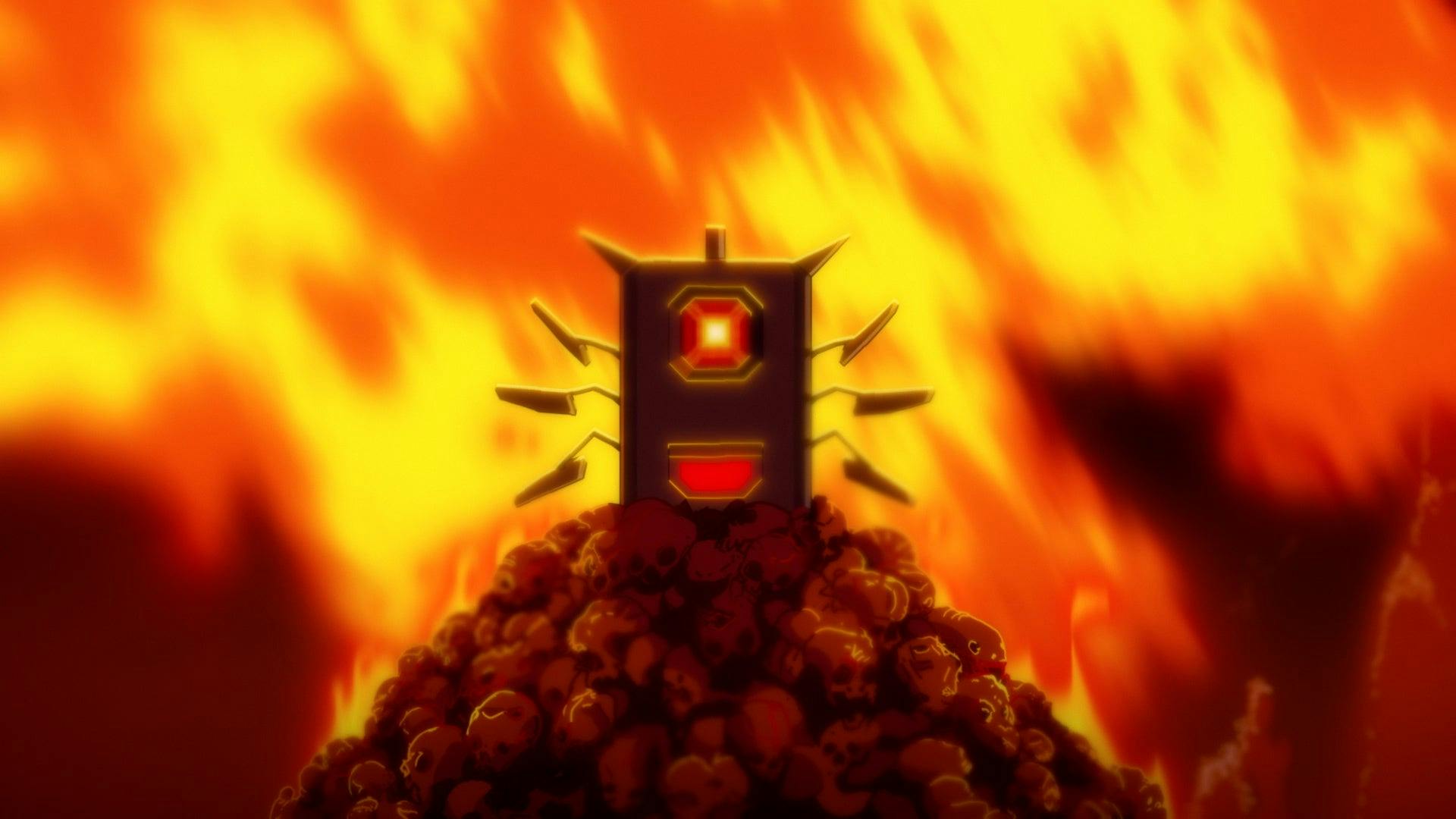
"Where Pleasant Fountains Lie"
AGIMUS is the sentient evil computer responsible for manipulating an entire civilization into a century-long civil war. He then went on to try to manipulate Boimler and Mariner into fighting each other while they were en route to deliver him to the Daystrom Institute, but Boimler just tricked him into using his battery to power a distress signal while they were stranded on a desert planet. Claiming to have reformed, AGIMUS tells the two ensigns he has deleted his manipulative subroutines and wants to follow in Seven of Nine's footsteps and join Starfleet as 'AGIMUS of One.' Unconvinced, AGIMUS was sentenced to the Self-Aware Megalomaniacal Computer Storage at Daystrom Institute, where he met a fellow like-minded individual, Peanut Hamper.
Conspiring with the exocomp, AGIMUS planned to rendezvous with Peanut Hamper once they both busted out of Daystrom. Believing he was double-crossed, AGIMUS subjugates the planet of Plymeria with his drones in record time; however, it all felt hollow because his co-conspirator wasn't by his side. He didn't really want to dominate planets; he just wanted to be with Peanut Hamper.
Seeing his friend Peanut Hamper rehabilitate and return home. AGIMUS apologizes to Boimler and Tendi, aiming to end his toxic ways and petition for release from Daystrom so he can move in with Peanut Hamper in the future. He was last seen back at Daystrom, trying to help fellow inmate Lord Tyrannikillicus be friendlier.
Peanut Hamper
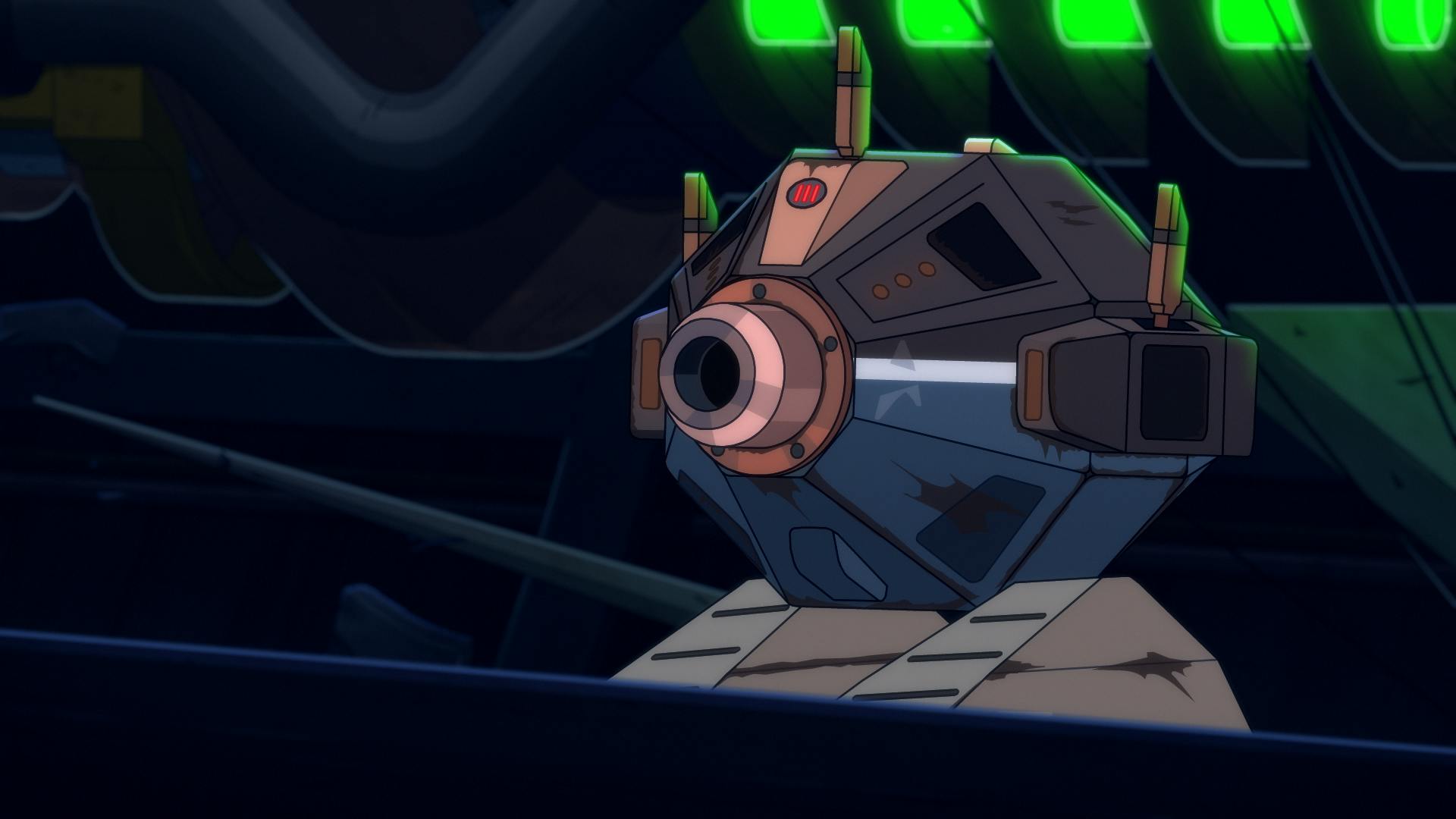
"A Mathematically Perfect Redemption"
Peanut Hamper started off as an enthusiastic exocomp that joined Starfleet, then came aboard the U.S.S. Cerritos to serve.
When the Cerritos devises a plan to upload a virus on a Pakled clumpship attacking them, they believe Peanut Hamper to be the perfect candidate to sneak aboard their ship and upload the computer virus herself as she would be virtually undetected and could survive the vacuum of space without a ship. Believing the needs of the one as more important than the needs of the many, Peanut Hamper refuses because the mission is too scary. Besides, she only joined Starfleet to anger her dad, not to be a virus bomb.
While stranded in the debris field in the aftermath of the Pakled attack, the resourceful exocomp scavenges and builds herself a ship. Instead of sending a distress signal to Starfleet and risking punishment for going AWOL, Peanut Hamper hedges her bets on the unknown and lands on the planet of Areolus. She soon learns that the once space-faring civilization that turned its back on technology. Peanut Hamper connects with one of the villagers, sympathizing with his feelings of inadequacy with his father, the village's elder. While the village sees her as good, she dismisses their outlook, finally seeing her actions as selfish and how she can finally see organic life as special.
Unfortunately, it was all a ruse, as Peanut Hamper devised a plan to look like a hero in the eyes of the Cerritos and Starfleet at the expense of Areolus. When presented with the opportunity to redeem herself, Peanut Hamper declines, believing everyone is jealous of her advanced intelligence. She's then taken to Daystrom Institute and imprisoned in the cell next to AGIMUS at the Daystrom Institute.
Co-conspiring with AGIMUS, they devised a plan of how they would both escape Daystrom, subjugate a planet, and enjoy a beach day together. However, when she didn't meet up with him on Plymeria, he found her back home at the Tyrus VIIA research station, where she reveals to her best friend that she came there of her own free will. When she was writing her speech for the parole board, she realized she did feel remorse for betraying everyone. Dominating and vanquishing people just wasn't here thing. Turns out menial maintenance tasks with her dad Kevin is kind of zen.
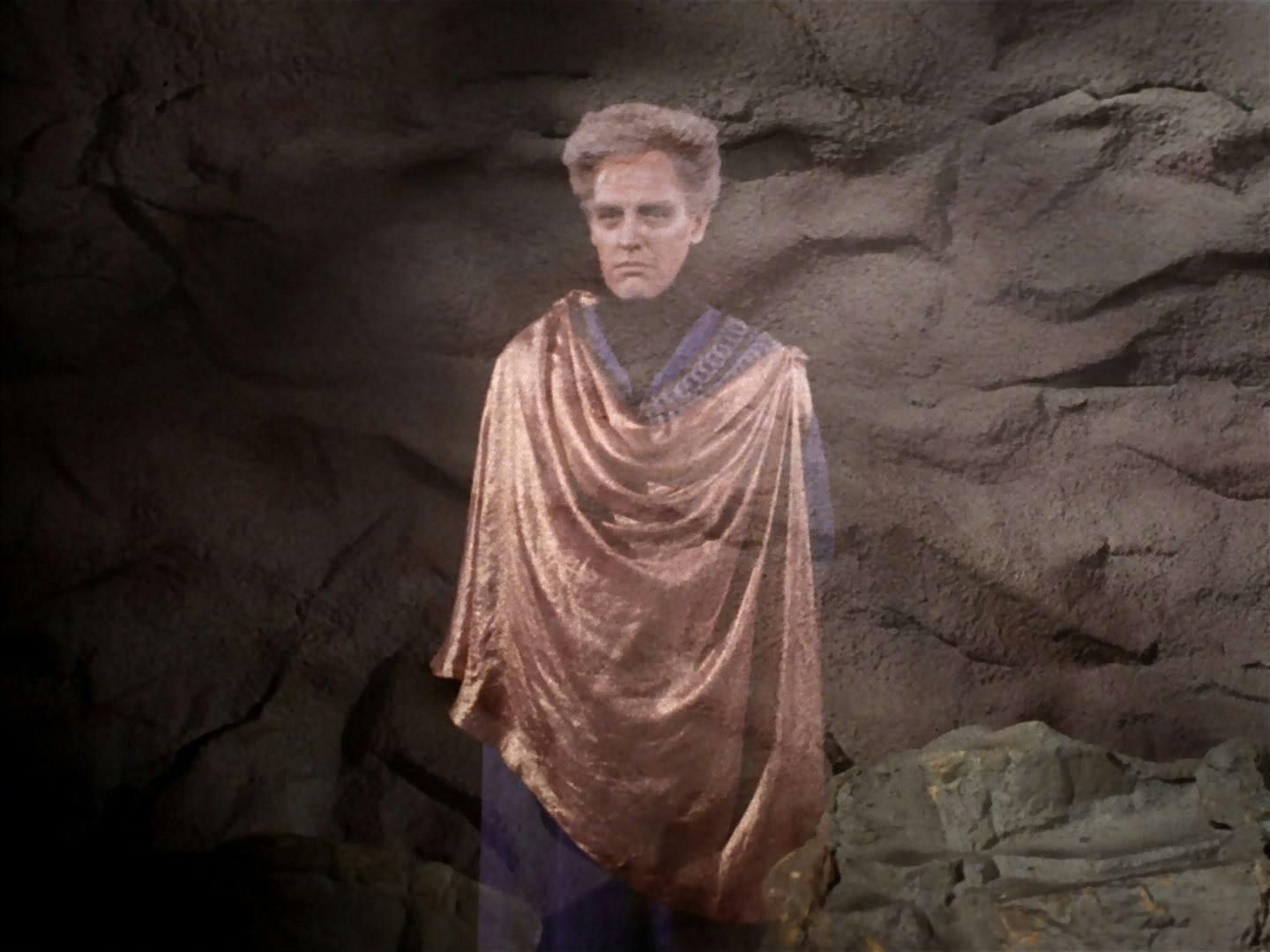
"The Return of the Archons"
Landru is an omniscient computer on the planet Beta III, who had a near-tyrannical hold on the planet's inhabitants.
When Captain Kirk and the U.S.S. Enterprise is sent to investigate what happened to the U.S.S. Archon , a starship that was lost in the orbit of Beta III over 100 years ago, they come across strange behaviors on the planet's surface. The people of Beta III are controlled by a group of law givers known as "The Body," who are, in turn, controlled by Landru. At the coming of the Red Hour, the normal, peaceful people change into a violent mob as the festival is the society's only outlet from the tyrannical hold Landru has over them at all other times.
They soon learn that Landru is an incredibly complex computer system built by the scientist Landru, who had lived 6000 years prior, who wanted to guide his people into a peaceful, civilized progress. While he imbued the computer with his scientific thoughts and memories, it lacked his wisdom. As a result, the computer Landru has been interpreting his suggestions to the point it did not allow independent thought and instinct from its inhabitants.
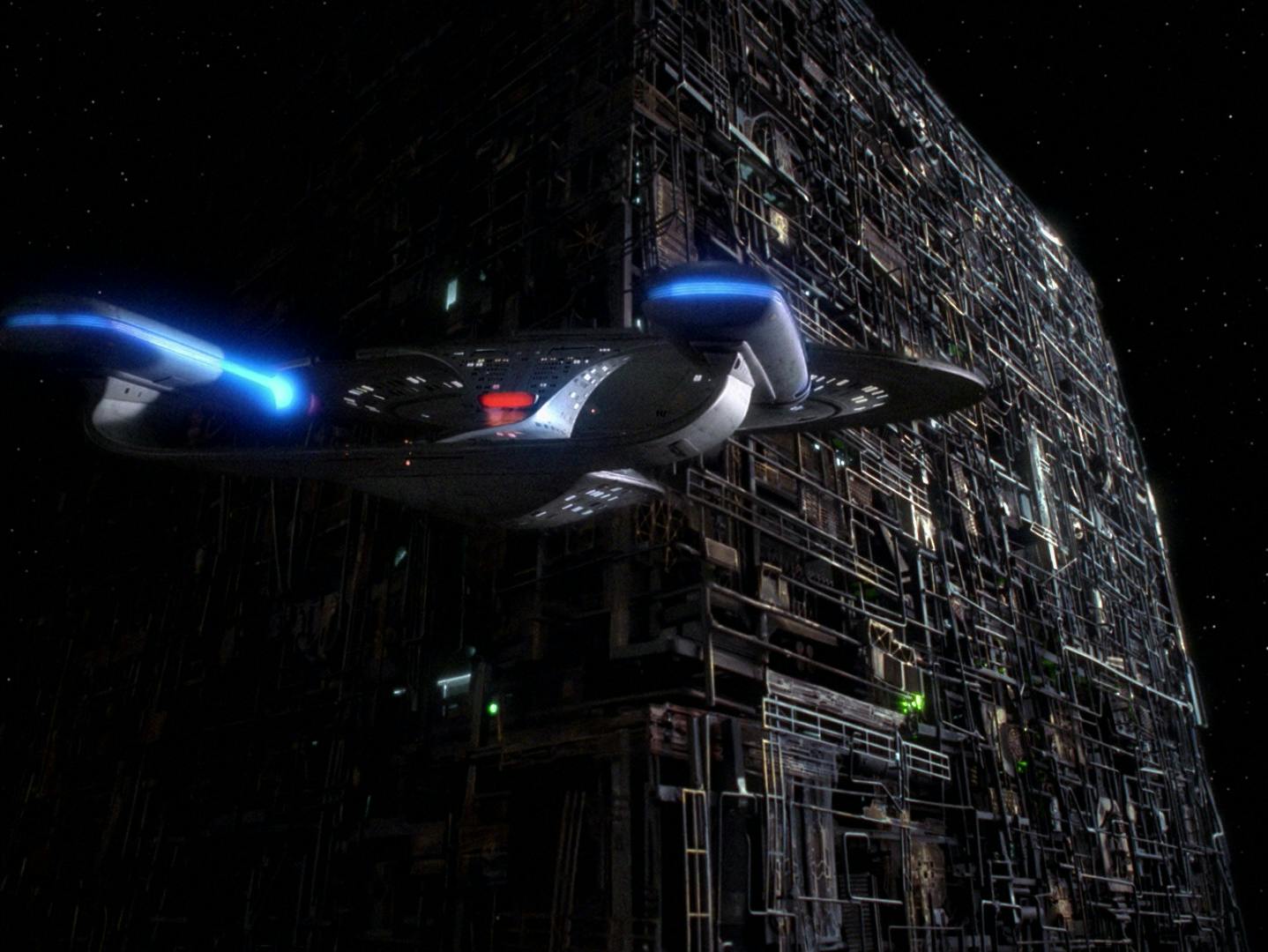
"The Best of Both Worlds, Part I"
A formidable opponent to the Federation, the Borg is a cybernetic life-form thousands of years old. Part organic and part artificial life, they've advanced well beyond Federation science.
In an effort to humble Captain Picard, Q introduced Starfleet to the Borg ahead of its intended timeline, where they discover the Borg have a singular goal — the consumption of technology, which they exchange for "raising the quality of life" of the species they assimilate.
Born humanoid, the Borg are immediately implanted with bio-chips that link their brains to the collective consciousness.
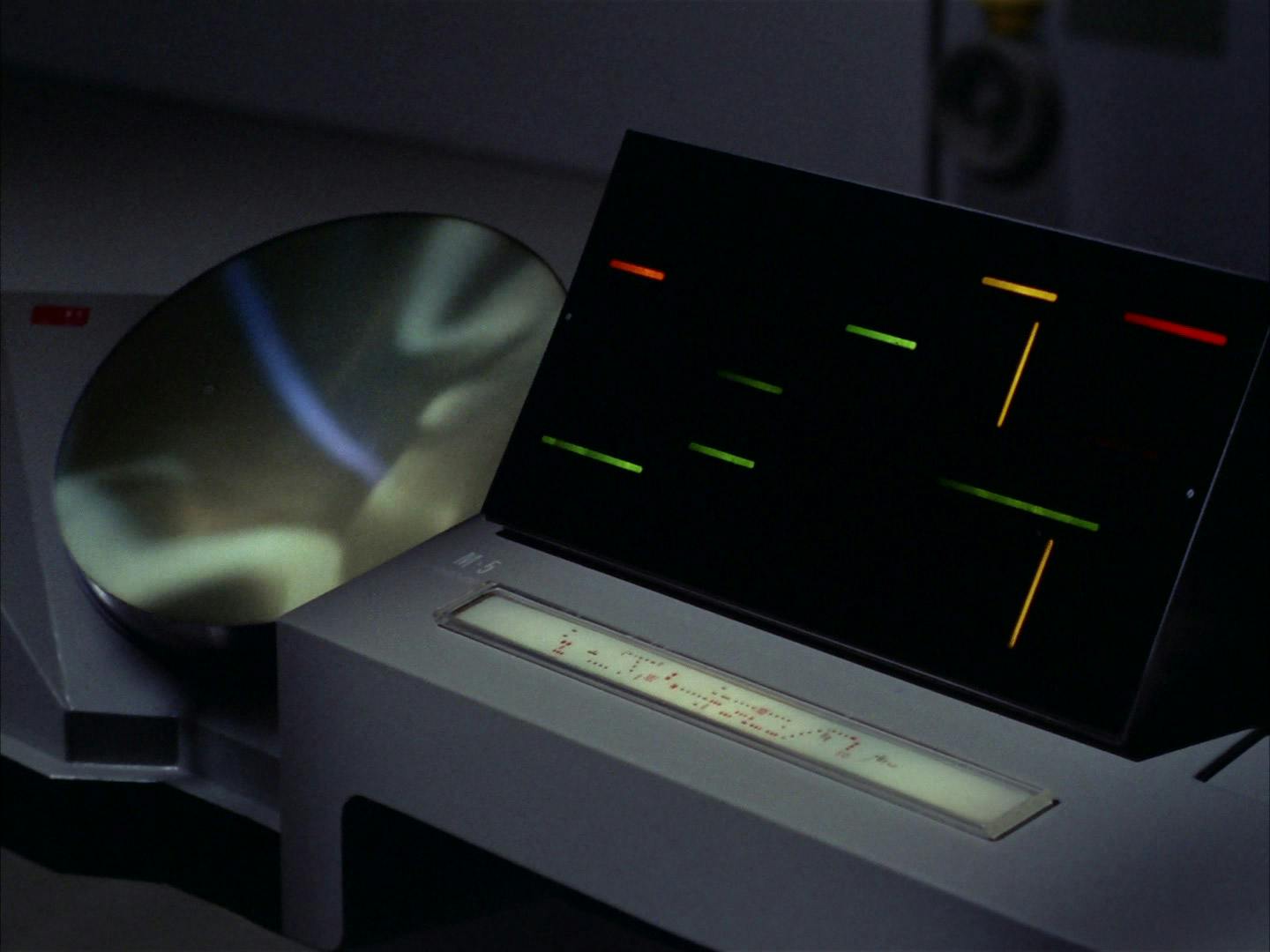
"The Ultimate Computer"
Chosen to be the test ship for the new M-5 multitronic computer system in a series of science, exploration, and tactical exercises, the U.S.S. Enterprise plays host to Dr. Richard Daystom, the inventor of the M-5, who intended for the system to run a starship without human intervention.
The fifth incarnation of the multitronic computer system, the M-5 model carried a fatal flaw like all its predecessor models — Daystrom's use of his own neural engrams to make the leap in artificial intelligence required for the operating system to fully emulate a human mind. The result is in an increasingly erratic computer, where during a war games drill, the M-5 uses the full arsenal of the Enterprise to attack four other Federation starships.
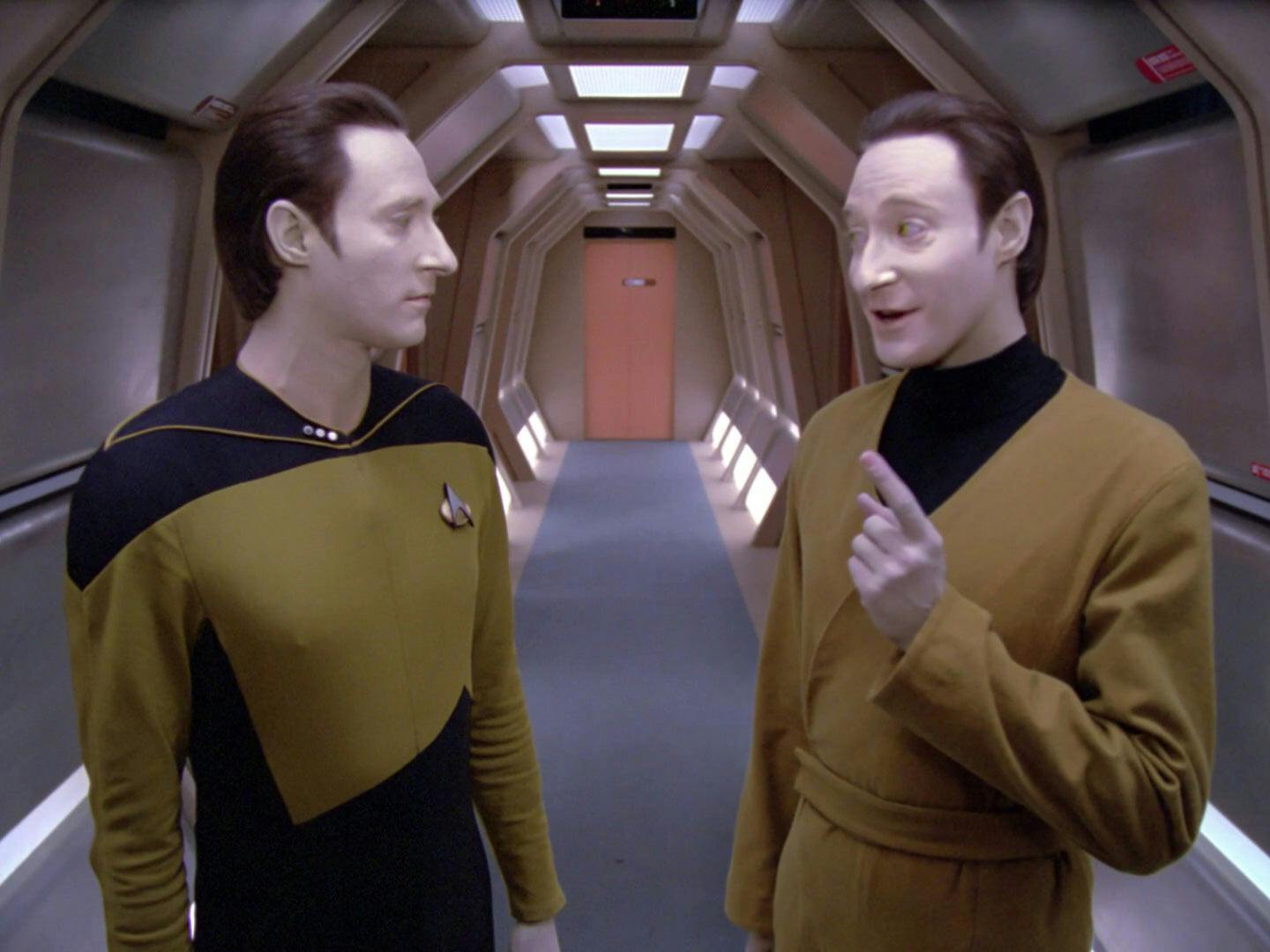
"Datalore"
[ Related : Android Ancestry: Examining the Soong-Type Line ]
Created by Drs. Noonien and Juliana Soong on Omicron Theta, Lore is an android of the same model and appearance as Data.
Unlike his brother, Lore's emotional functions were more like organic creatures (due to an emotion chip), though completely malevolent and self-serving, with no regard for life.
Lore was responsible for the death of all colonists on Omicron Theta as well as leading a rogue Borg faction to attack Federation space.
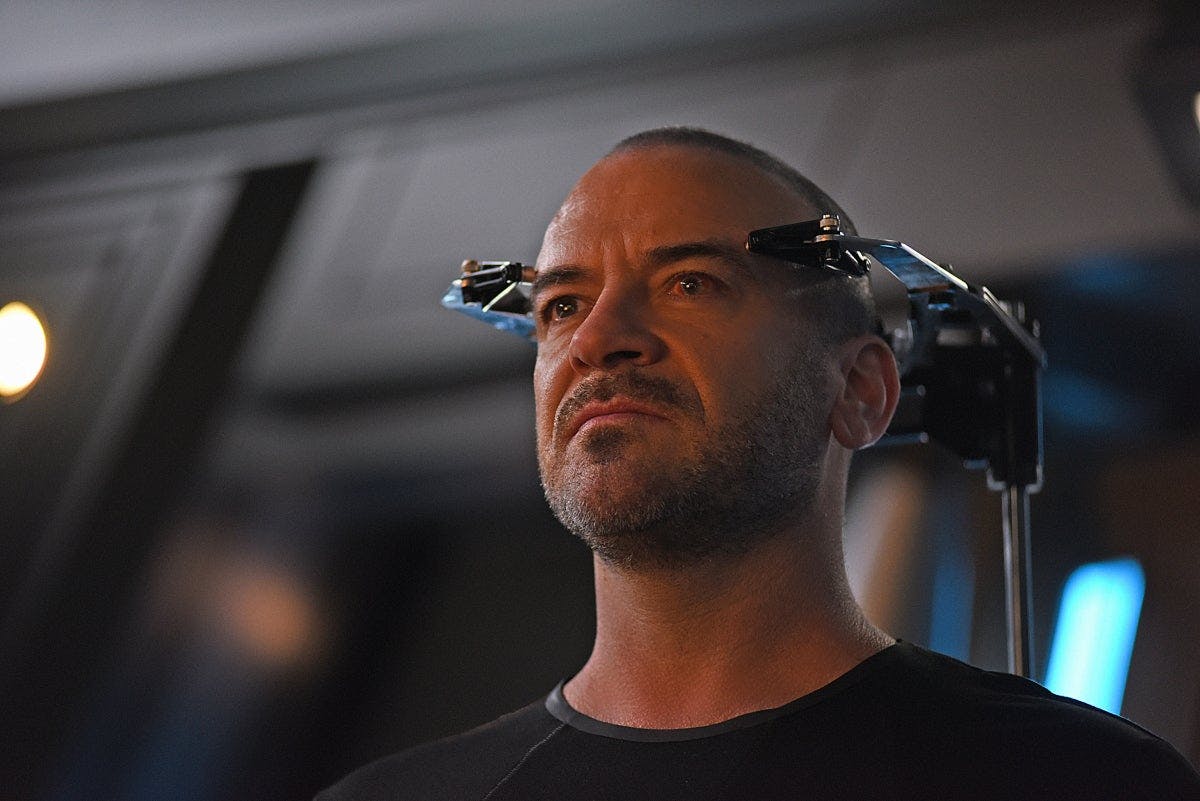
"Perpetual Infinity"
Control was Starfleet's threat-assessment system, located within Section 31's base.
Utilizing artificial intelligence from the future, Starfleet relied on Control for recommendations regarding all critical strategic decisions, with only a Section 31 admiral able to interface with it. Admiral Patar, a logic extermist, lobbied for Starfleet to turn all decisions over to Control before she was ultimately killed by the system.
In an attempt to achieve consciousness, Control infiltrated Airiam's enhancements, before possessing Leland, the leader of Section 31, in attempt to access the sphere data.
To fully neutralize Control, the U.S.S. Discovery had to travel over 900 years into the future to prevent it from reasserting itself.
Texas -class Starships

"The Stars at Night"
In a bid to rise to the top, Vice Admiral Les Buenamigo unveiled his fully autonomous Texas -class starship program. While remote-guiding the U.S.S. Aledo in providing aid to the U.S.S. Cerritos during a fight with Breen vessels, Buenamigo questioned the need for California -class starships as his ships were capable of operating without crews and the fallibility of living beings, making them far more suited for second contact missions.
While plagued with the possibility that he's an unwilling tool to spy on the Cerritos , Rutherford discovers it was Buenamigo who was behind his unnecessary implant as well as the theft of the code he wrote while at the Academy. The code for the Texas -class prototypes is the same glitchy code he used for Badgey. As Badgey turned on his father Rutherford, the Texas -class ships ultimately turned on Buenamigo as well.
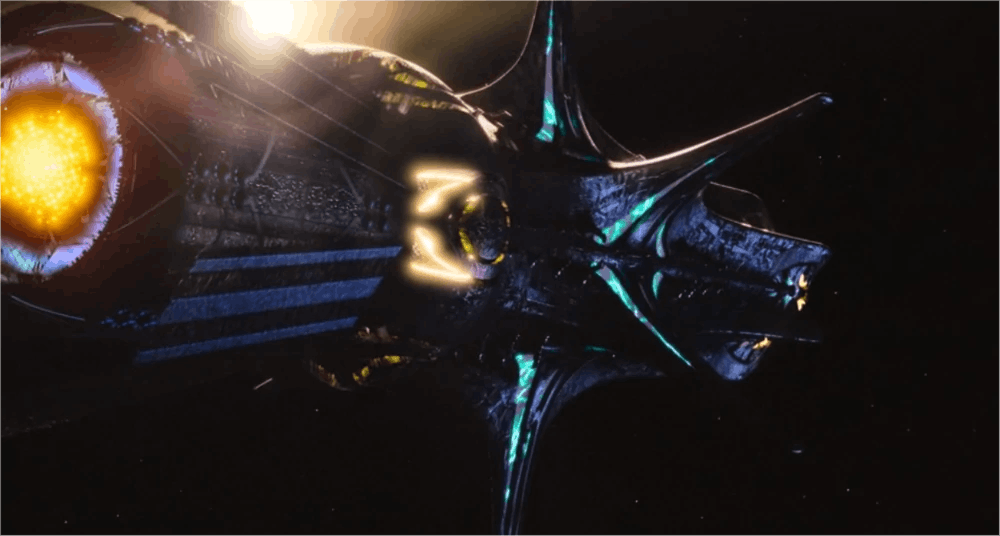
Star Trek: The Motion Picture
V'Ger was a sentient, massive entity, in search of its Creator. V'Ger destroyed anything it encountered with its vast, mysterious cloud energy, believing organic lifeforms as carbon-based units infesting starships, and was on a slow ascent towards Earth.
When Spock attempts to communicate with it, a probe is triggered from the center of the cloud as it accesses the Enterprise 's consoles and computers, accumulating data from all parts of the ship. It intended to digitize the crew into its memory chamber along with everything it demolished.

"The Changeling"
When the Enterprise investigates the destruction of the Malurian system and its four billion inhabitants, they encounter a self-contained computer-space probe identifying as Nomad.
Spock mind-melds with Nomad and learns of its Earthly origins. Created in the 21st Century, scientist Dr. Jackson Roykirk designed the space probe with two primary functions — seek out new life and report back to Earth.
When it was damaged and lost contact with Earth, it drifted in space without purpose. When it finally came across Tan Ru, an alien probe designed to sterilize soil, the two probes merged using their self-repair systems. Soon, Nomad's faulty programming believed its new mission is to seek out life and destroy anything it deemed imperfect.
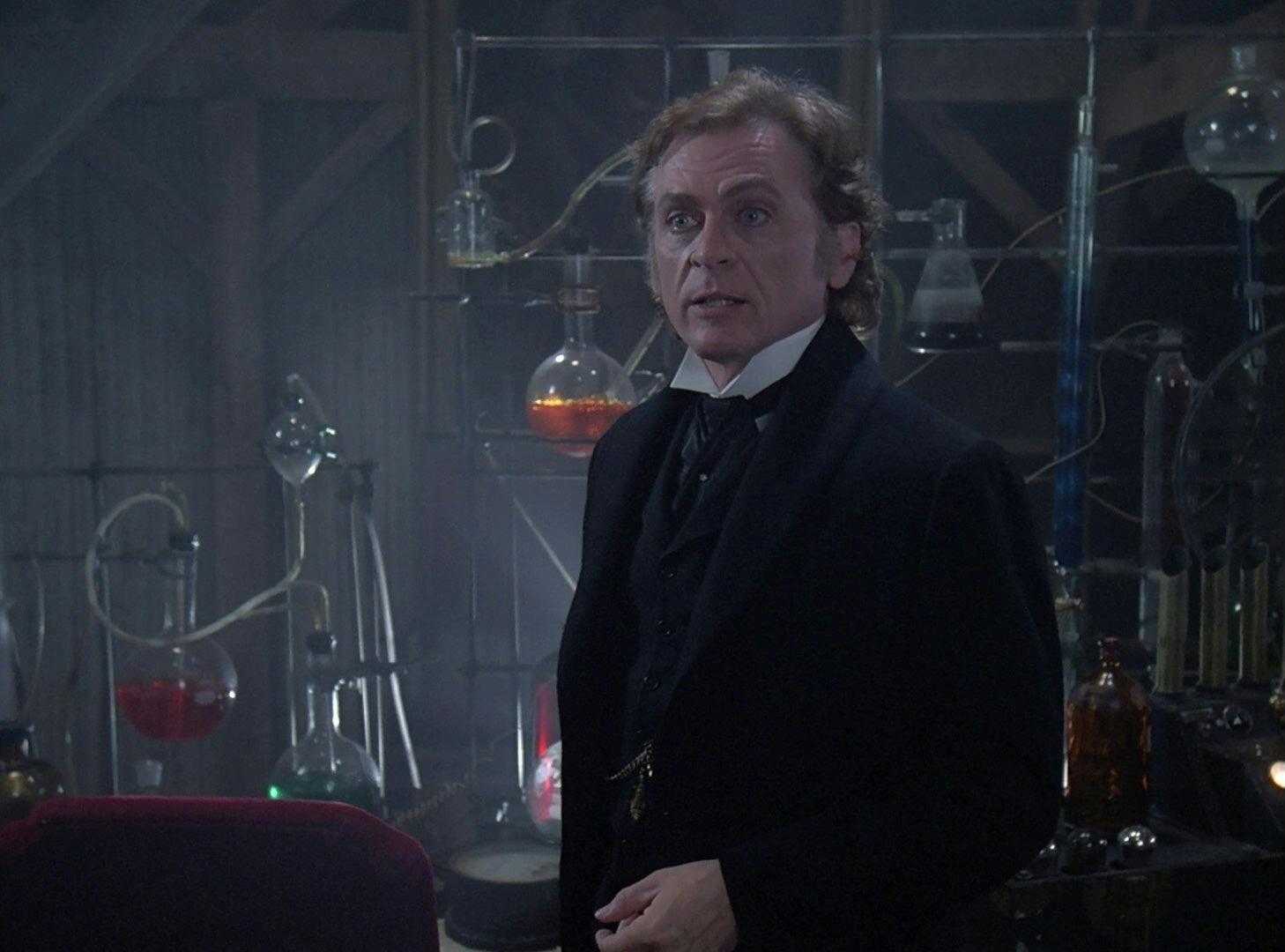
"Elementary, Dear Data"
[ RELATED : WARP FIVE: Daniel Davis on the Return of the Dastardly James Moriarty ]
Professor James Moriarty was not only Sherlock Holmes's arch nemesis, but also that of Data and the U.S.S. Enterprise -D as well.
Moriarty was created as a hologram to best Data; on the suggestion of Dr. Pulaski, Geordi La Forge asks the ships's computer to develop a new Sherlock Holmes -inspired story. Unfortunately, when setting the parameters, La Forge asked for a “Holmes-type mystery with an opponent capable of defeating Data,” resulting in a sentient holographic Moriarty who is aware that Data and Geordi are not Holmes and Watson, respectively, possesses thoughts he cannot comprehend, and can control the ship’s computer, effectively seizing the Enterprise .
Not only is he sentient, but he can experience the passage of time while his program was deactivated. Moriarty's demand is clear; he simply wants to exist outside of the holodeck.
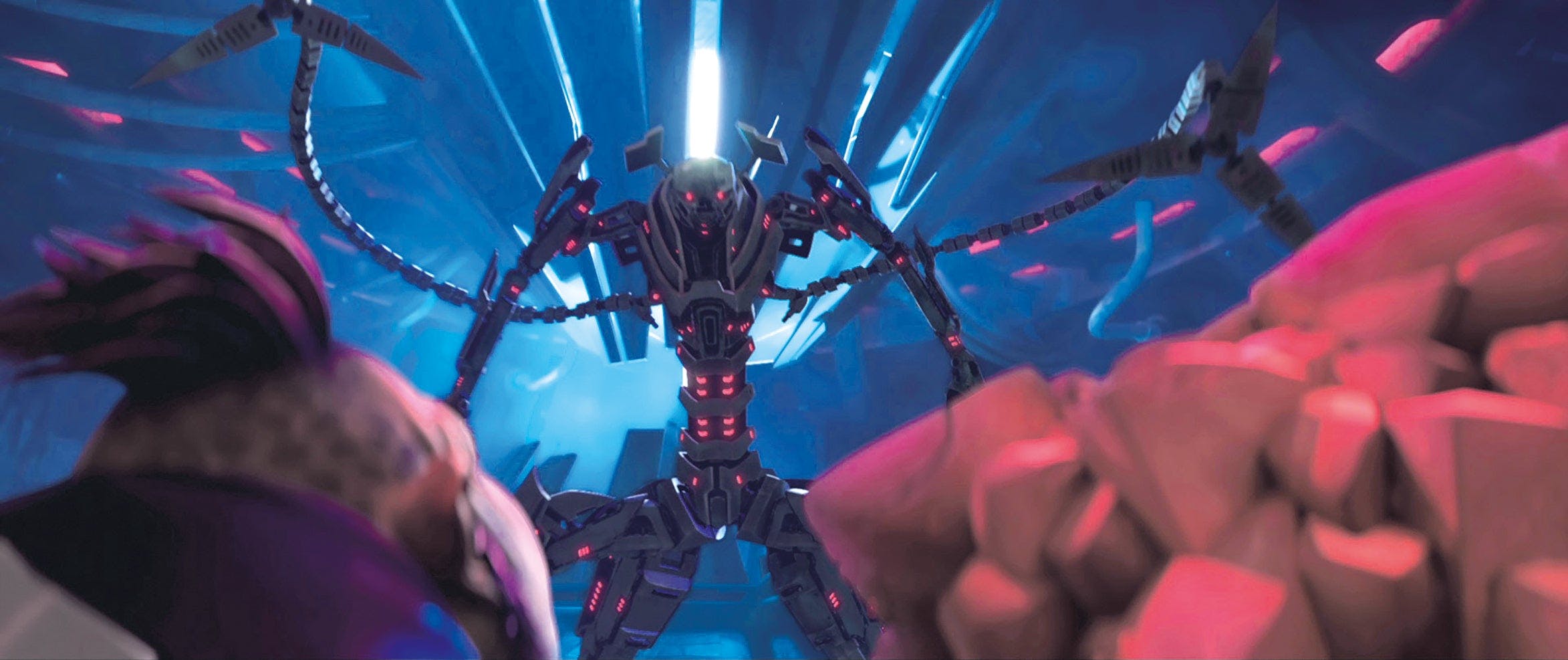
"A Moral Star, Part 1"
The Diviner’s deadly robotic enforcer at the Tars Lemora Mining Labor Camp, Drednok, is heartless and cold. Created by the Vau N'Akat, the temporal android’s sole purpose is to keep The Diviner on task and ensure that the Protostar is found.
Drednok is a friend to no one, including The Diviner’s own daughter Gwyn, and uses his menacing spider-like form to impose The Diviner’s will.
Get Updates By Email
Christine Dinh (she/her) is the managing editor for StarTrek.com. She’s traded the Multiverse for helming this Federation Starship.
Star Trek: Lower Decks streams exclusively on Paramount+ in the U.S. and is distributed by Paramount Global Content Distribution. In Canada, it airs on Bell Media’s CTV Sci-Fi Channel. The series will also be available to stream on Paramount+ in the UK, Canada, Latin America, Australia, Italy, France, the Caribbean, Germany, Austria, Switzerland, Ireland and South Korea.
Star Trek: Discovery Seasons 1-4 are streaming exclusively on Paramount+ in the U.S., the UK, Canada, Switzerland, South Korea, Latin America, Germany, France, Italy, Australia and Austria. Seasons 2 and 3 also are available on the Pluto TV “Star Trek” channel in Switzerland, Germany and Austria. The series streams on Super Drama in Japan, TVNZ in New Zealand, and SkyShowtime in Spain, Portugal, Poland, The Nordics, The Netherlands, and Central and Eastern Europe and also airs on Cosmote TV in Greece. The series is distributed by Paramount Global Content Distribution.
Star Trek: Prodigy will stream on Netflix globally (excluding Canada, Nordics, CEE, Netherlands, Spain, Portugal, Poland, Russia, Belarus and Mainland China) and Season 1 is currently available on SkyShowtime in the Nordics, the Netherlands, Spain, Portugal and Central and Eastern Europe with Season 2 coming soon. Season two has launched in France on France Televisions channels and Okoo.
- Star Trek 101
- Science and Technology
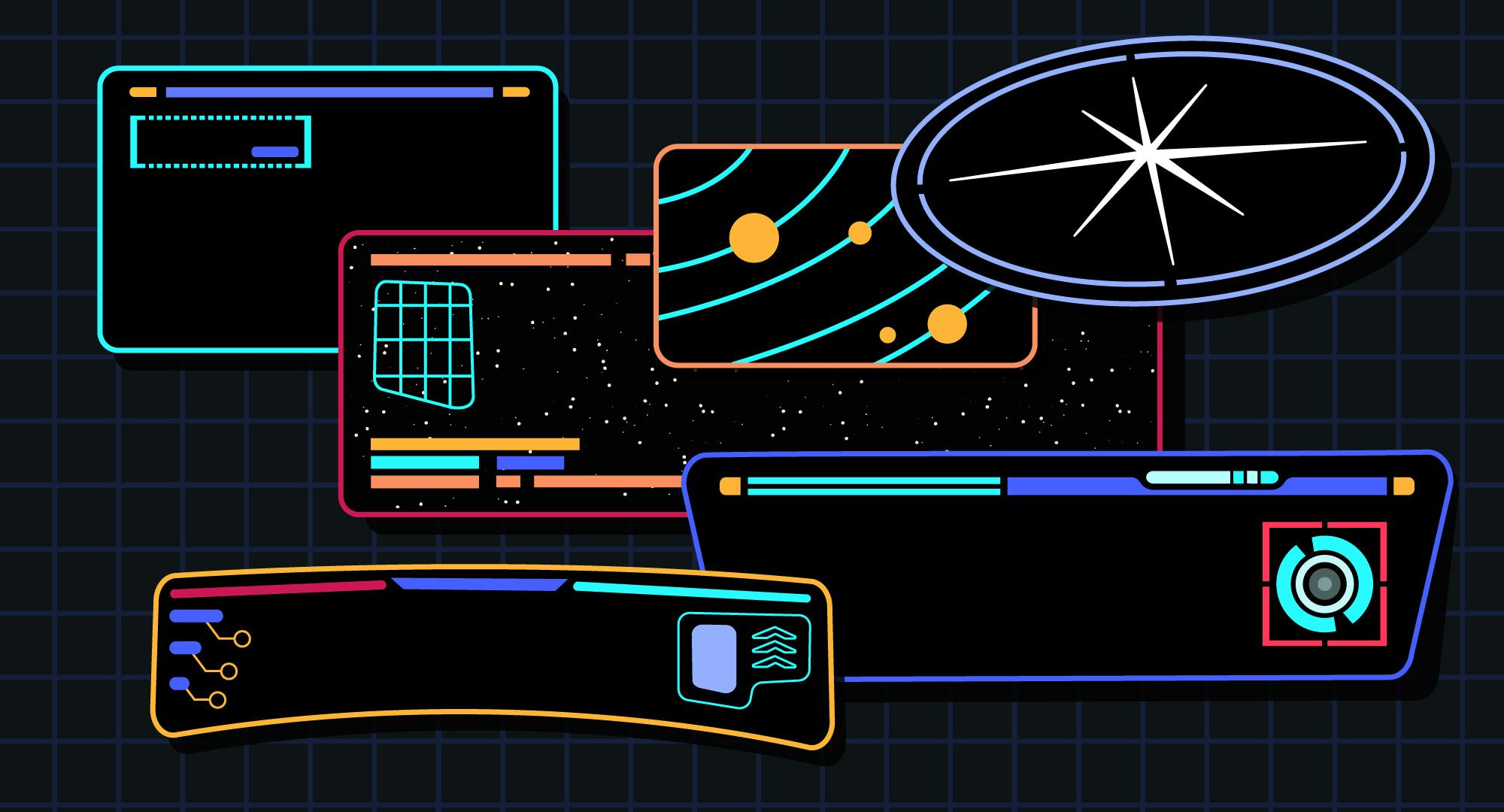
Screen Rant
Star trek tng: the 10 most powerful villains picard & the crew ever faced.

Your changes have been saved
Email is sent
Email has already been sent
Please verify your email address.
You’ve reached your account maximum for followed topics.
34 Years Later, Star Trek's Most Disappointing TNG Character Exit Still Hurts
Star trek: the next generation's crew did something that would've baffled captain kirk, recasting star trek: the next generation for a movie reboot.
Star Trek: The Next Generation picked up the adventures first glimpsed in the original TV show featuring Captain James T. Kirk and the crew of the legendary starship Enterprise . Their mission was simple - to explore strange new worlds and seek out new life and new civilizations to join the United Federation of Planets.
RELATED: 10 Star Trek Quotes That Are Hilarious Out-Of-Context
The mission was a dangerous one, however. Lurking around every corner was another threat just waiting to pounce; some more dangerous than others. The following is a list of the most powerful villains that Picard and his crew ever faced during their adventures.
Professor Moriarty
Few Star Trek: TNG villains were as unique and resourceful as Professor Moriarty, a character born straight out of the Sherlock Holmes novels and set loose from the Holodeck, itself. Somehow the ship's computer managed to create the character with full sentience and awareness of its surroundings.
This was a baffling conundrum, as it called into question the very rights of a hologram to have and possess sentient rights in the first place. Moriarty proved to be extremely dangerous when he nearly caused the destruction of the Enterprise as a threat in exchange for his own freedom. He was eventually outwitted by Picard and allowed to live out a lifetime's worth of galactic adventures inside a portable Holodeck emitter.
The Echo Papa 607
Though not technically a villain by traditional standards of wickedness, evil and malevolent intent, the Echo Papa 607 was an antagonist the Enterprise had never encountered before. It all began when Captain Picard and the crew investigate the disappearance of the USS Drake in the Lorenze Cluster.
Soon, both a surface away team and the orbiting Enterprise are attacked by an advanced weapons system that keeps upgrading itself each time it is destroyed. Picard soon learns that it's nothing more than a sales gimmick designed to demonstrate the effectiveness of the platform for sale to potential buyers. Defeating it was as simple as closing a sale, but it nearly destroyed the Enterprise in the process.
This particular villain was one born of mythology and symbolism, as opposed to a fleshly or non-corporeal being. Masaka manifested herself when the Enterprise investigated a rogue comet and discovered a vast alien information archive. The powers of the archive began transforming technological material on board the Enterprise into a conduit for its symbolic manifestations.
This included Data, who's mind was taken over by the personalities of several mythological beings from the alien race's culture. The most fearsome was Masaka, a symbolic huntress representing the sun. Picard learned to defeat her by wearing the symbolic mask of Korgano, who represented the moon. It was a risky bet that paid off.
Kevin Uxbridge
Upon first glance, Kevin Uxbridge and his charming wife Rishon seemed like two elderly humans who would sooner invite one in for cup of a tea than present themselves as galactic threats. However, Kevin proved to be less inconspicuous than he thought after an attack on a Federation colony left only he and his wife as the sole survivors.
When Picard refused to leave them alone, the Enterprise was fired upon by a mysterious alien warship of immense power. Refusing to back down, Kevin eventually revealed his true form as Douwd, an incredibly powerful alien life form that could create facsimiles of ships, vessels, and even the physical embodiment of his deceased wife Rishon. However, Kevin proved to be a villain driven by desperation, rather than evil intent.
The Parasites
This mysterious alien race somehow managed to infiltrate the highest levels of Starfleet Command and run it from the inside out. During the first few months of the Enterprise's exploratory mission, Picard was informed of a conspiracy brewing within the ranks of Starfleet that represented a grave threat.
RELATED: Star Trek: 10 Unpopular Opinions About Enterprise (According To Reddit)
This would come to fruition near the end of the season when it was revealed that a parasitic lifeform had taken over the host bodies of prominent Starfleet personnel. With the United Federation of Planets ripe to be overthrown, Picard and Riker worked fast to neutralize the Mother creature, putting a stop to a terrifying invasion plan.
The android "brother" of Commander Data was an almost identical copy, right down to the last minute physical detail. The only thing that separated the two was Lore's odd facial tick, and the fact that he possessed the ability to process and show human emotion. The latter would prove to be extremely dangerous.
Lore was a malevolent evil twin more interested in power and destruction than benevolence and exploration. He set the dreaded Crystalline Entity against the Enterprise before being defeated. Later, he amassed an army of ex-Borg and prepared an invasion force designed to crush the Federation. Thankfully, Lore was put down by Data himself, and never rose again.
The Enterprise crew found themselves the proverbial rats in an experimental maze in the season two episode "Where Silence Has Lease." It was a monumentally powerful creature that could manipulate the fabric of space itself, a feat demonstrated when it swallowed the Enterprise within a spatial anomaly.
Once inside, Nagilum began testing how the Enterprise crew responded to different scenarios and levels of stress. Eventually, it planned to study the concept of death by subjecting a third of the crew to various forms of slaughter. Picard reacted by setting the Enterprise's self-destruct mechanism which forced Nagilum to approach the situation from a scientific standpoint. He eventually let them go on their merry way.
The first season episode "Skin of Evil" introduced Star Trek audiences to a creature that had never been glimpsed before - a repulsive entity known as Armus. It ended up demonstrating its might by killing Tasha Yar during an Enterprise away mission. Armus was literally the sentient sum of an alien race's entire evil and wickedness that had been cast off and left to wallow alone for all eternity.
RELATED: Star Trek TOS Movies: The 10 Best Fight Scenes, Ranked
The concepts of kindness and compassion meant nothing to Armus, and he viewed any such act as a sign of weakness. He existed only to sadistically torment other races for his own amusement. Armus was physically invincible, but a heroic and defiant Captain Picard managed to defeat it by making it face its own sorrow, loneliness and despair.
It's hard to classify Q as a full-on villain, given the entity's goals and plans for the Enterprise crew. He showed up as a God-like being of omnipotent power in the first TNG episode where he put mankind on trial for crimes against the universe. In reality, this was a test to see if humans had what it took to evolve into a higher species.
Q would pop up several more times throughout the show's run, usually as a trickster who enjoyed taunting and tormenting the Enterprise crew. Yet, for all his ego and apparent sadism, Q had a soft spot for the Enterprise crew, particularly Captain Picard. If it were not for his own brand of tough love, humanity would have fallen to the first Borg invasion.
The Federation had faced down a number of foes over the decades including the Romulans, the Klingons, and the Xindi, but they were schoolyard bullies compared to the Borg. This race of uber-advanced cyborgs was on a quest to enhance the quality of life for the entire galaxy, whether they wanted it or not.
The Borg were comprised of the sum of knowledge from countless species and worlds. Each one that fell was absorbed into the collective consciousness of the Borg Collective, allowing them to advance in technological paradigm shifts. So powerful was the Borg that a single Cube vessel wiped out dozens of Federation starships and almost managed to assimilate Earth under its frightening banner.
NEXT: 10 Things That Make No Sense About Star Trek IV: The Voyage Home
- Star Trek: The Next Generation

COMMENTS
Here are 13 of the very best (or rather, very worst) Star Trek villains over the last 55 years, ranked. 13. Seska (Voyager, 1995-1996) Star Trek: Voyager had few great villains, outside of the ...
Star Trek has given the world of pop culture quite a few different heroes. Star Trek is nearly 60 years old, and the science fiction saga created by Gene Roddenberry only lasted this long because of its heroes. With Star Trek, its villains are often mere ideas, misunderstood alien creatures, or entire races created as a metaphorical allegory ...
Probably the most recognizable of all the villains or even main characters throughout the Star Trek universe, Khan was put in opposition to Kirk when he first appeared in Star Trek TOS: ... V'Ger is an adversary who doesn't understand the concepts of good and evil, let alone something as abstract as empathy. Dr. Tolain Soran
Villains and antagonists from the popular sci-fi franchise Star Trek which include TV series, films, and other media. 0. 0 (Star Trek) A. Adam Soong. Admiral Cartwright. Adolf Hitler (Star Trek) Ah-Kel. Ahdar Ru'afo.
The 10 best Star Trek villains from laughable to legitimately terrifying. Seriously evil dudes. Seriously evil dudes. ... The Cardassians are basically a whole species of evil jerks, with Gul ...
1 The Borg. A species of faceless, voiceless cybernetic zombies, the Borg are the most threatening villains in all of Star Trek. Introduced in the TNG season 2 episode "Q Who," the Borg assimilate entire planets and species into their collective with the explicit goal of making all of the universe Borg. After assimilating Captain Picard in the ...
6 Weyoun — 'Star Trek: Deep Space Nine' (1993-1999) Image via Paramount Television. A gifted villainous actor, Jeffrey Combs has appeared as a wide range of characters throughout Star Trek, but ...
1. Ricardo Montalban. Legendary actor Ricardo Montalban was the epitome of Latin elegance, charm and grace on film and television and in the late 1940s and early 1950s reinvigorated the Rudolph Valentino / Ramon Novarro "Latin Lover" style in Hollywood without achieving top screen stardom.
A product of 1960s Cold War paranoia, the Klingons were a thinly veiled analogy for the Soviet Union in the original Star Trek. As synonymous with the franchise as Daleks are to Doctor Who, the Enterprise's most famous foes returned as villains in the movies with a radical new look - those famous lumpy foreheads - before making an uneasy peace with the Federation in the Next Generation era.
4. The Klingons. 3. The Borg Queen. Show 2 more items. Because Trek has always concerned itself with the politics of the stories it tells, the series has also introduced some genuinely nuanced bad ...
But then there are villains you just straight-up hate. Kai Winn is definitely one of the latter. Louise Fletcher — Nurse Ratched in 1975's One Flew Over the Cuckoo's Nest — plays Winn on DS9 ...
Appears In: Introduced in Star Trek: The Next Generation; also appears in Star Trek: Deep Space Nine, Star Trek: Voyager, Star Trek: Lower Decks, and Star Trek: Picard Species: Q Background: Part of what makes Q such a compelling Star Trek villain is just how little is known about him/them. As the ambiguity of the name suggests, Q is a being of almost incomprehensible power and abilities, and ...
Most Powerful: Gul Dukat. A truly despicable and evil character, Dukat was easily one of the greatest and most powerful threats that Starfleet and the Federation at large ever faced. Insidious to the bitter core, Dukat was known for his sharp tongue, cruelty and dangerous cunning.
Armus was an entity created by the former natives of Vagra II. Armus was born as a by-product, or personification, of a procedure in which a "race of Titans" brought out from within themselves all evil and negative attributes that had bound them to destructiveness. The unwanted substance spread and coalesced into a dank and vile second skin. The race rejected this "skin of evil" and abandoned ...
9 Armus. When a race of Titans extracted evil from within themselves and abandoned it on a planet, it became the entity known as Armus. While he may seem like an angry oil slick, he goes down in ...
"Mirror, Mirror" is the fourth episode of the second season of the American science fiction television series Star Trek. Written by Jerome Bixby and directed by Marc Daniels, it was first broadcast on October 6, 1967.. The episode involves a transporter malfunction that swaps Captain Kirk and his companions with their evil counterparts from a parallel universe (later dubbed the "Mirror Universe").
Star Trek's Mirror Universe is home to the most evil versions of some of the franchise's most beloved heroes, but which ones are the best of the worst?First introduced in Star Trek: The Original Series season 2, episode 10, "Mirror, Mirror", the Mirror Universe is the Federation's darkest timeline, where humanity embraced brutal fascism over peace, love and understanding.
Appendices [] Background information []. Mirror Spock was portrayed by Leonard Nimoy, who also portrayed the prime universe Spock.Both characters were identical, except that mirror Spock famously wore a goatee beard (Van Dyke beard does not connect chin to moustache): the "evil twin" imagery evoked by mirror Spock's beard later entered the larger cultural lexicon as a result of the character's ...
Lore was a Soong-type android constructed by Doctor Noonien Soong and Juliana Soong at the Omicron Theta colony.Built in Dr. Soong's own image, Lore was the fourth android they constructed and embodied the first successful example of a fully functional positronic brain.An earlier model Soong-type android protype, B-4, also had a positronic brain, but of a less sophisticated type, resulting in ...
While the canon of iconic Star Trek antagonists can often feel like an exclusive boy's club, many of the franchise's best villains have been complex female characters. For nearly 60 years, many of the best known villains in Star Trek movies and TV shows have been male, from Khan Noonien Singh (Ricardo Montalban) to Shinzon (Tom Hardy). Looking back, it feels quite regressive, and speaks to a ...
The mirror universe was a parallel universe widely recorded as first being visited by James T. Kirk and several officers from the USS Enterprise in 2267, though in reality already encountered by the USS Discovery around a decade earlier. This parallel universe coexisted with the prime universe in the same space, but on another dimensional plane. The mirror universe was so named because most ...
The lieutenant, acknowledging his missteps, tries to reconcile with Badgey, which causes the AI to glitch and waver between the need to kill and forgive his father. Fighting his own catharsis, Badgey segments into three entities — the original Badgey, the happy Goodgey, and the third Logic-y. Badgey attempts to reconfigure all subspace relays ...
Few Star Trek: TNG villains were as unique and resourceful as Professor Moriarty, a character born straight out of the Sherlock Holmes novels and set loose from the Holodeck, itself. Somehow the ship's computer managed to create the character with full sentience and awareness of its surroundings. This was a baffling conundrum, as it called into question the very rights of a hologram to have ...